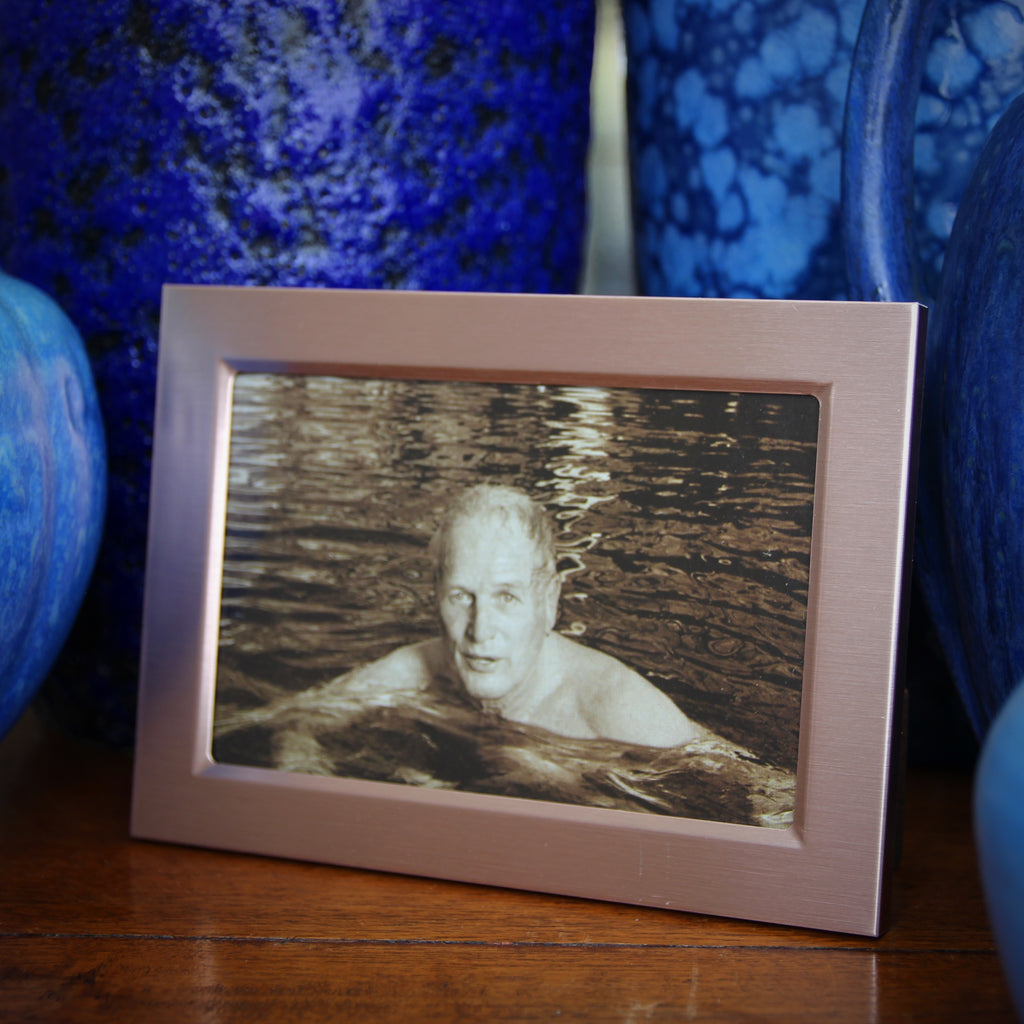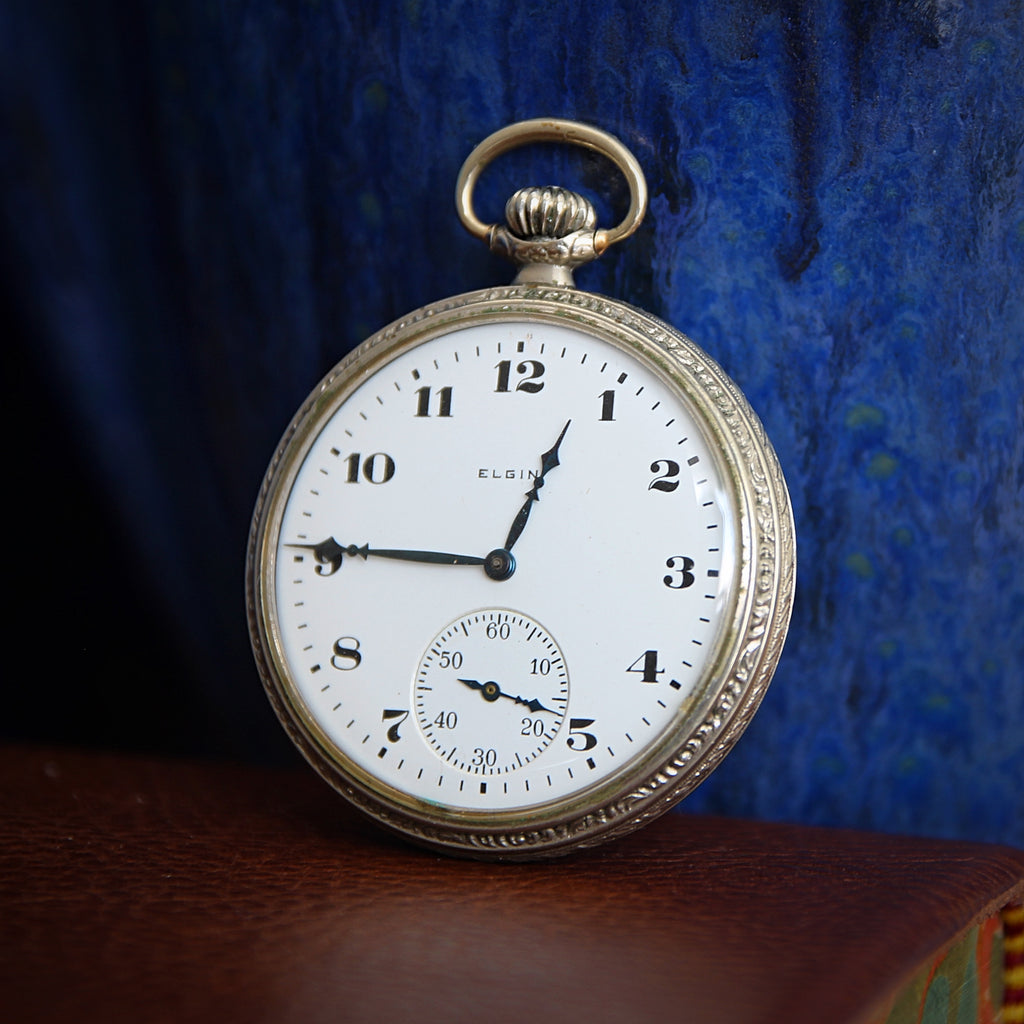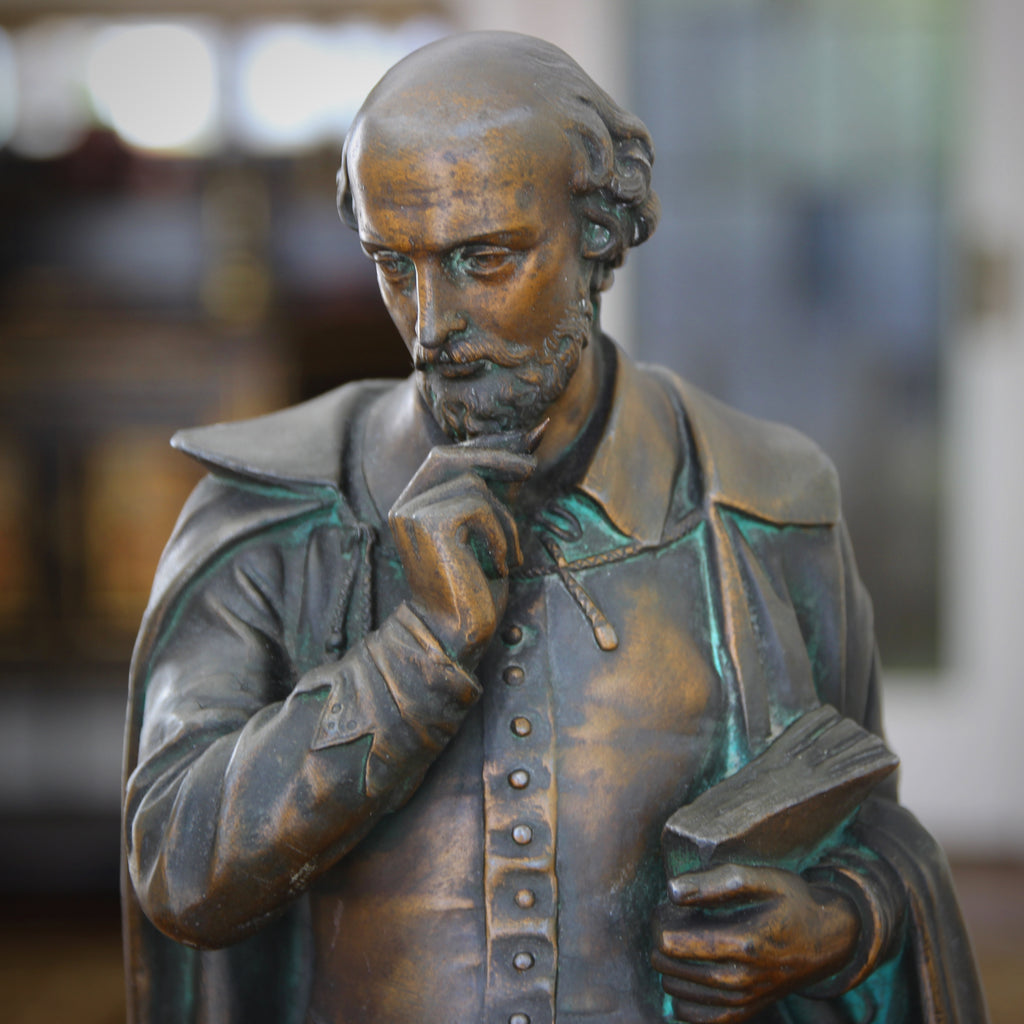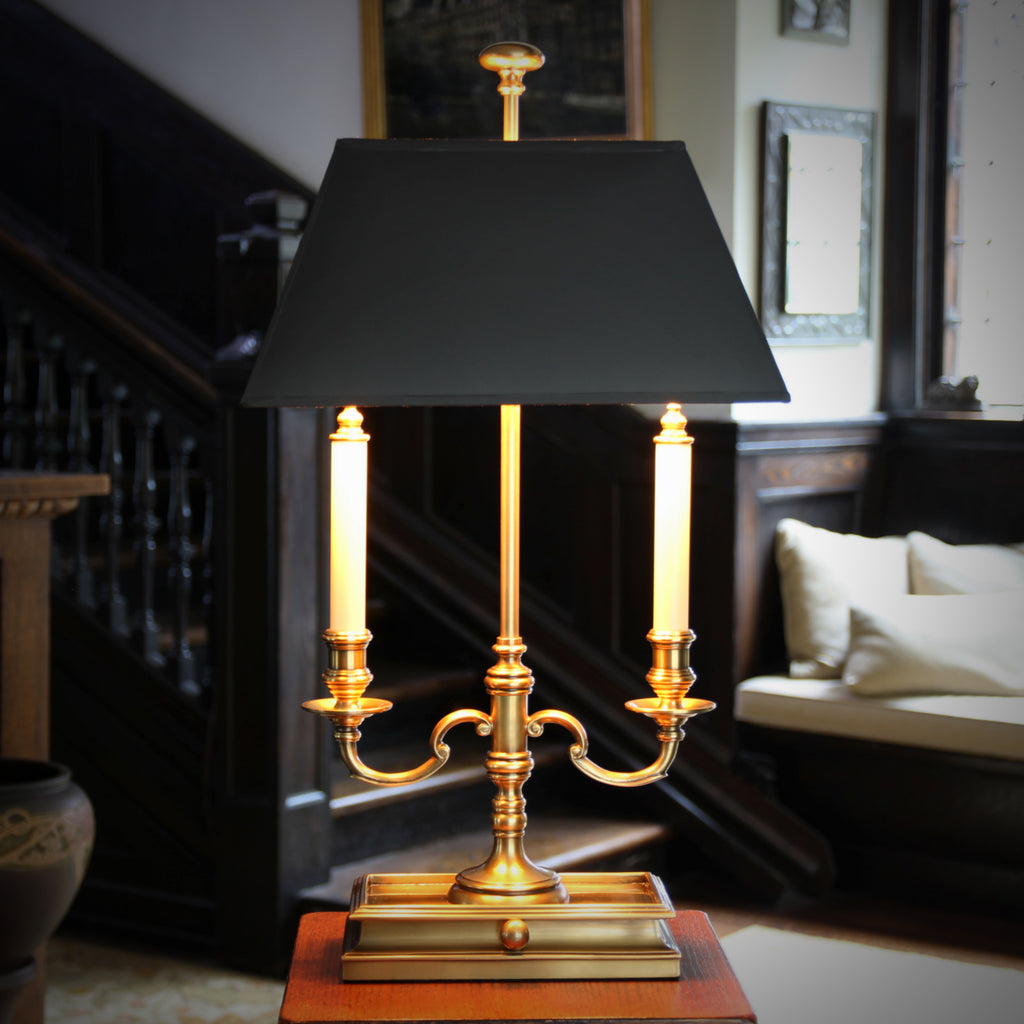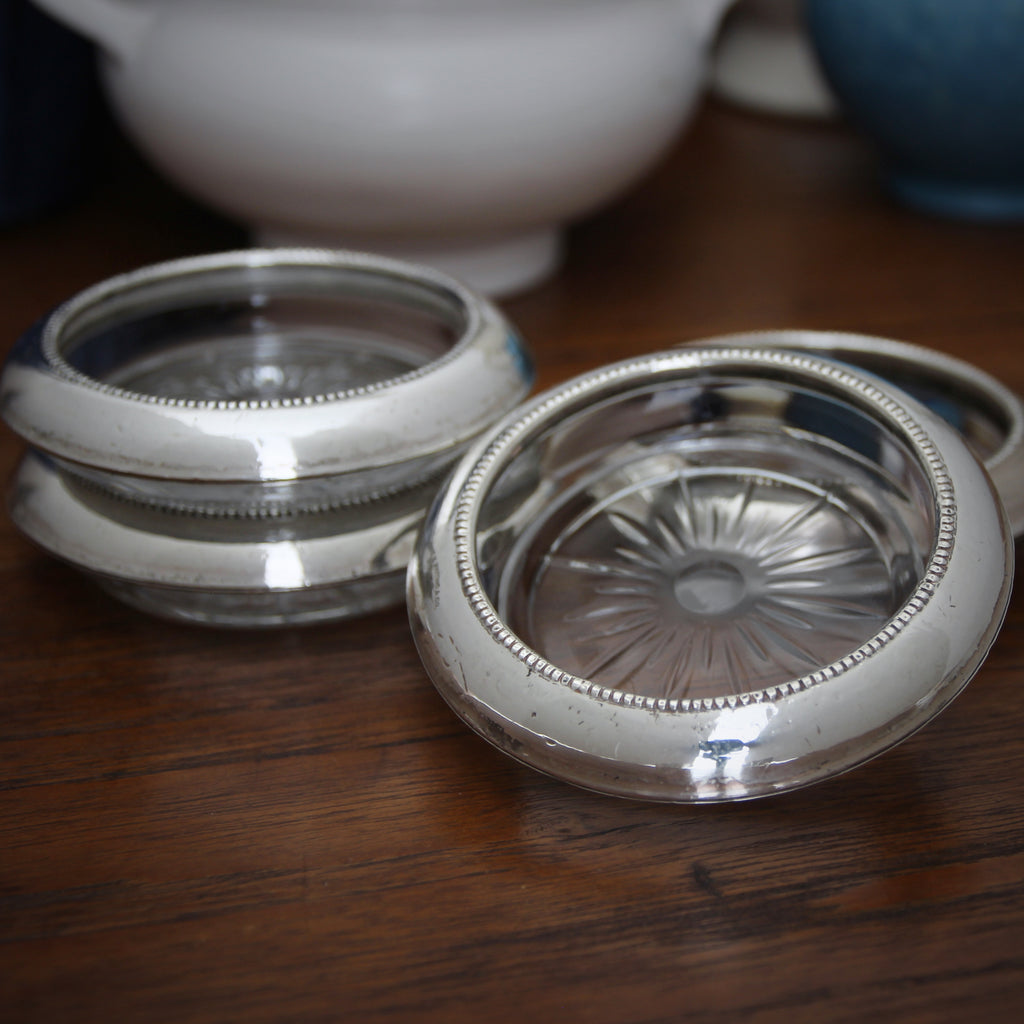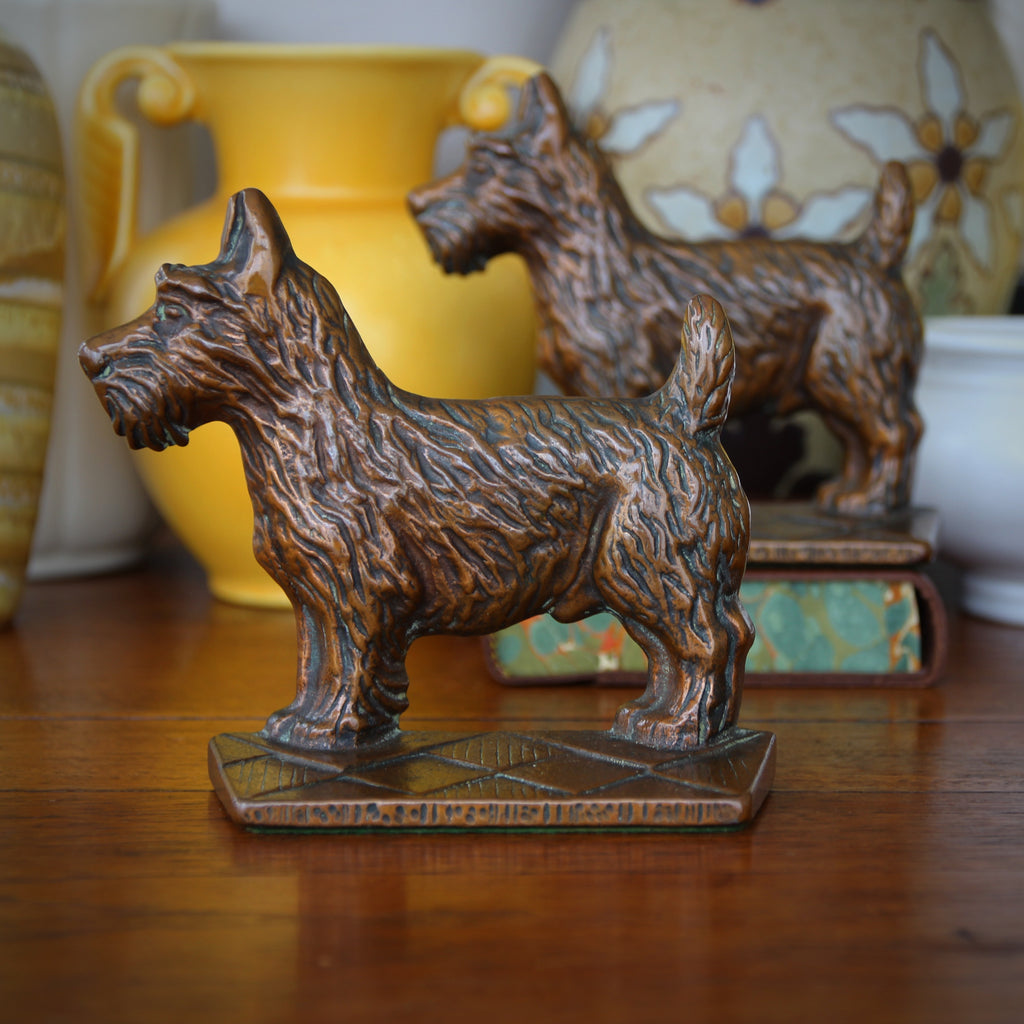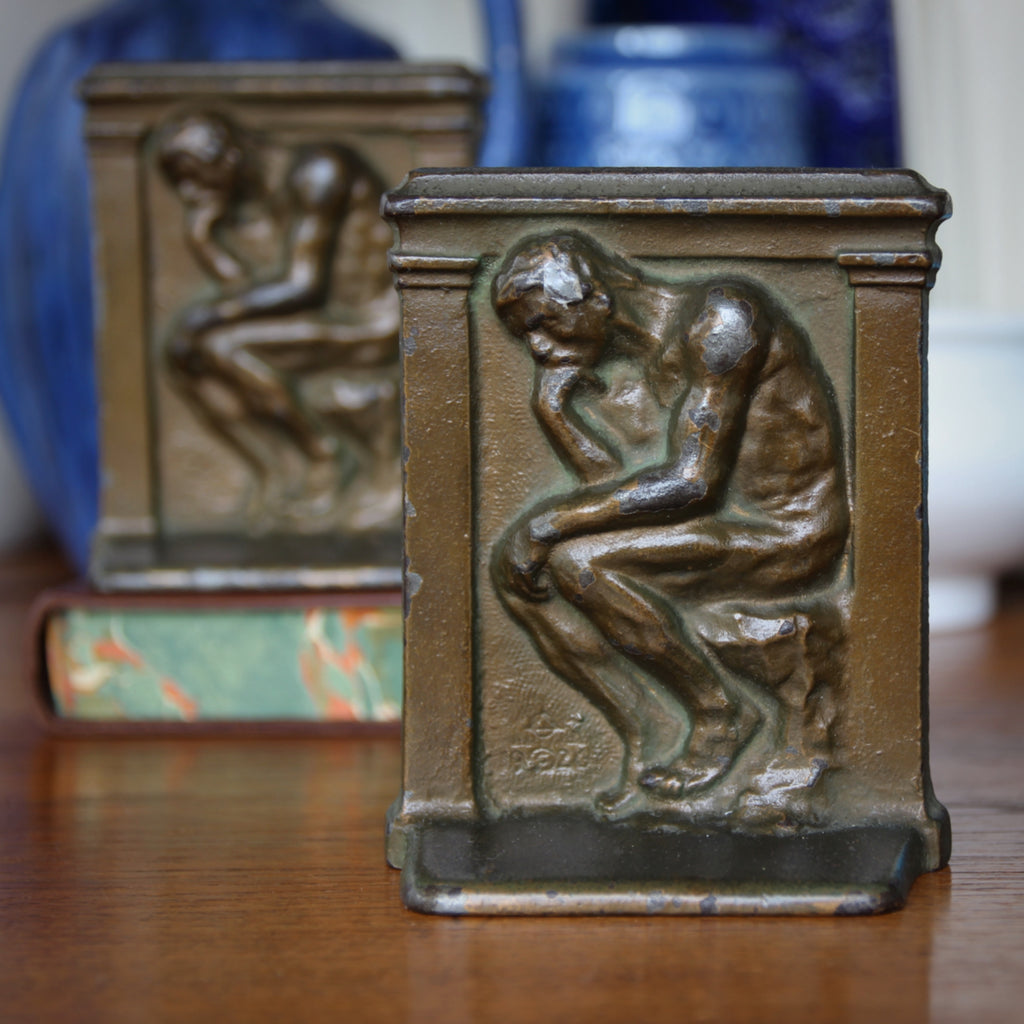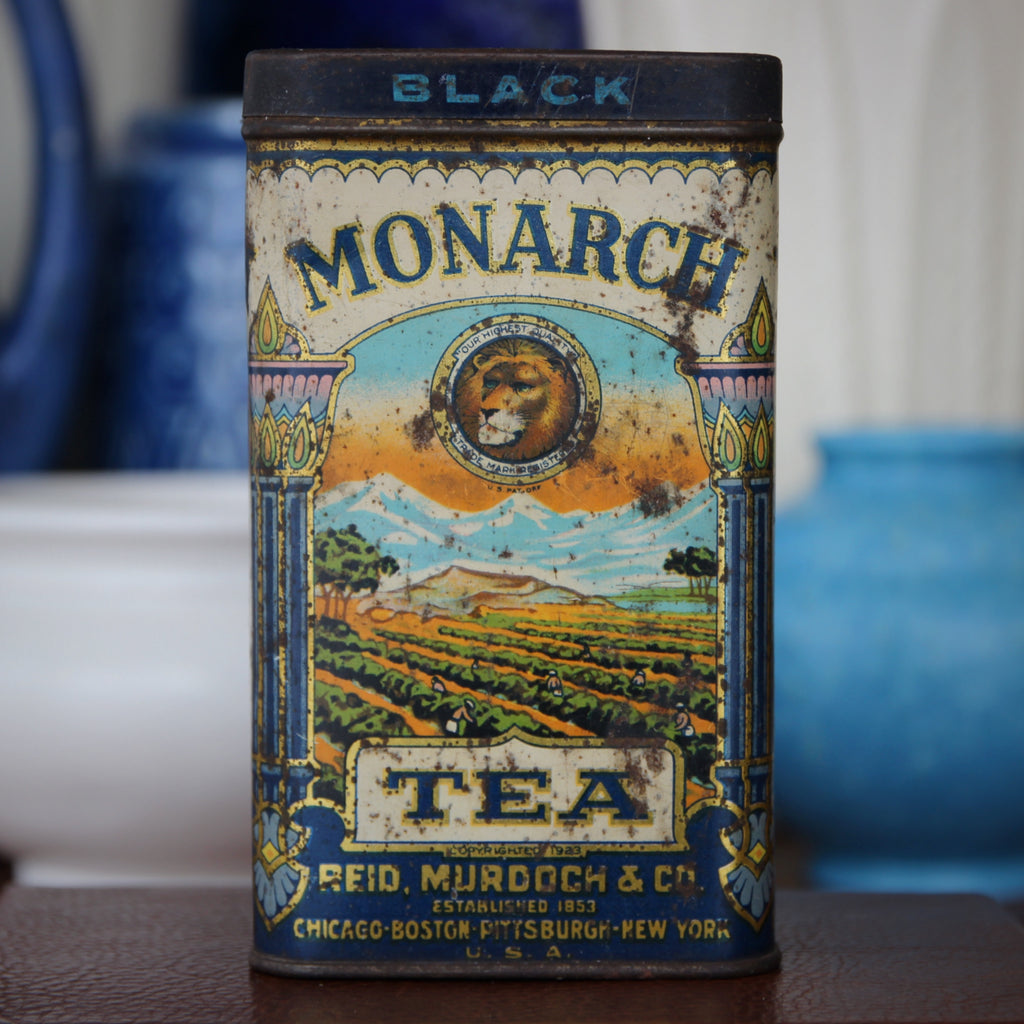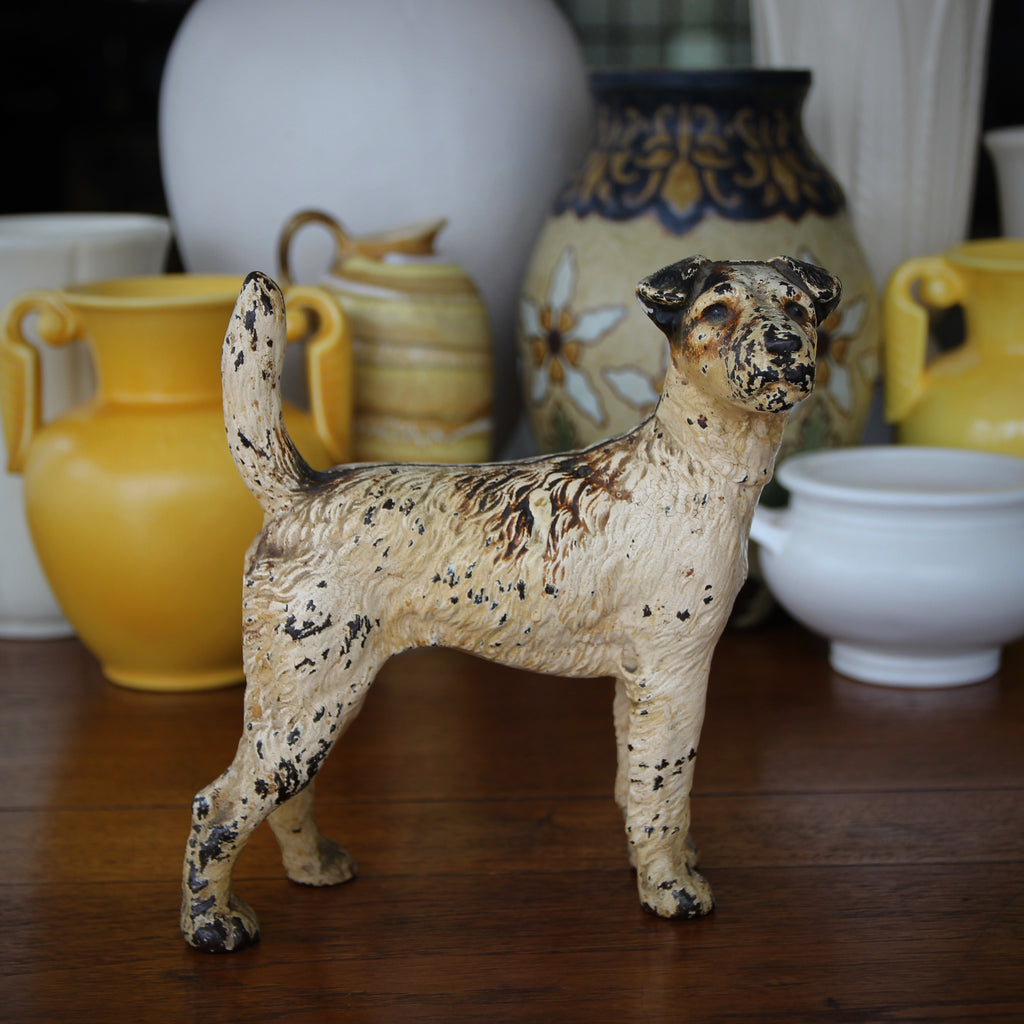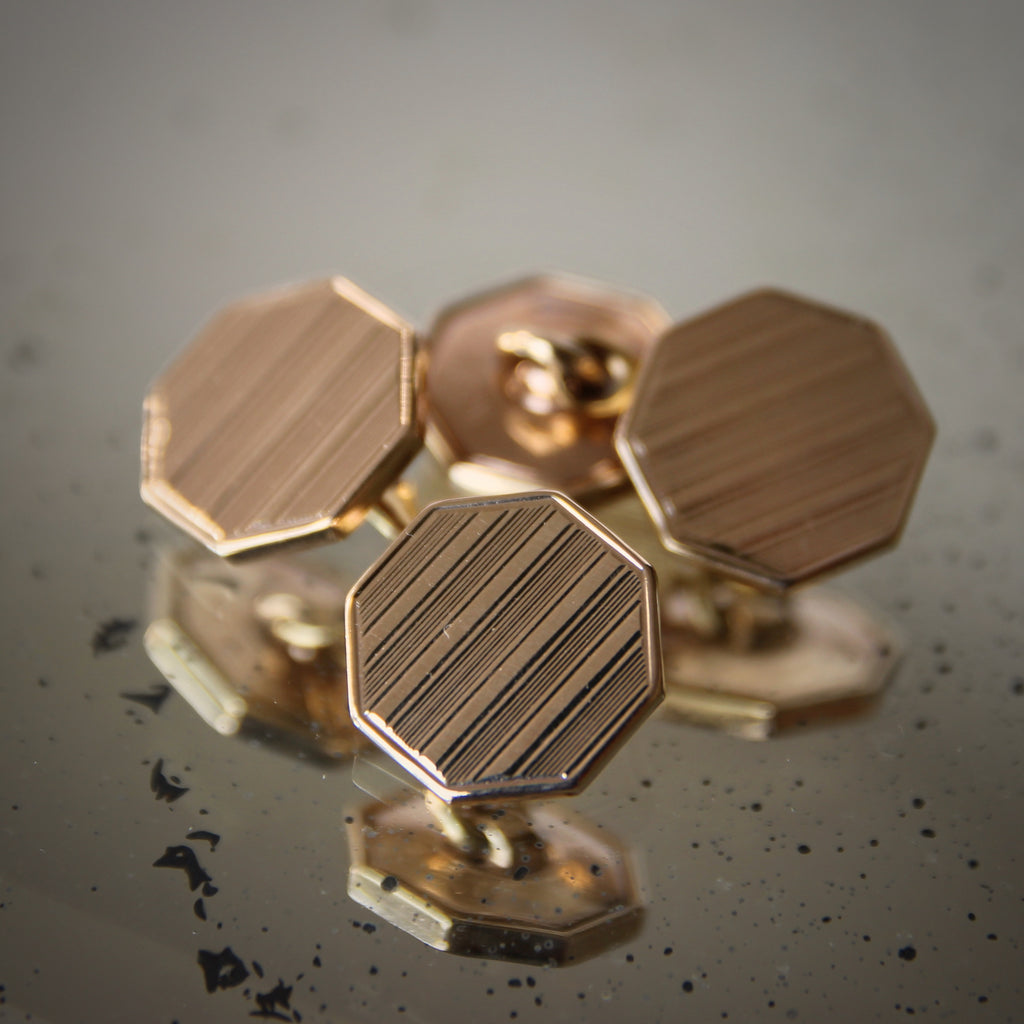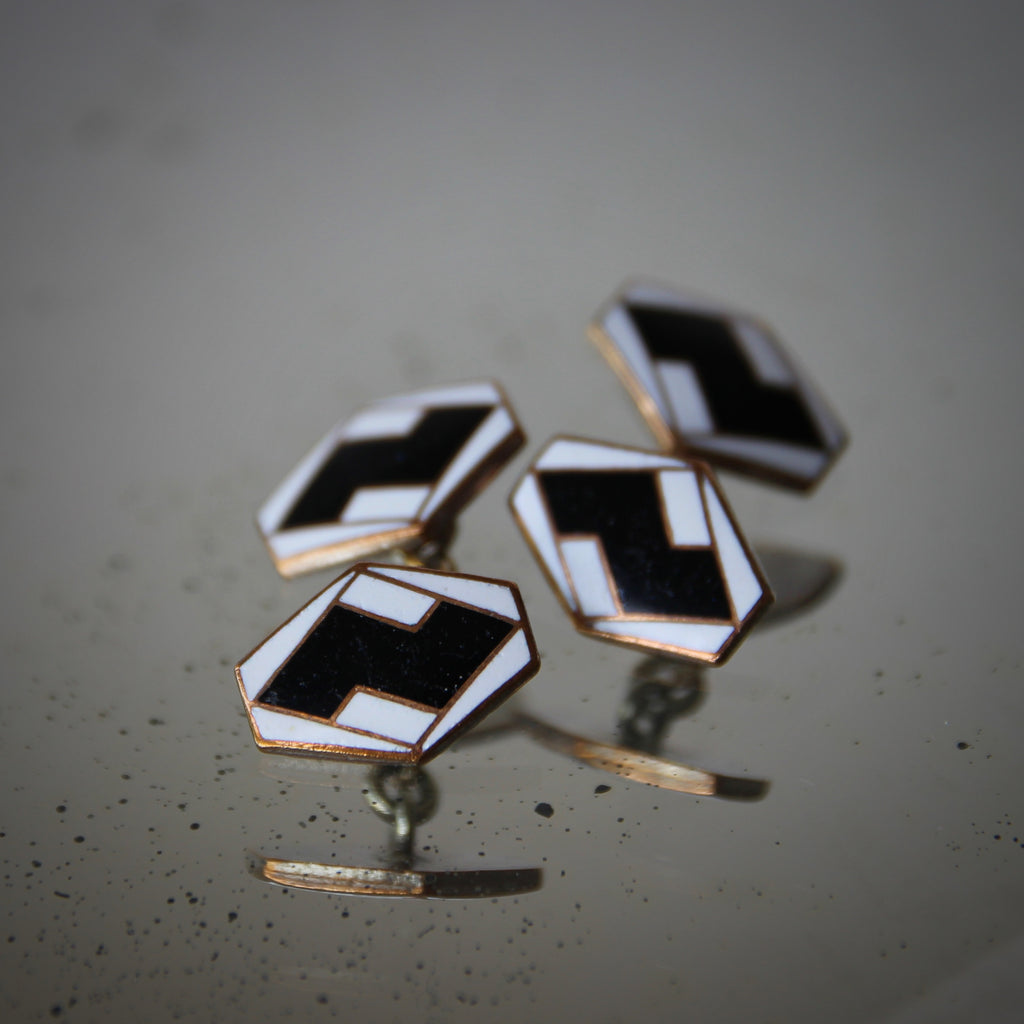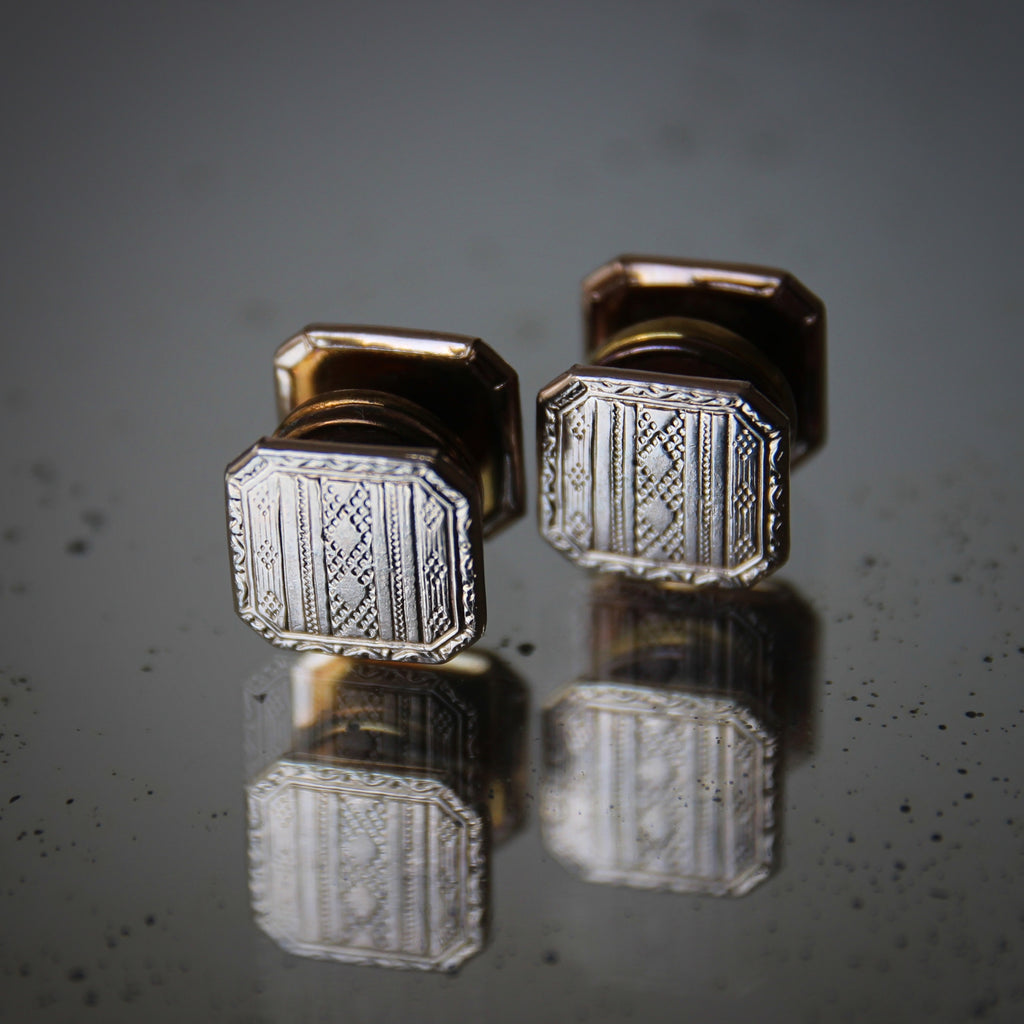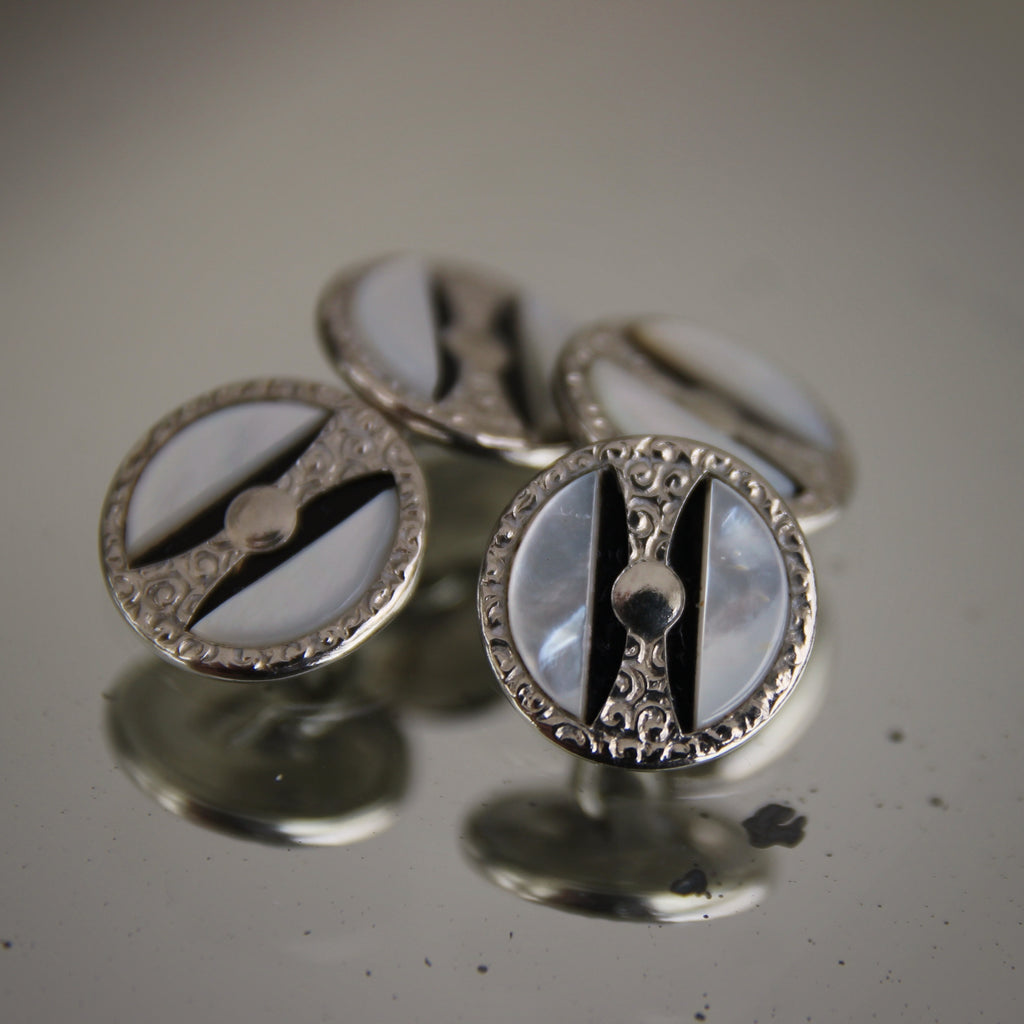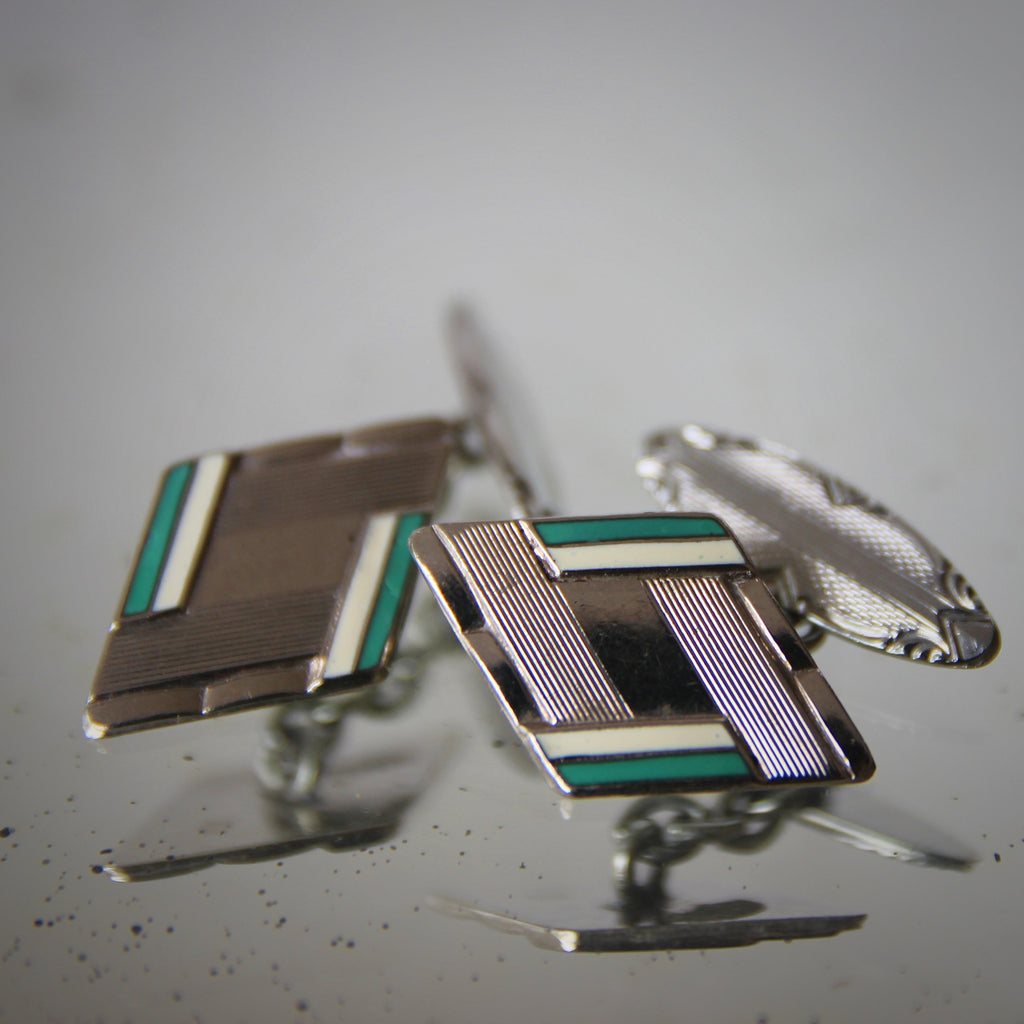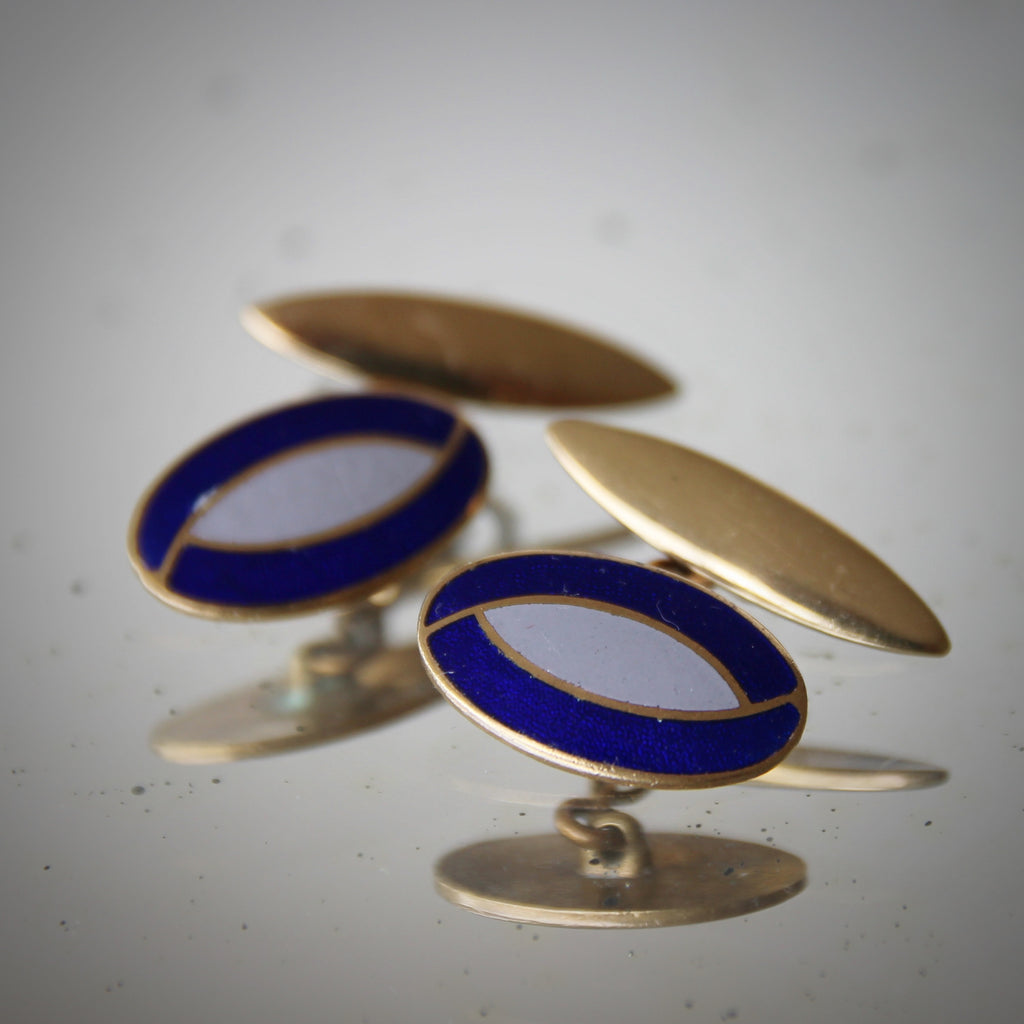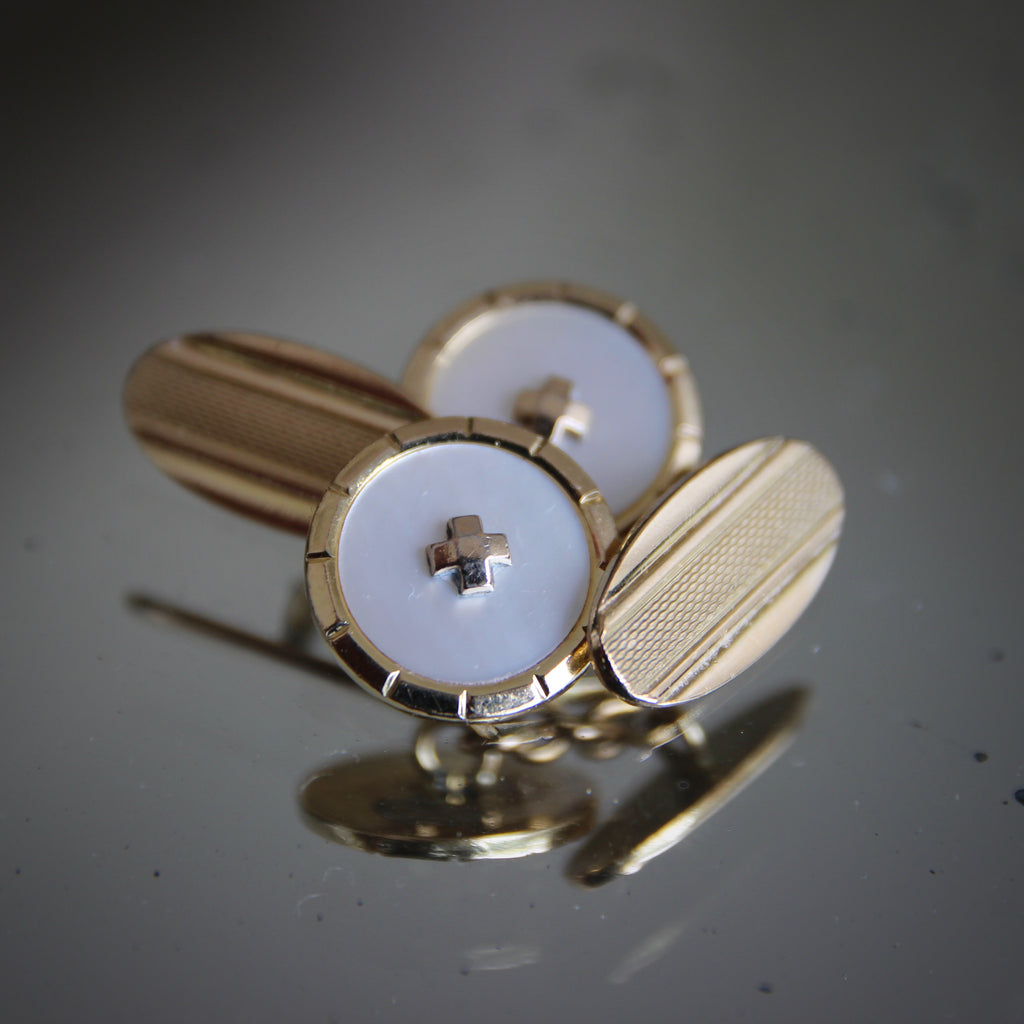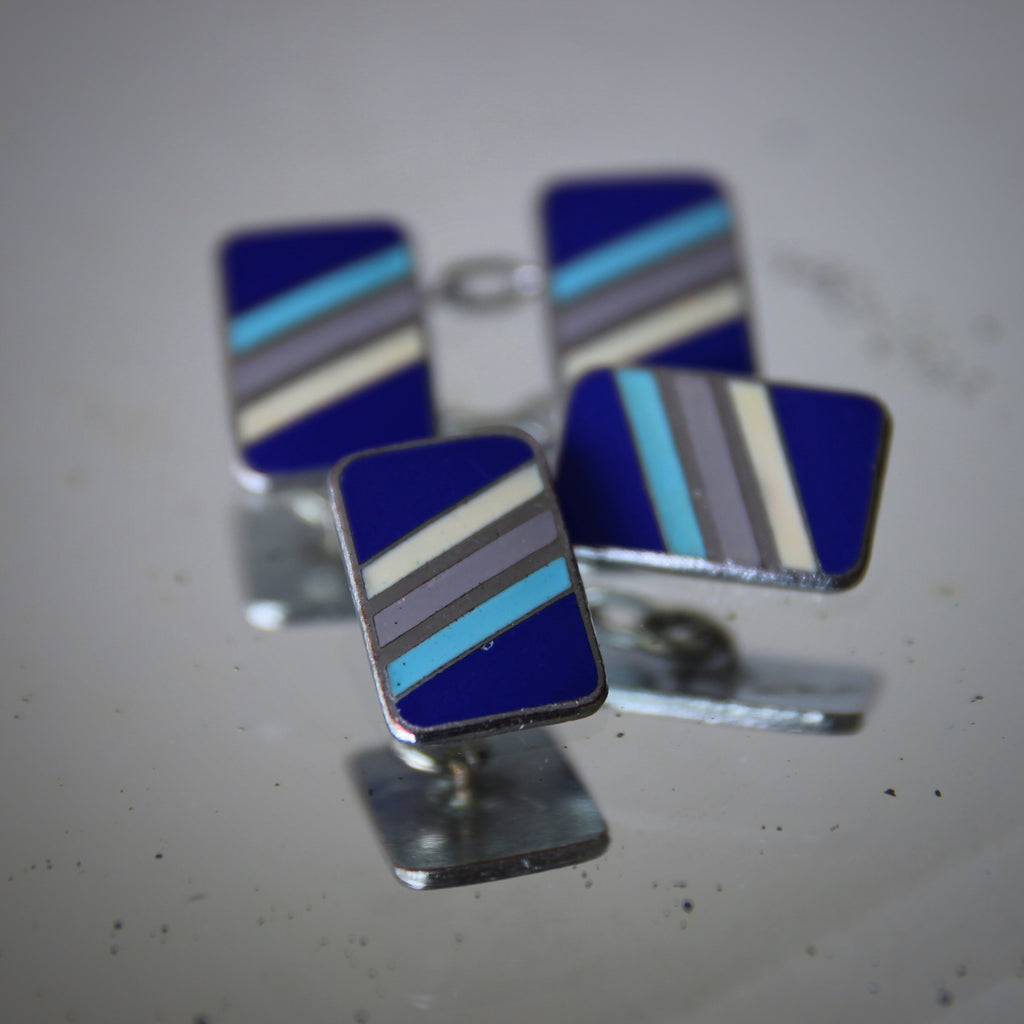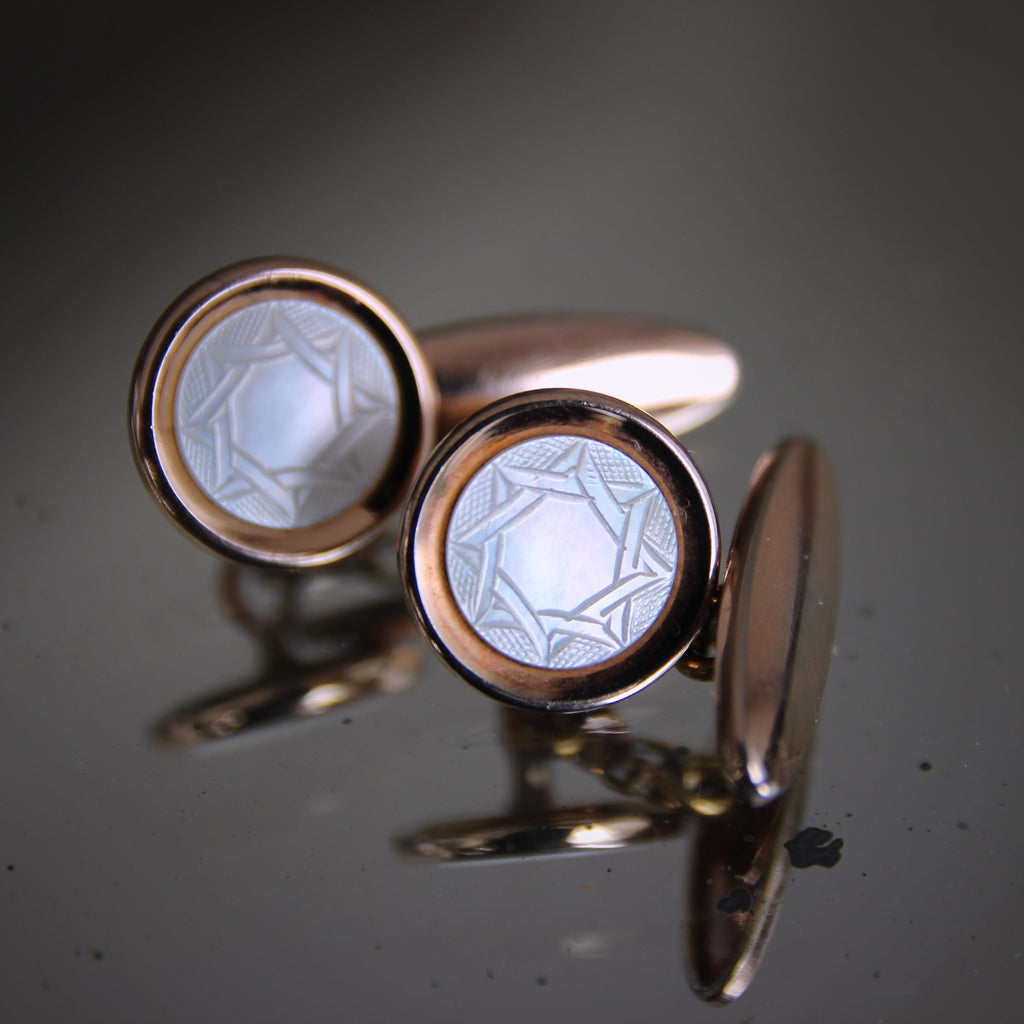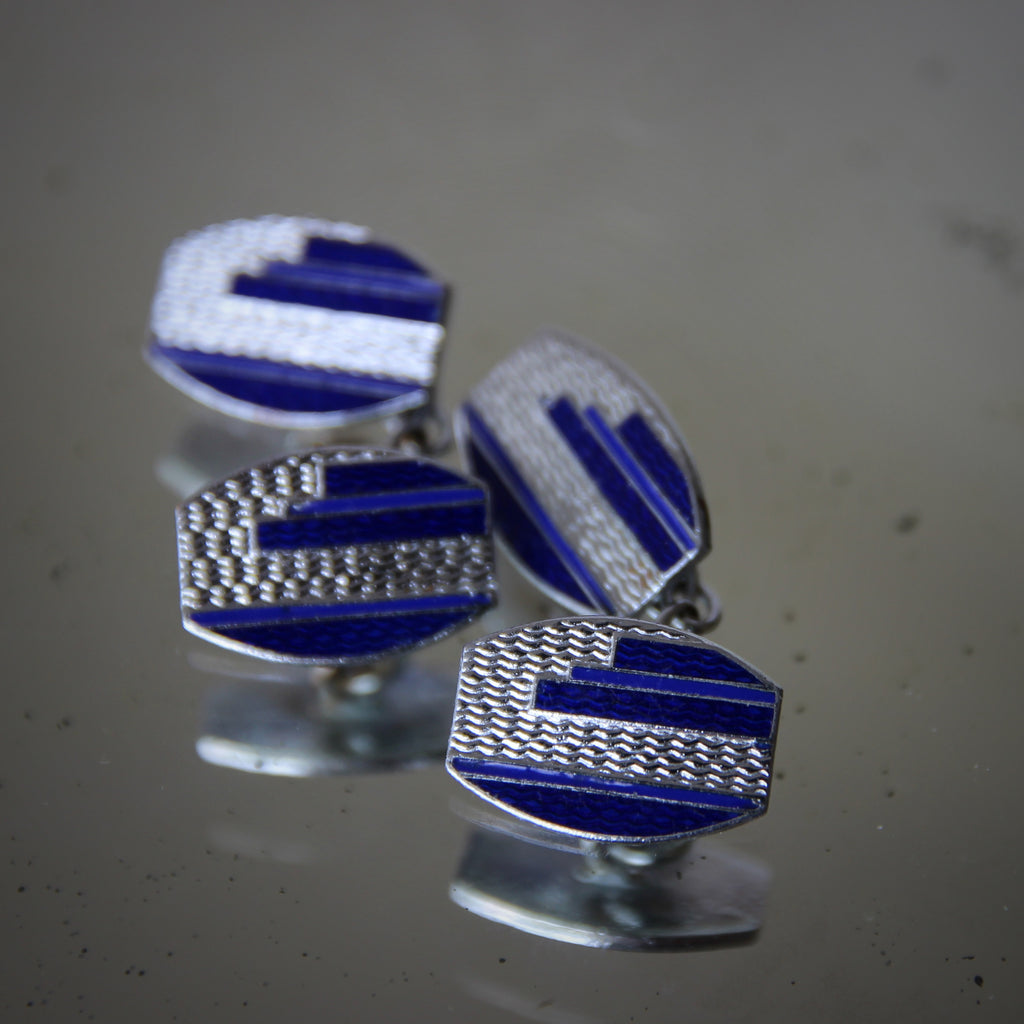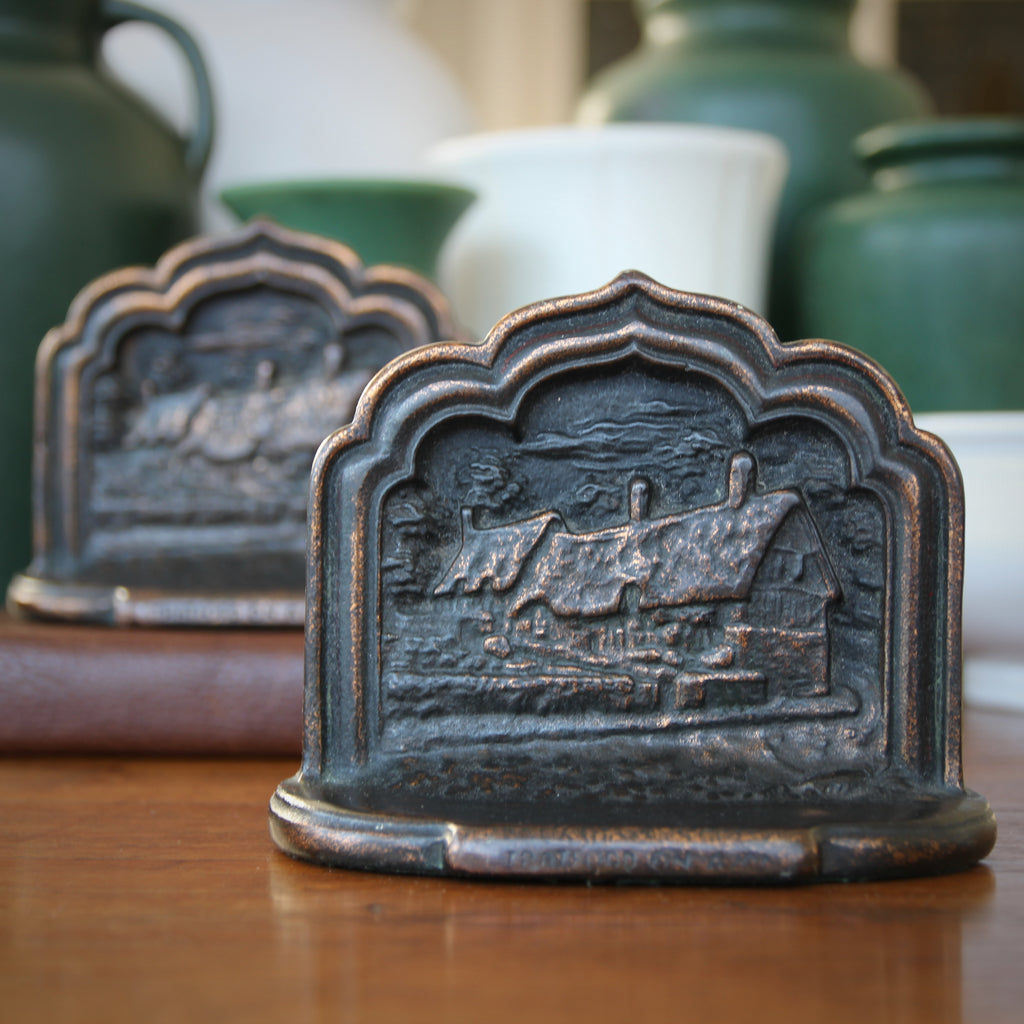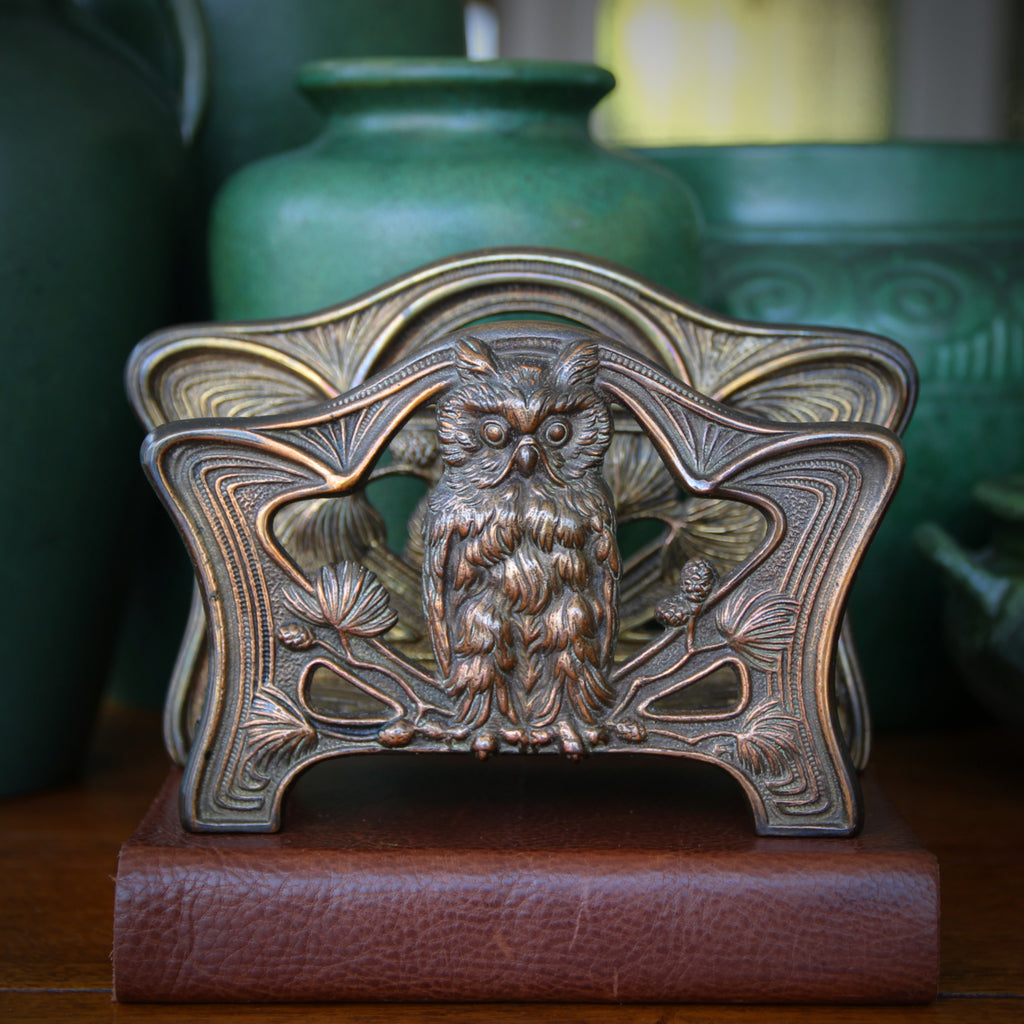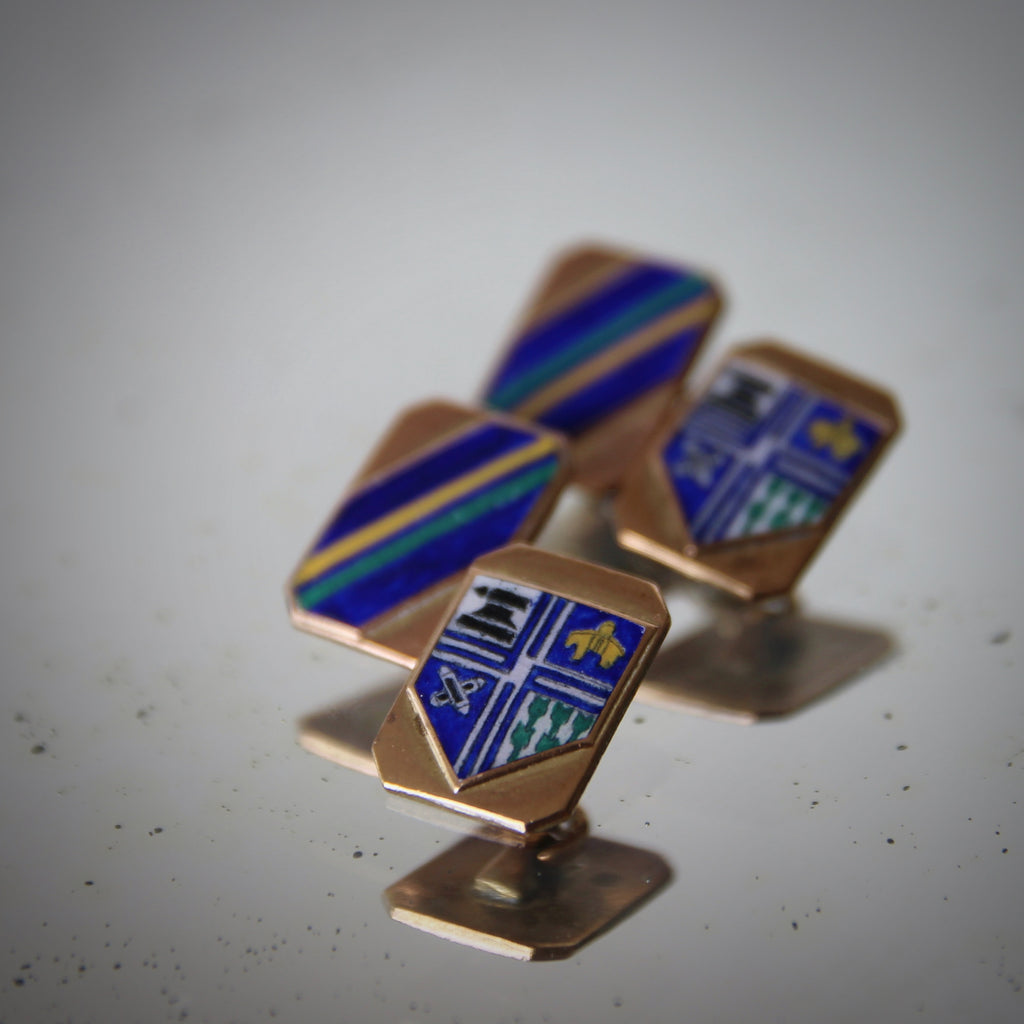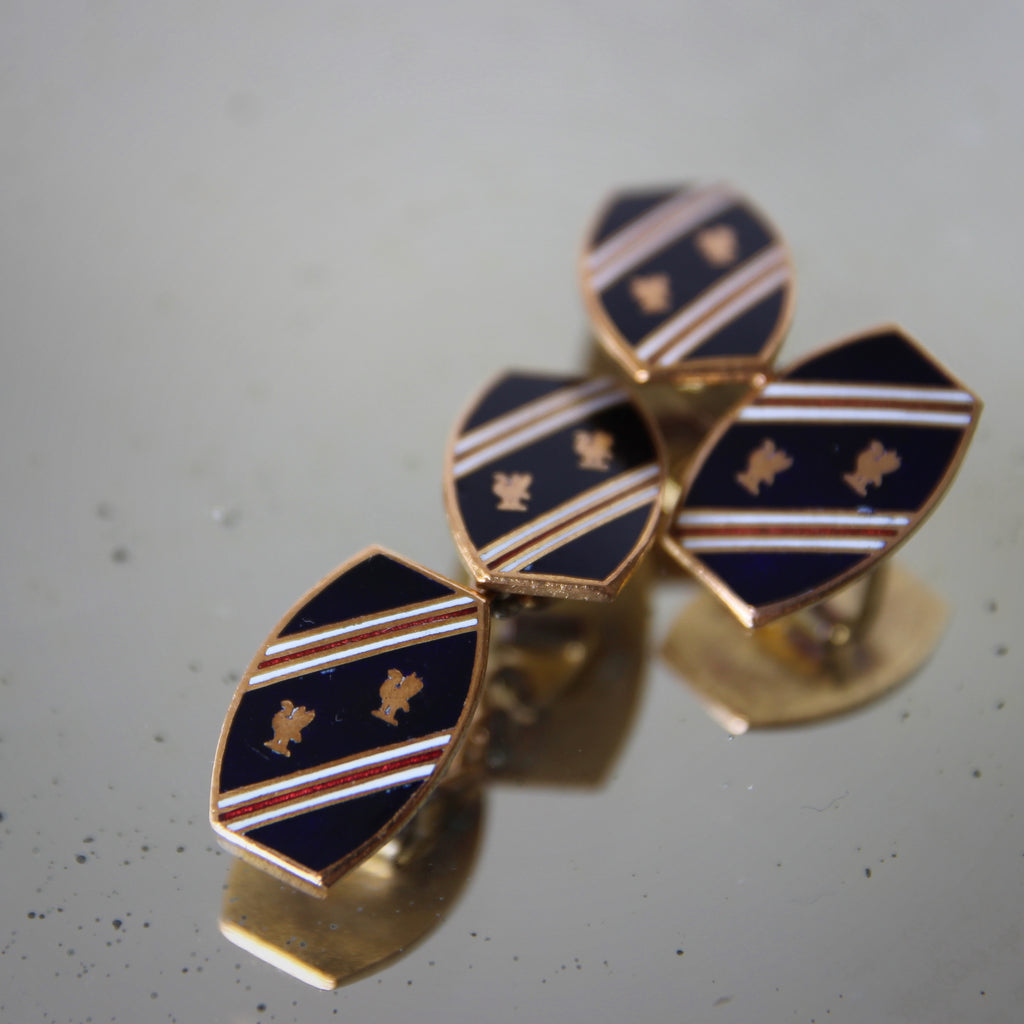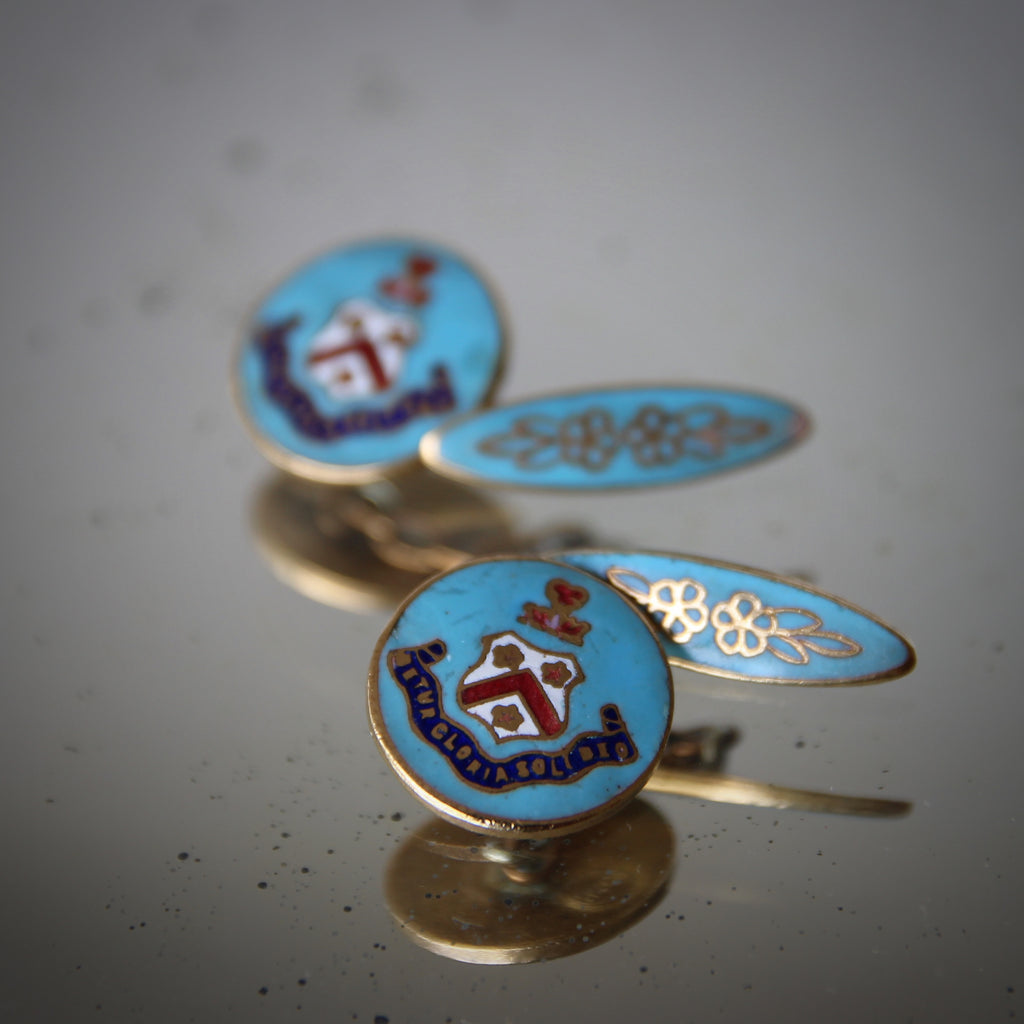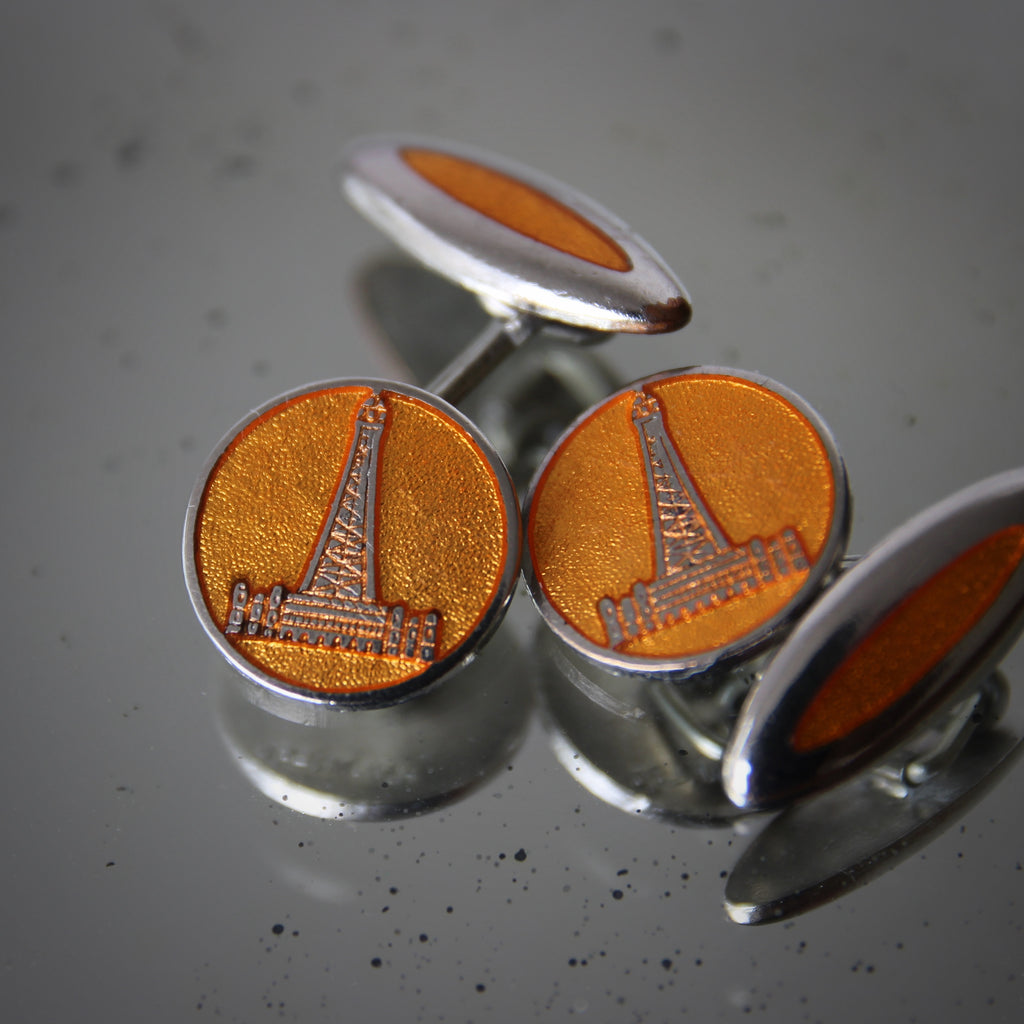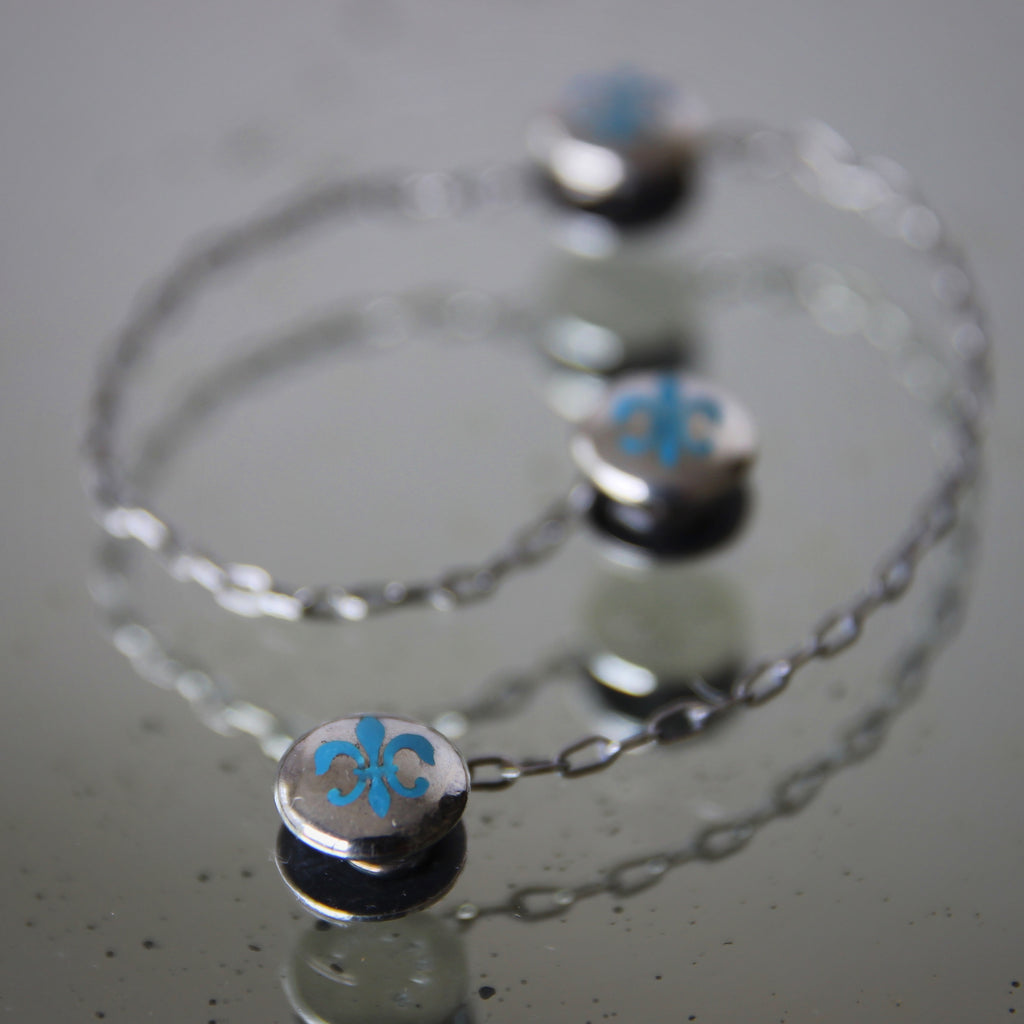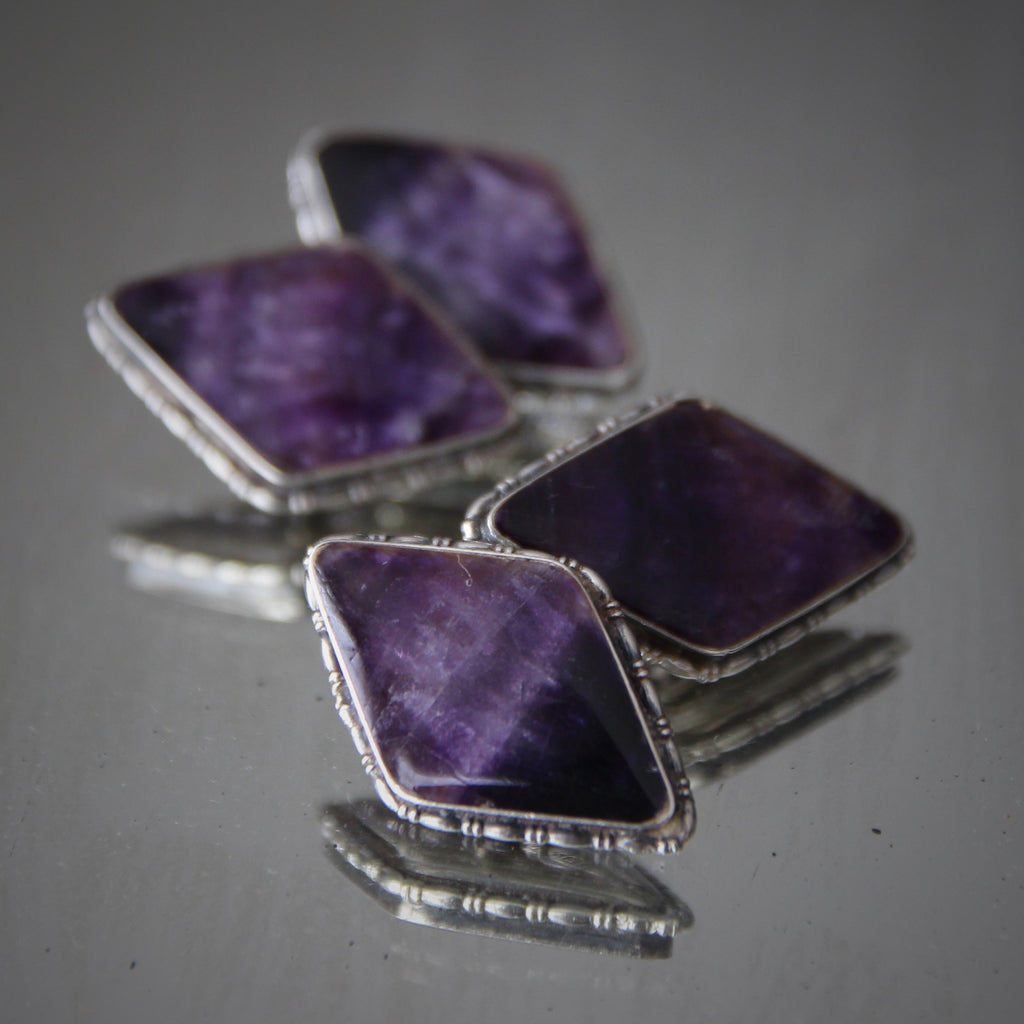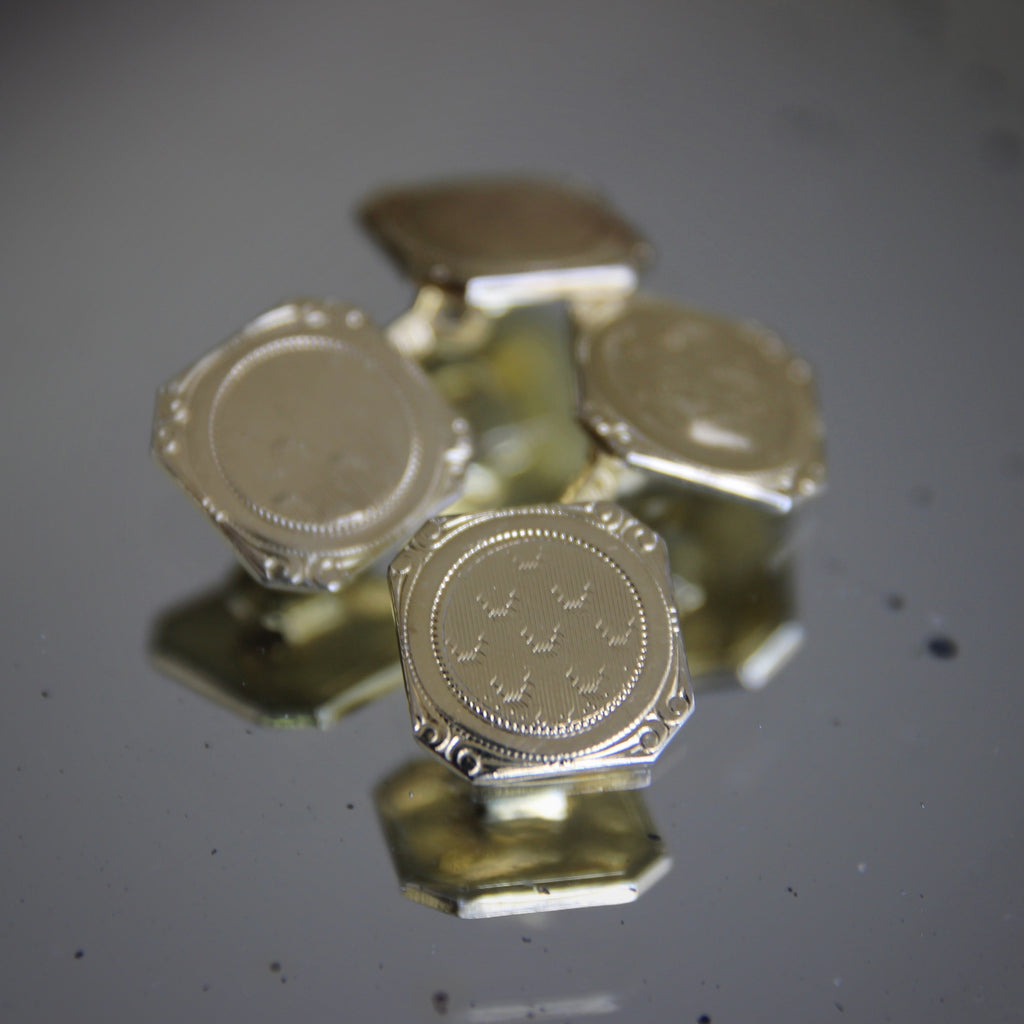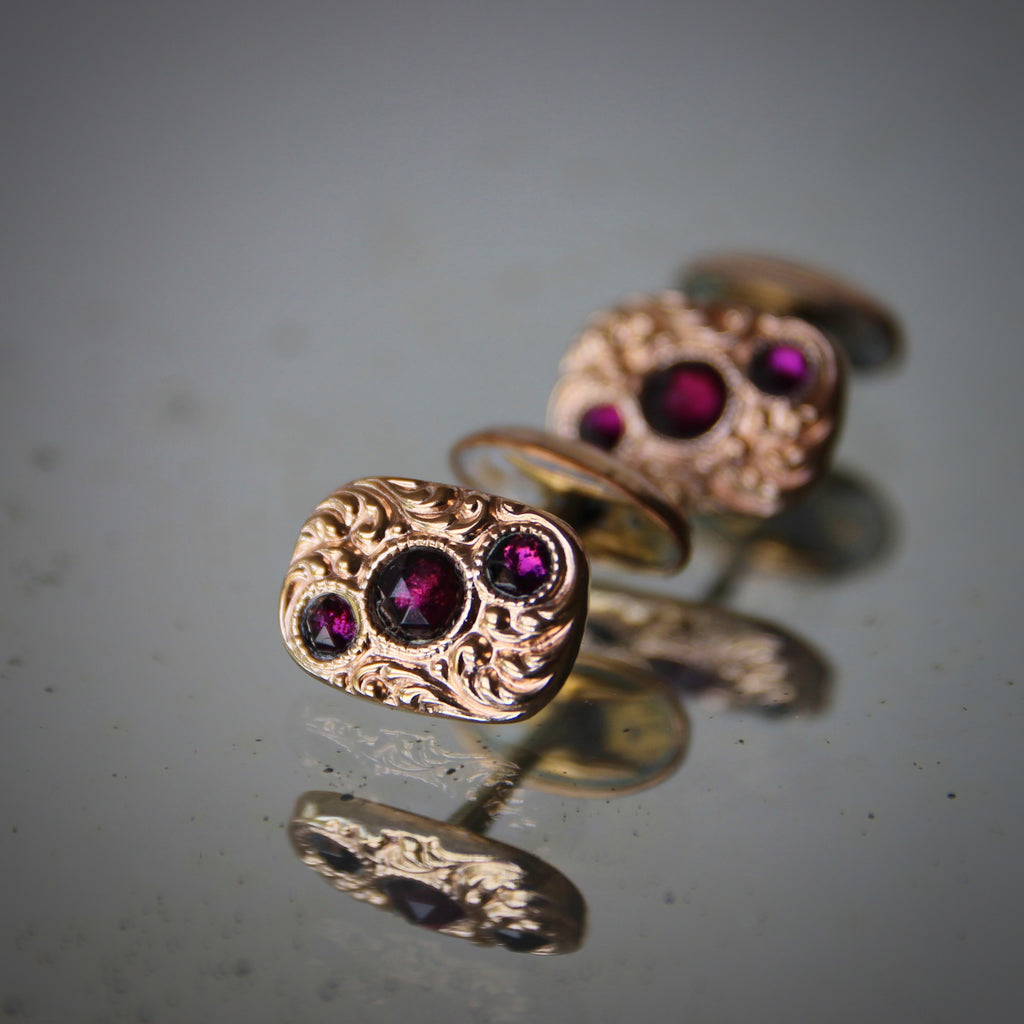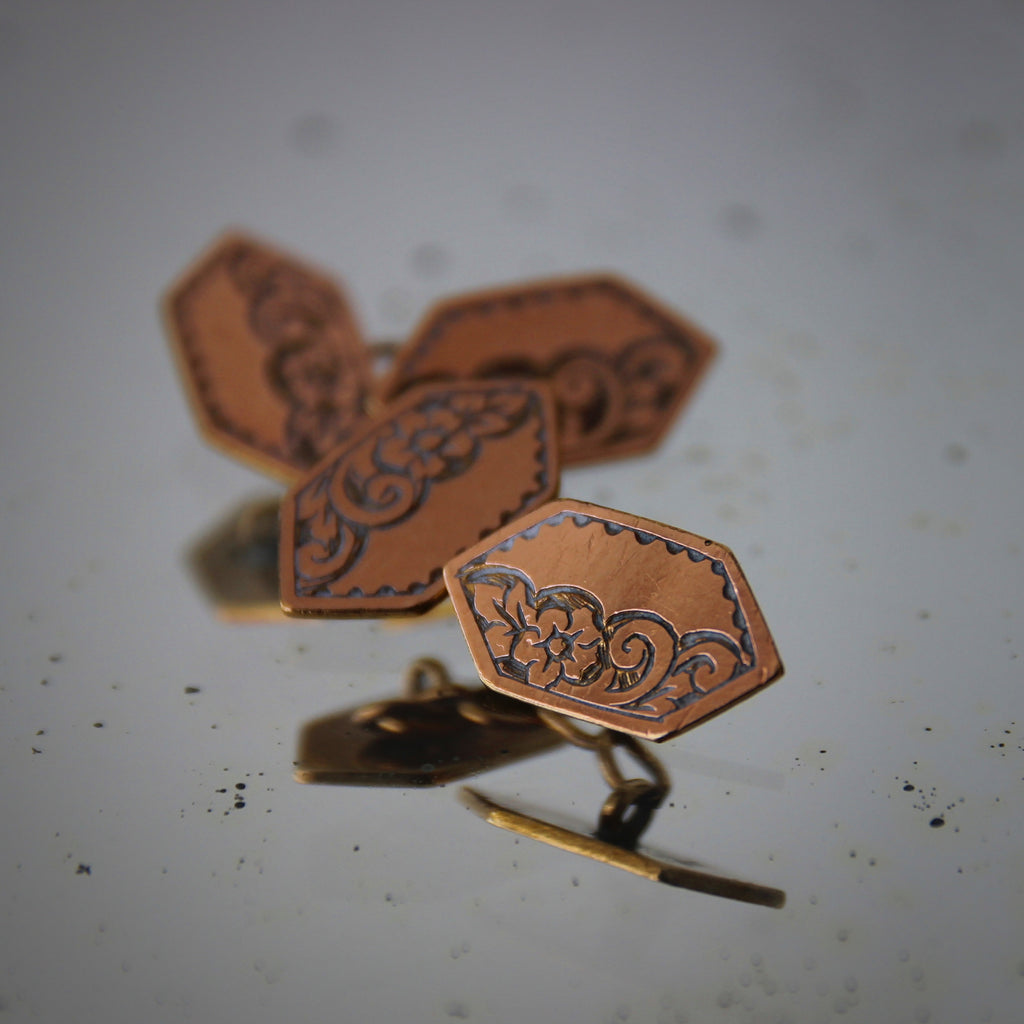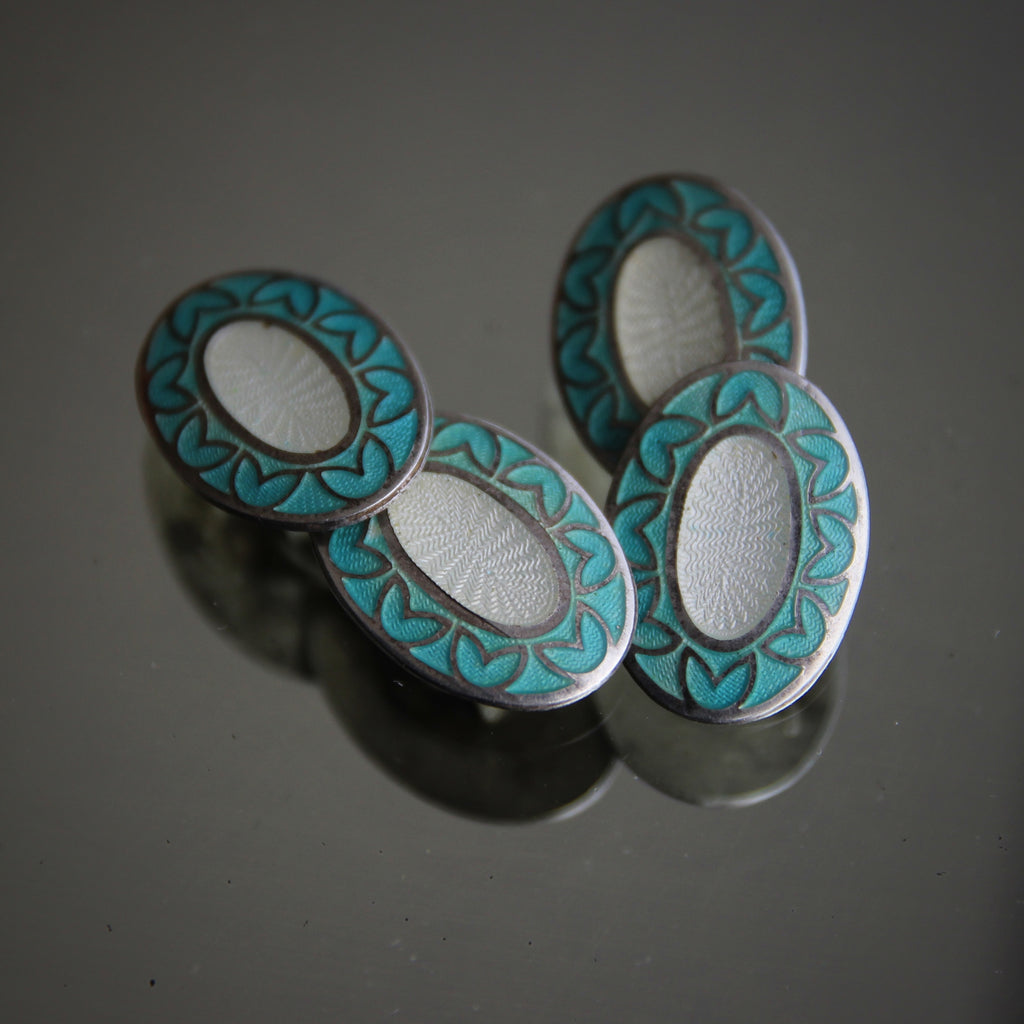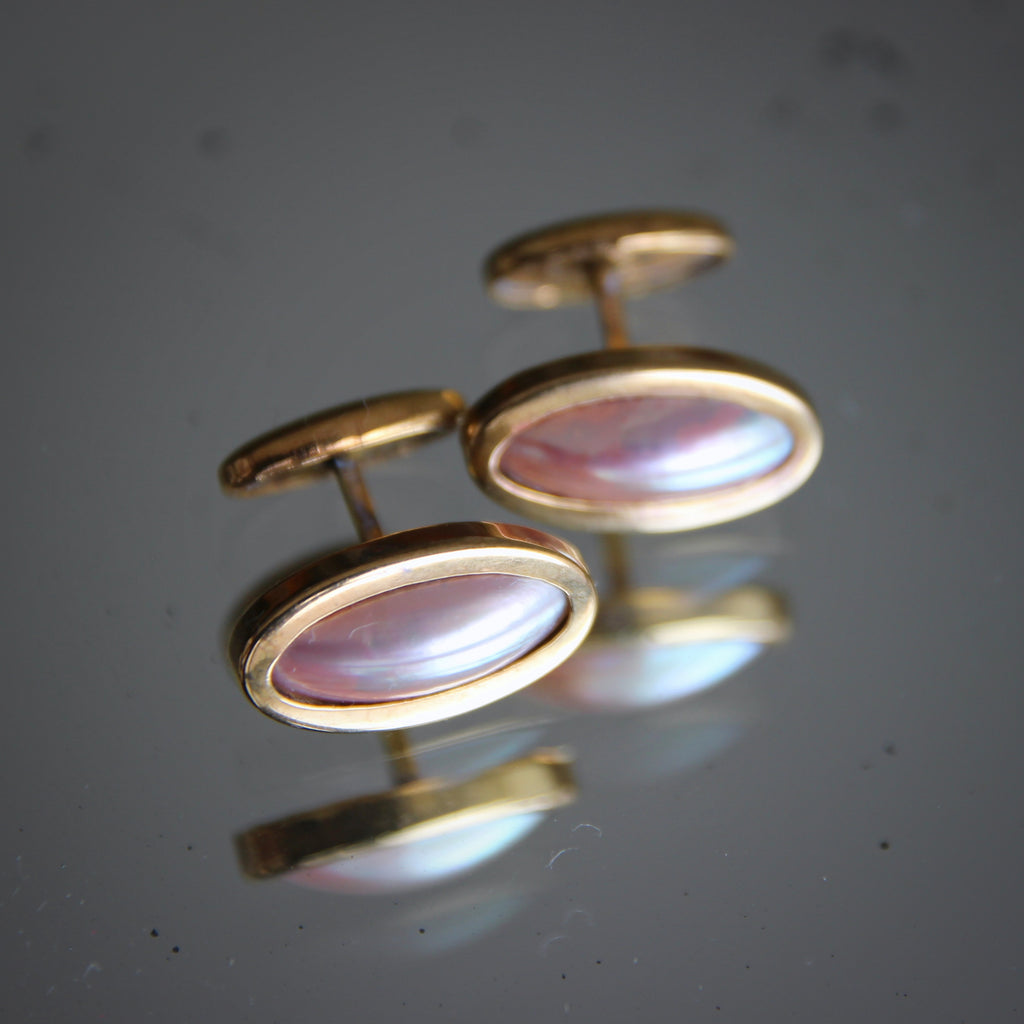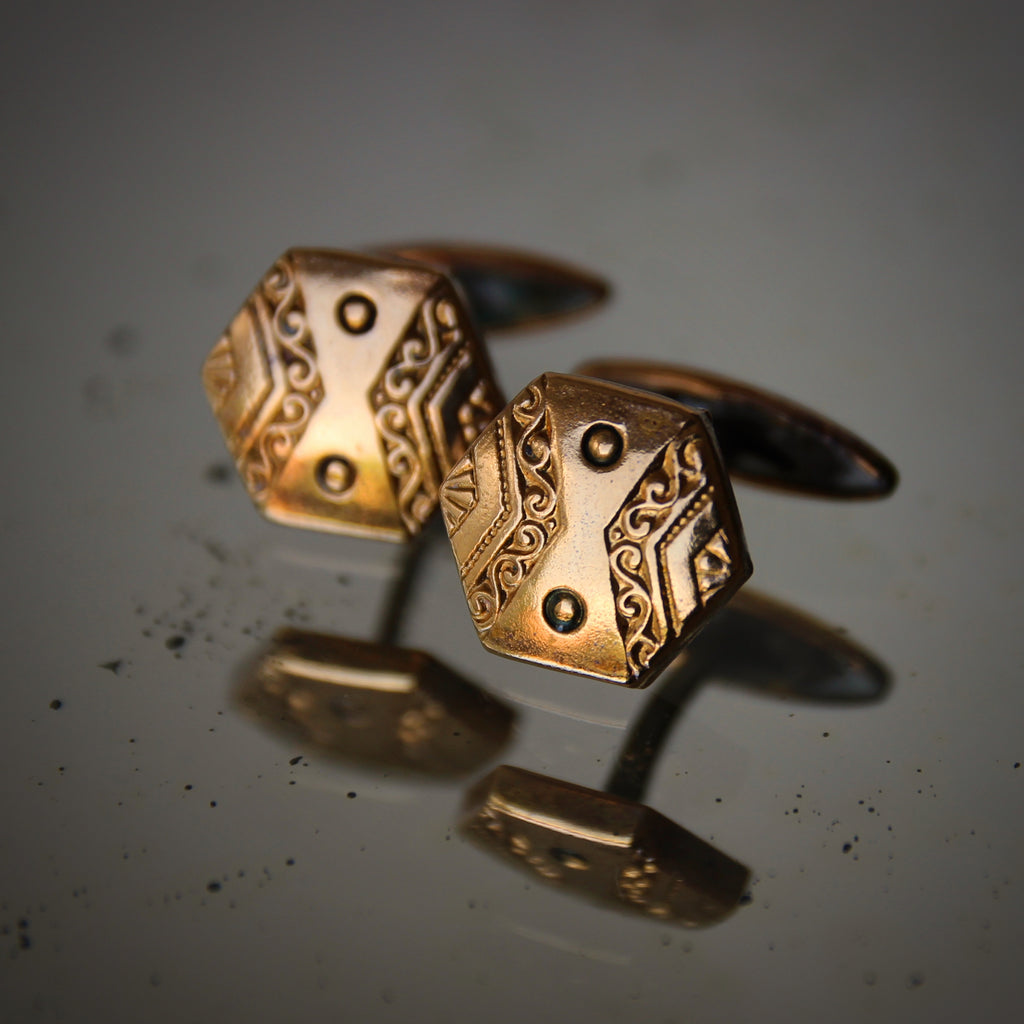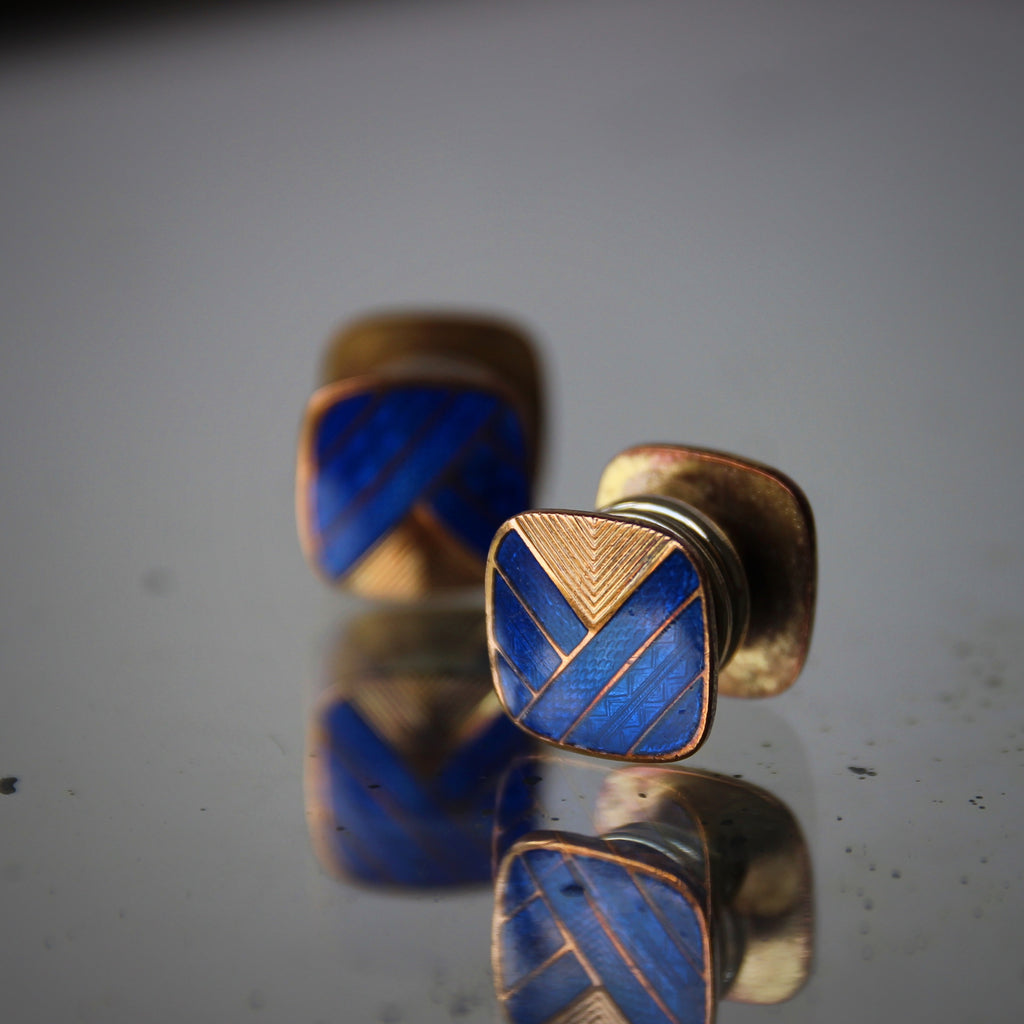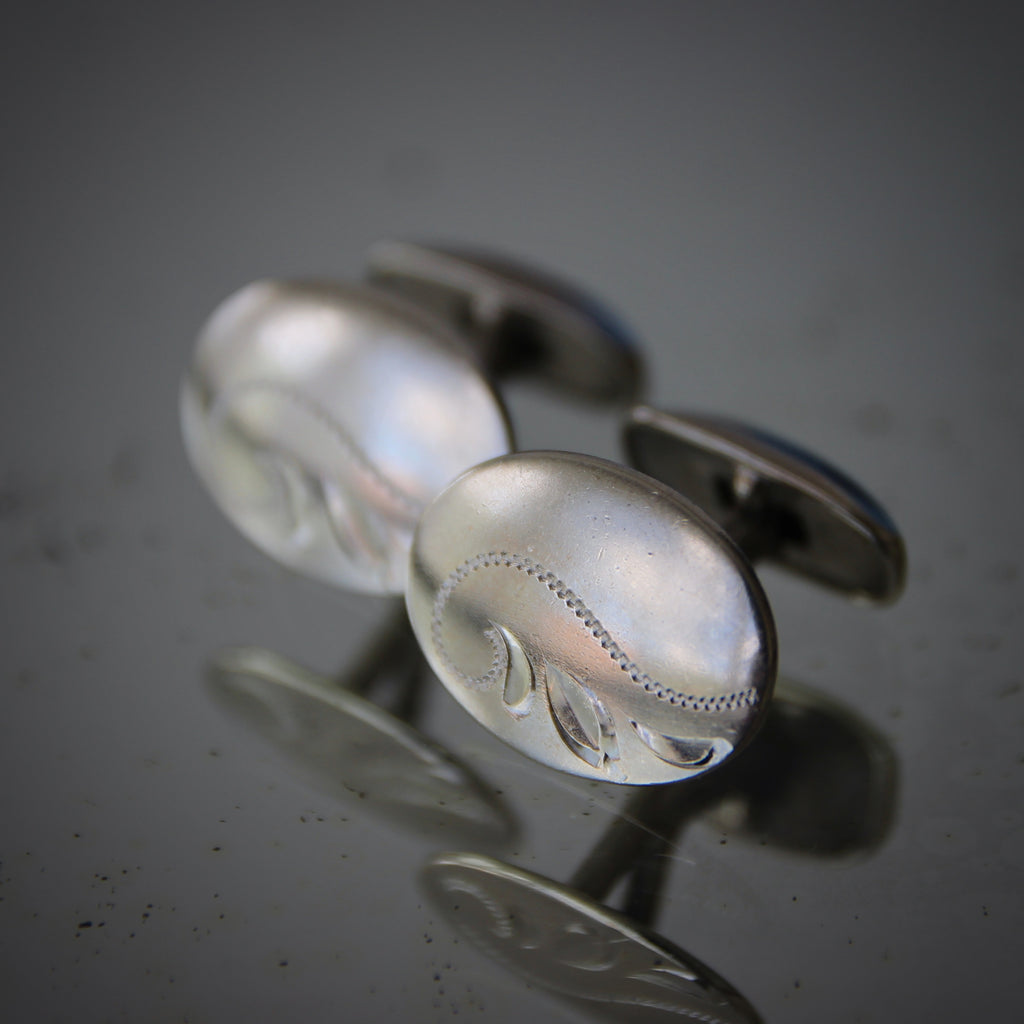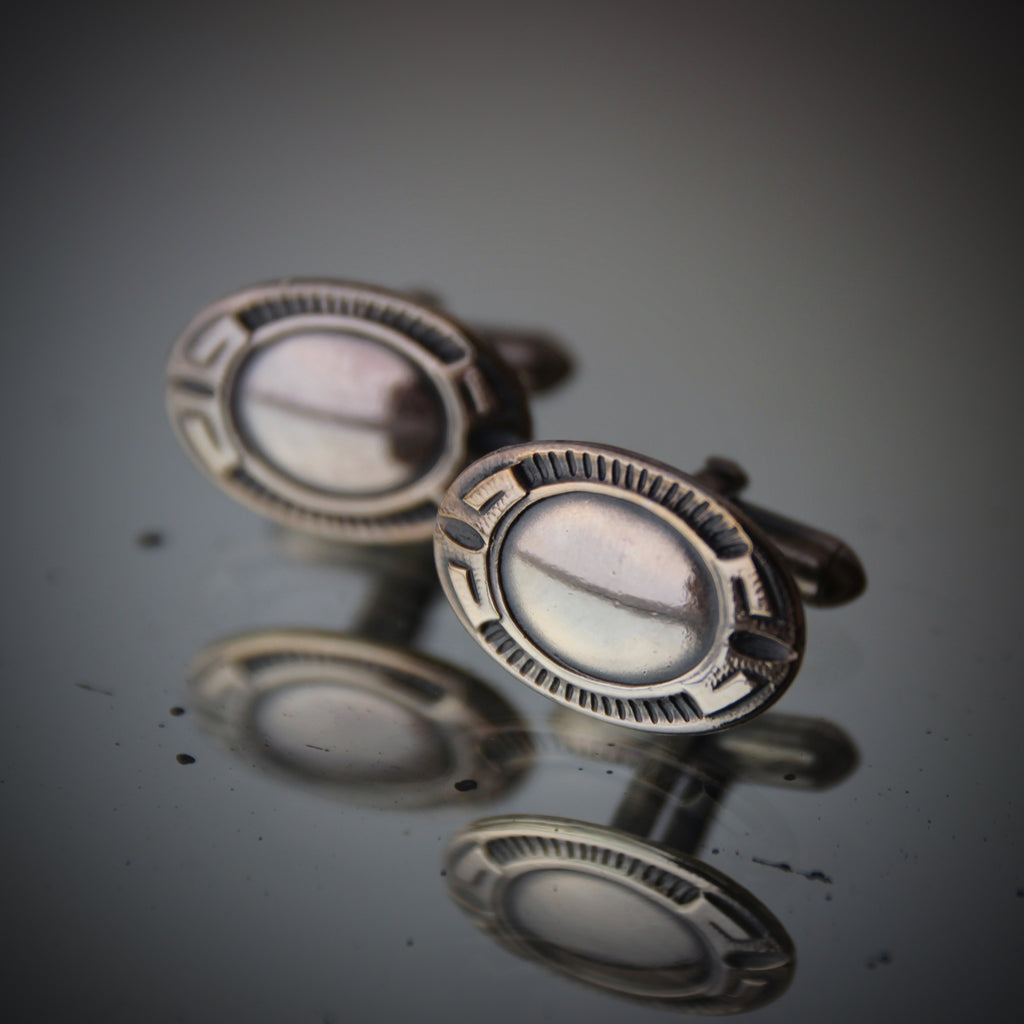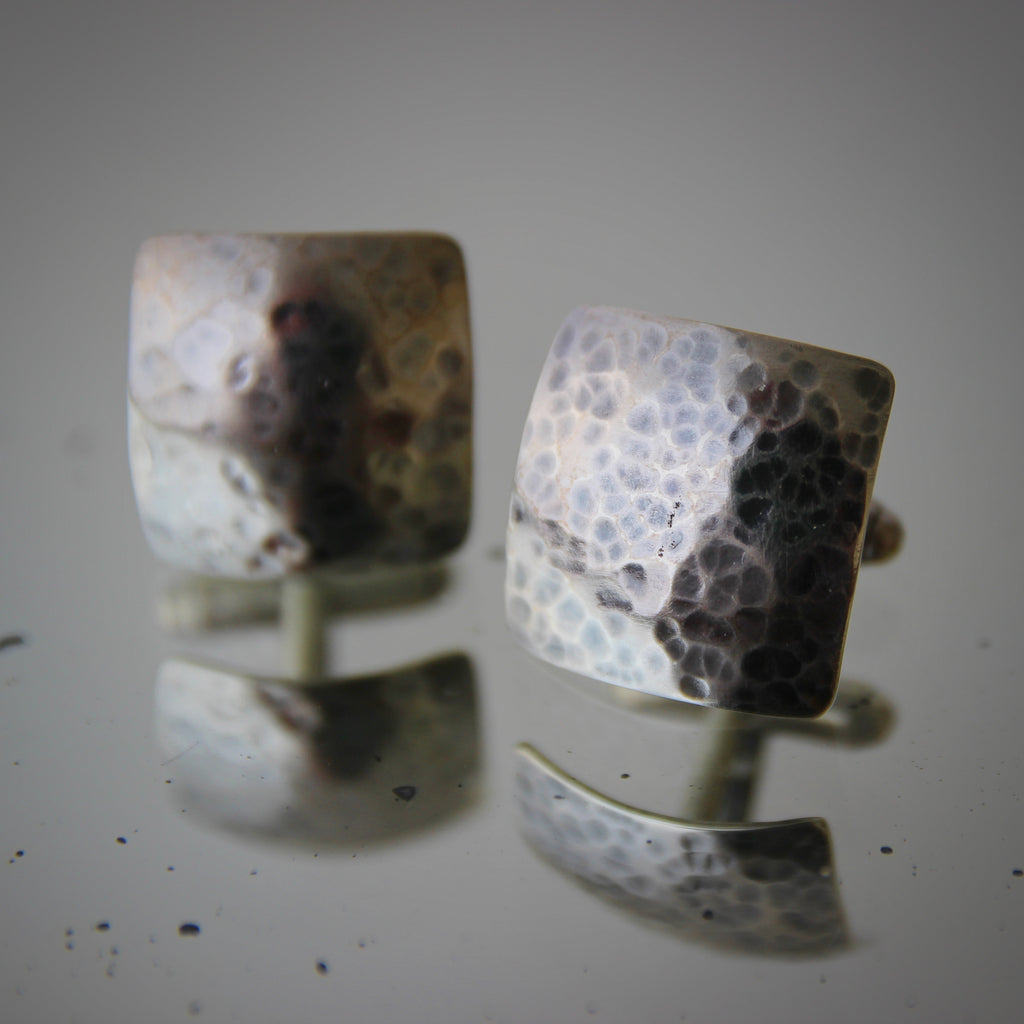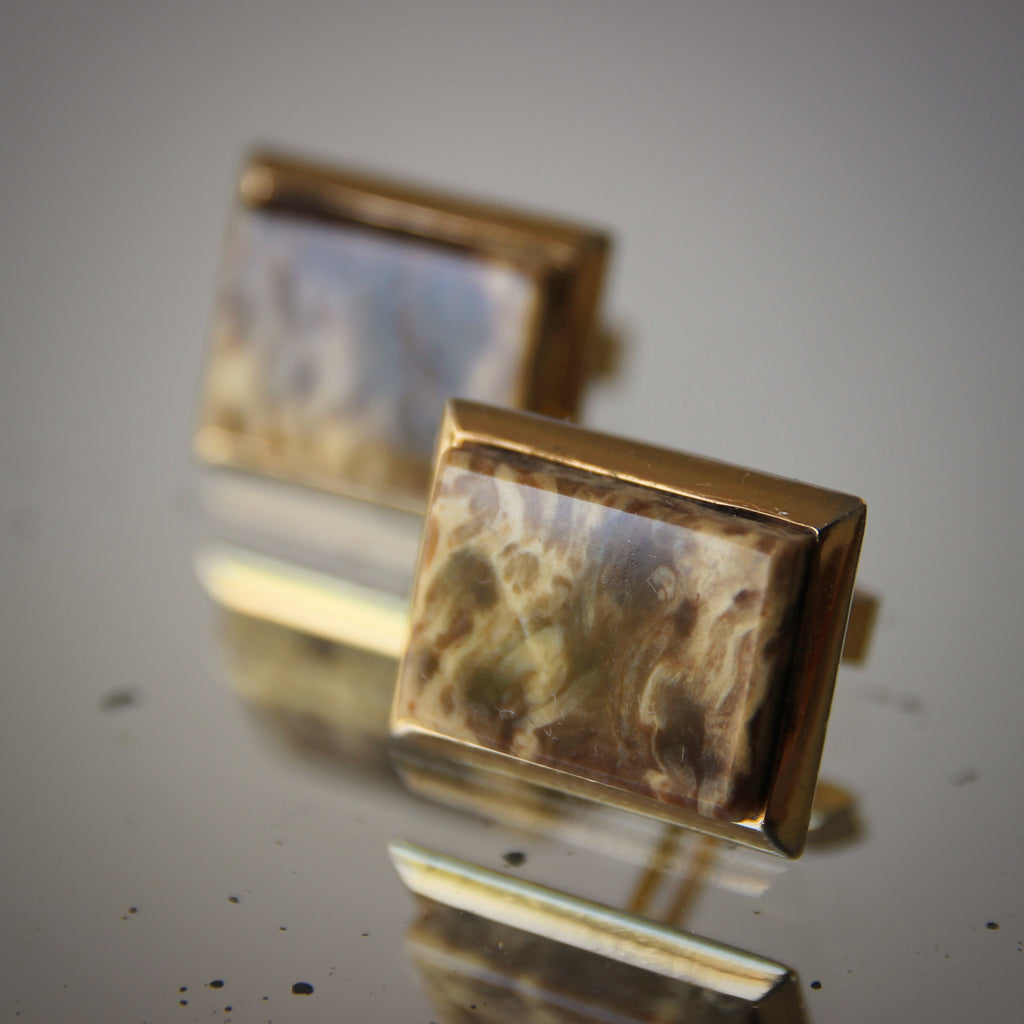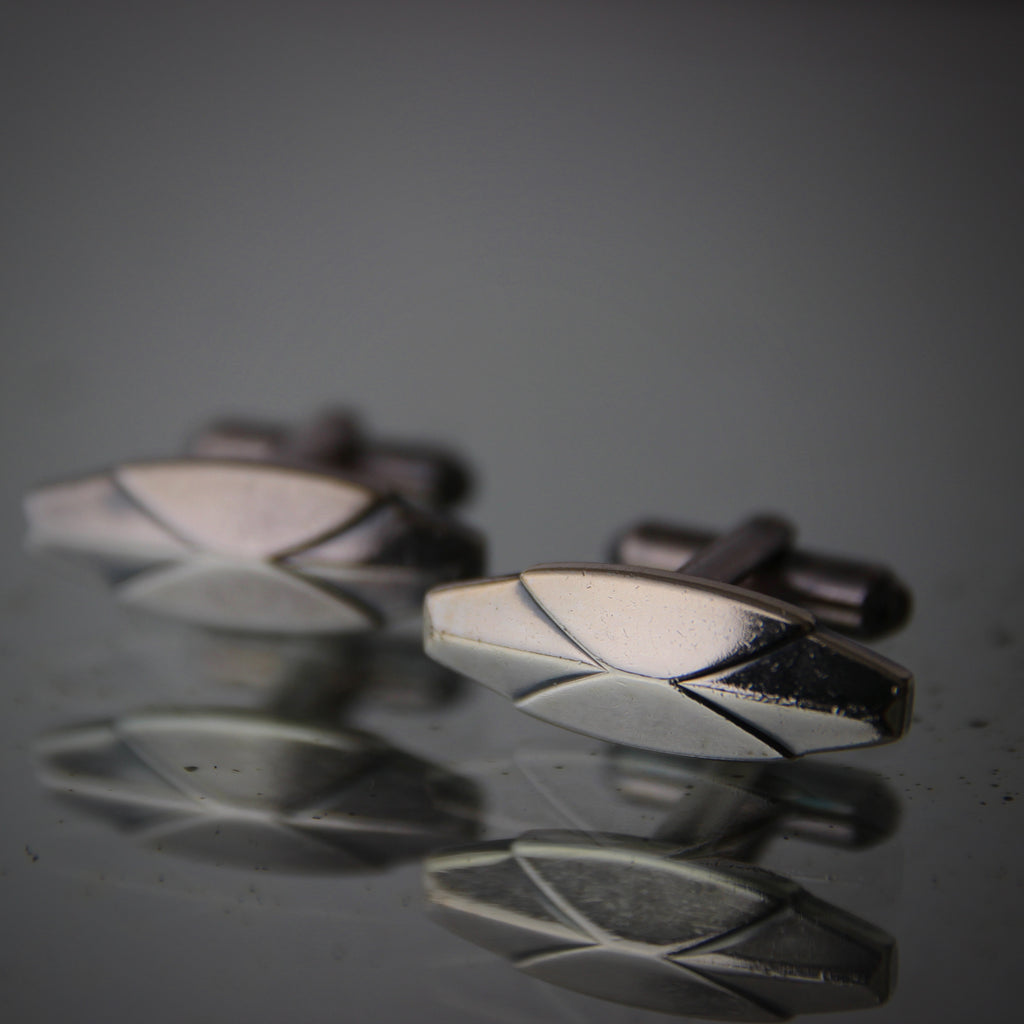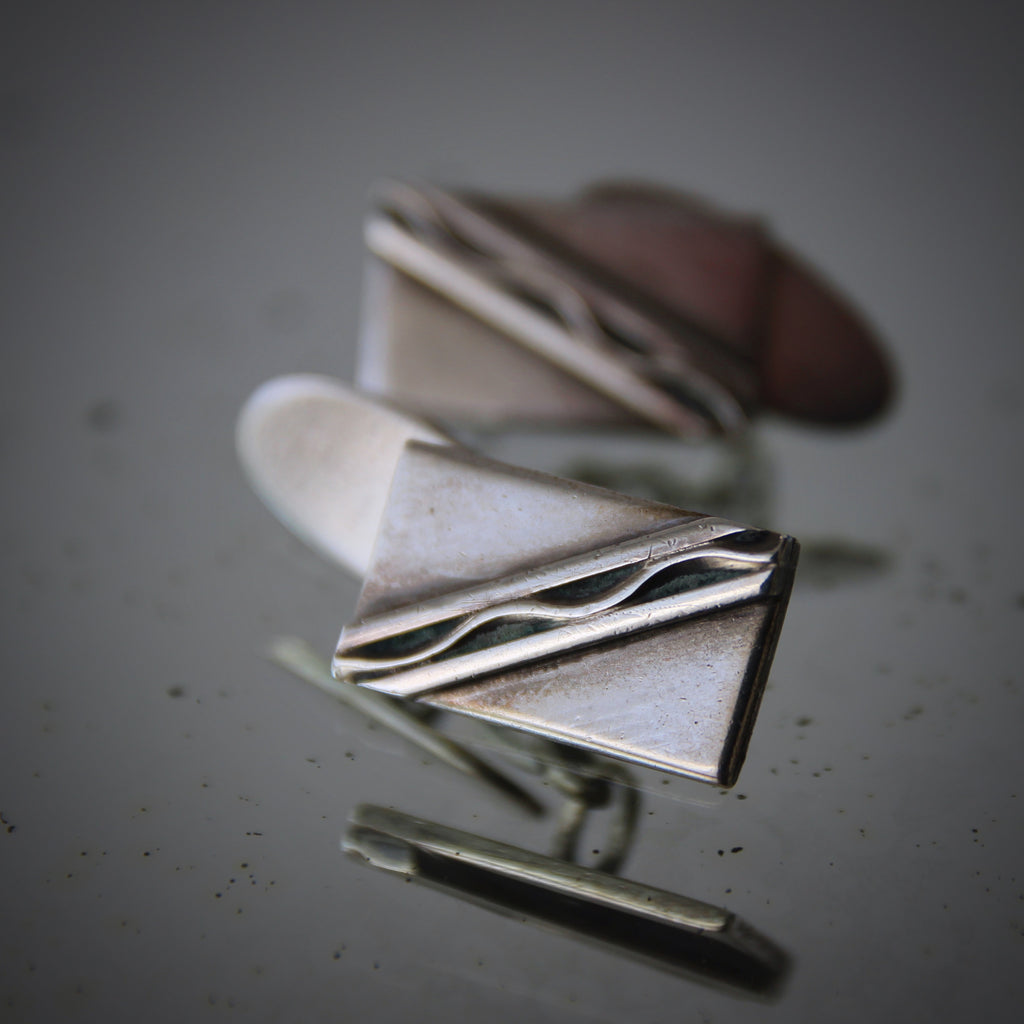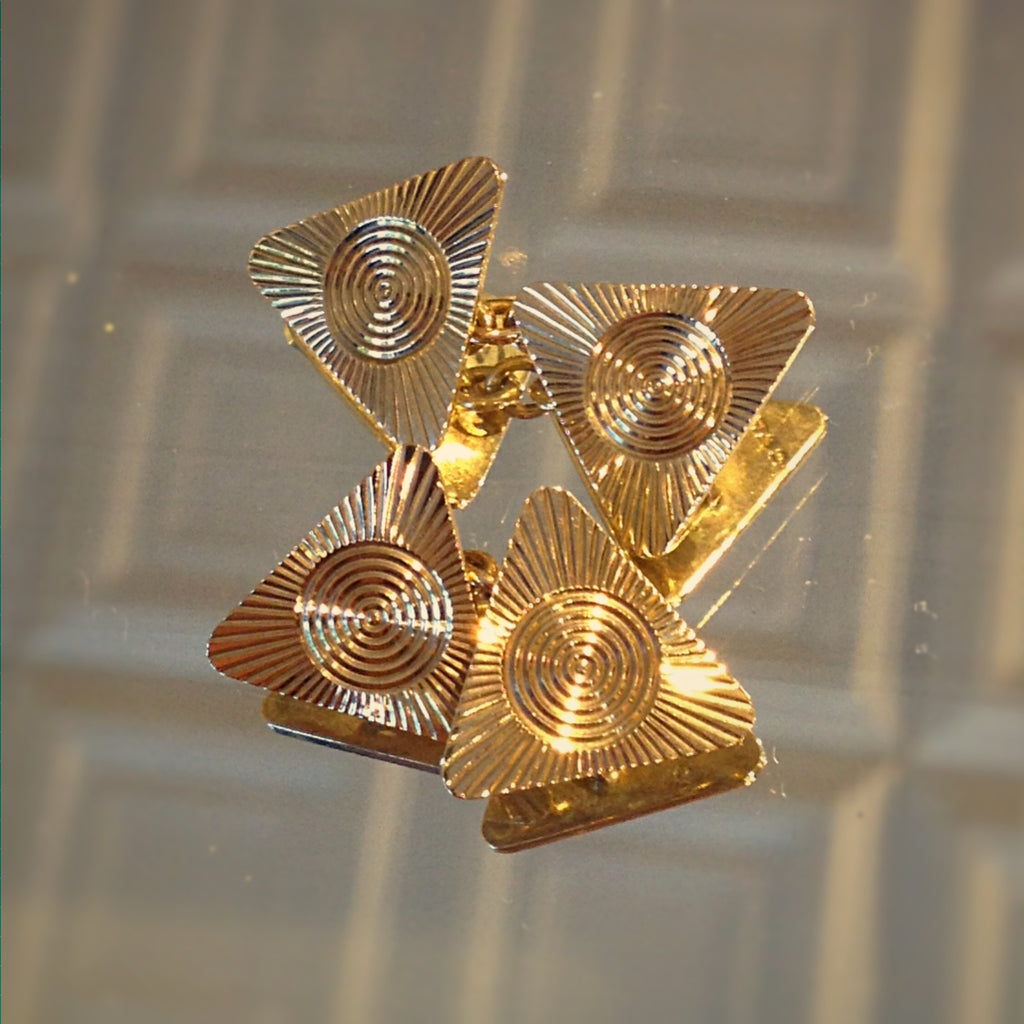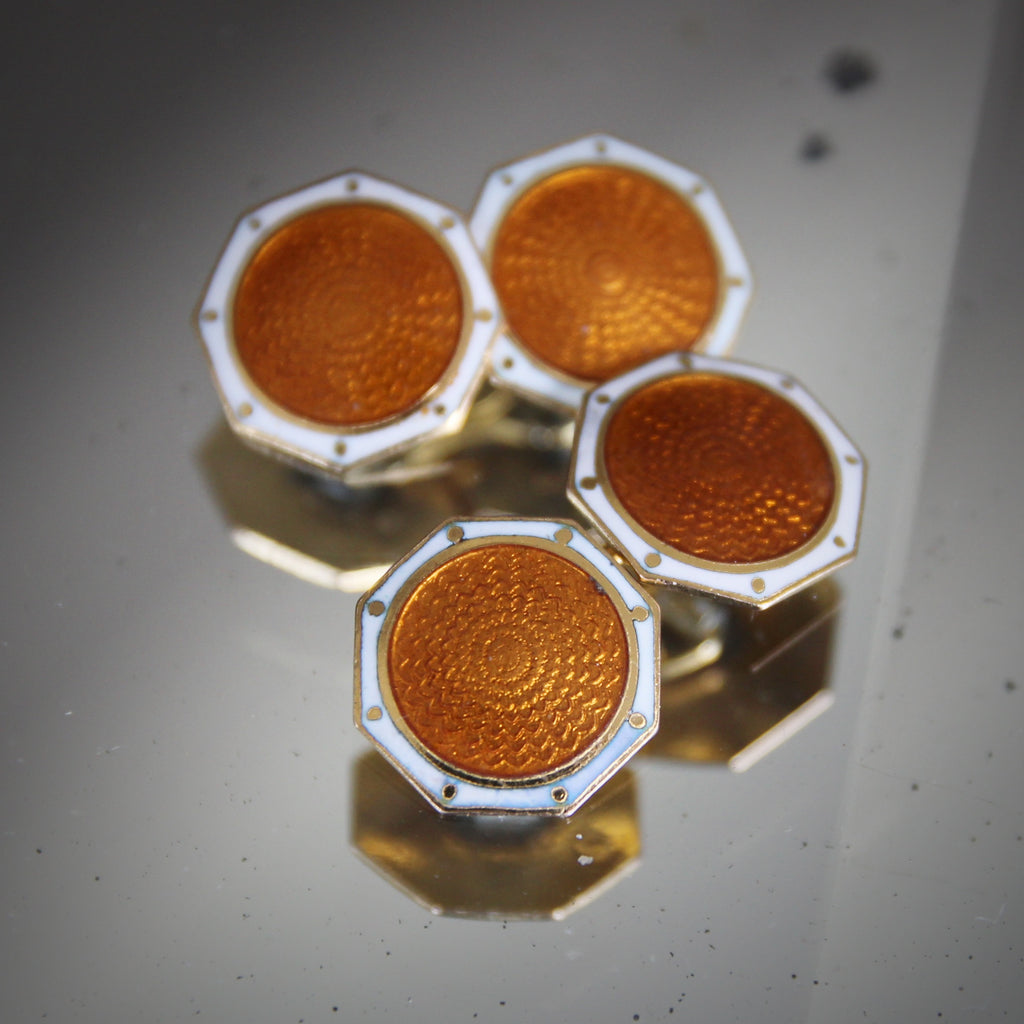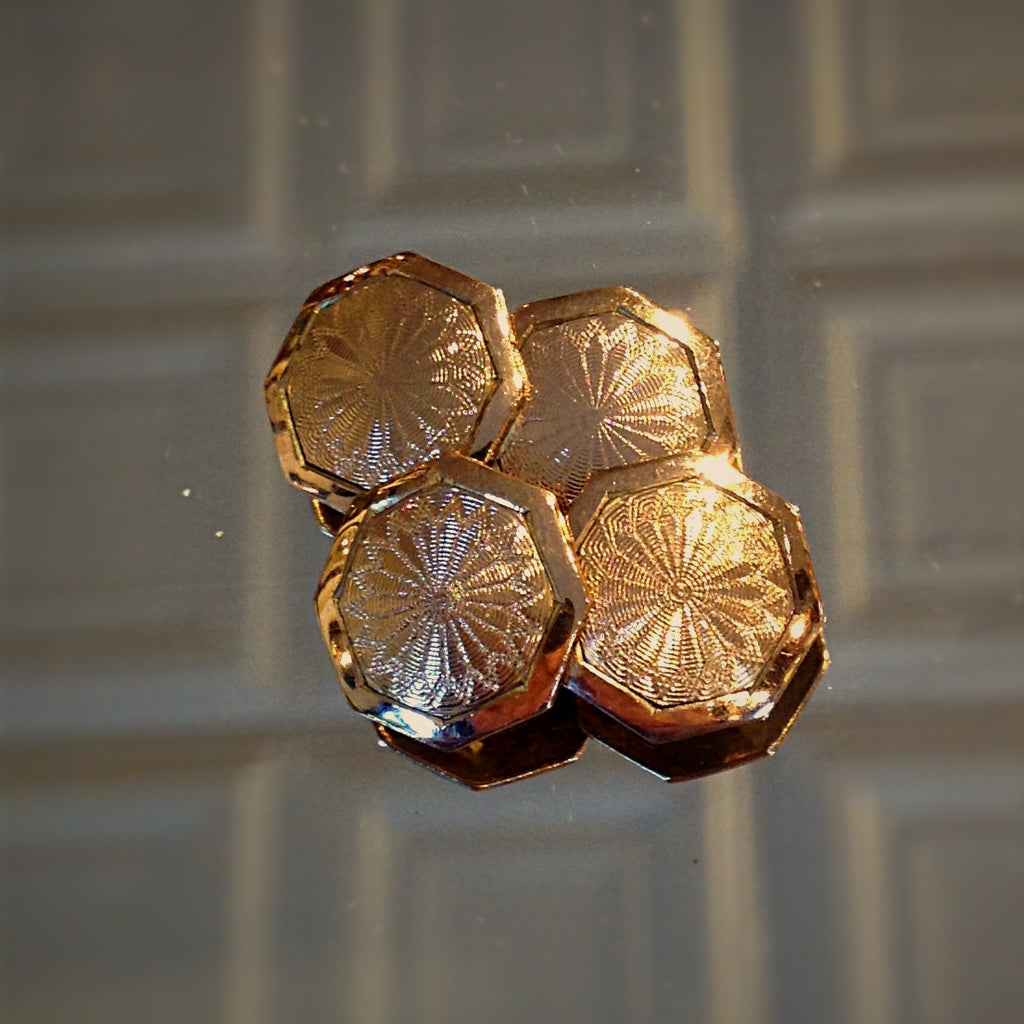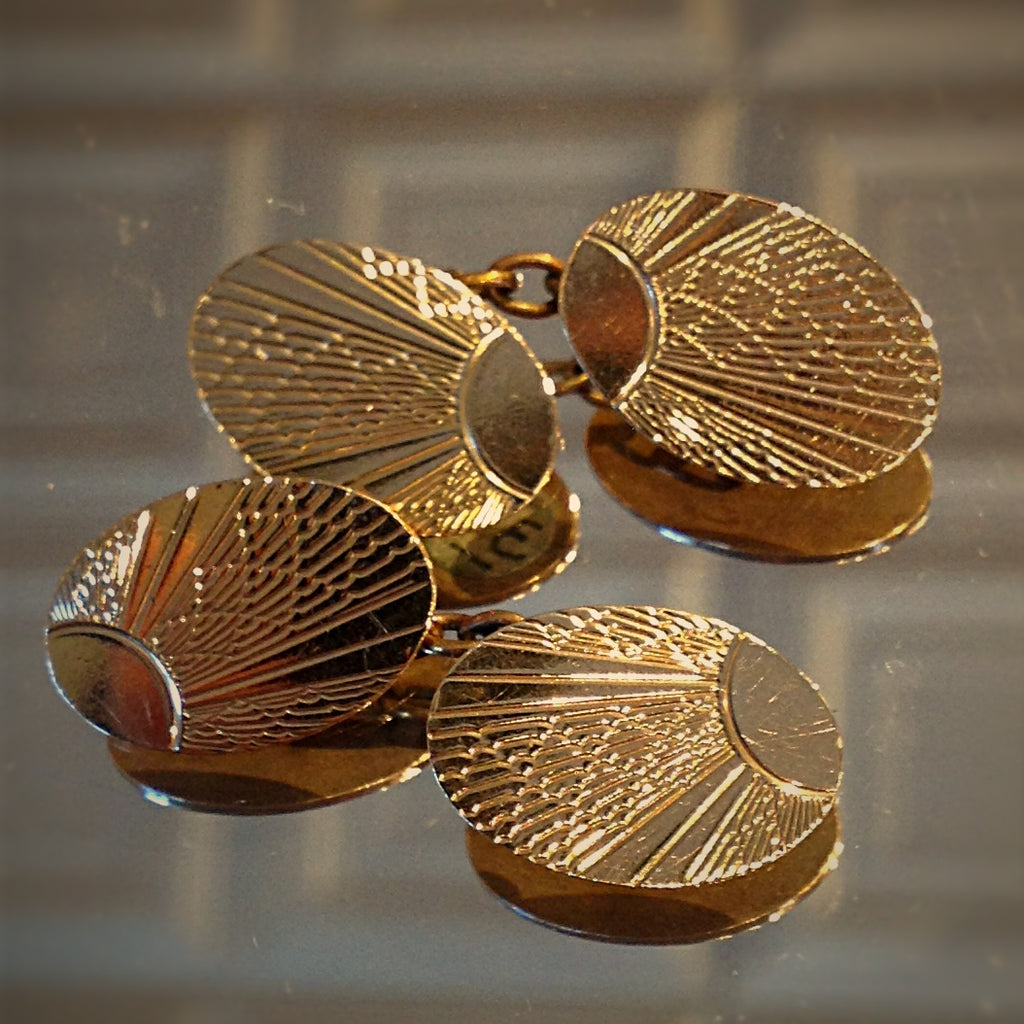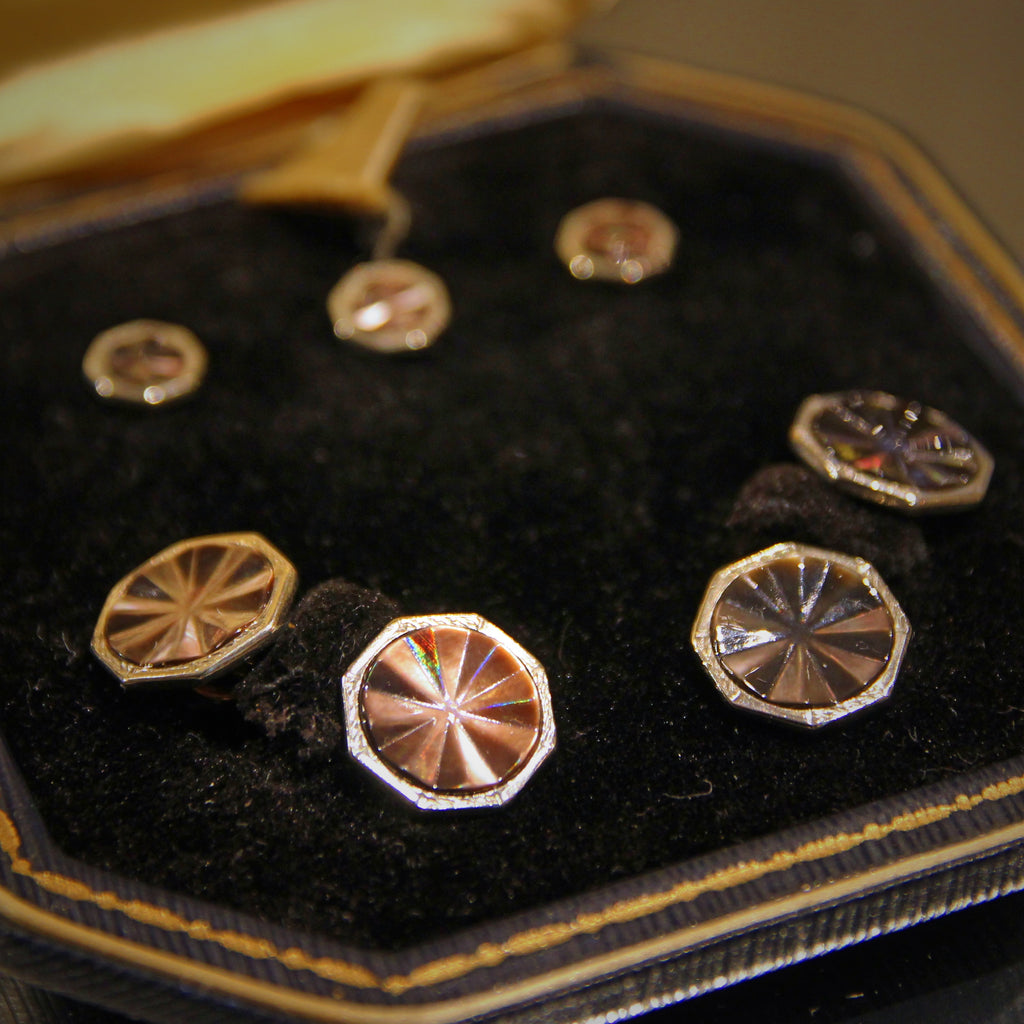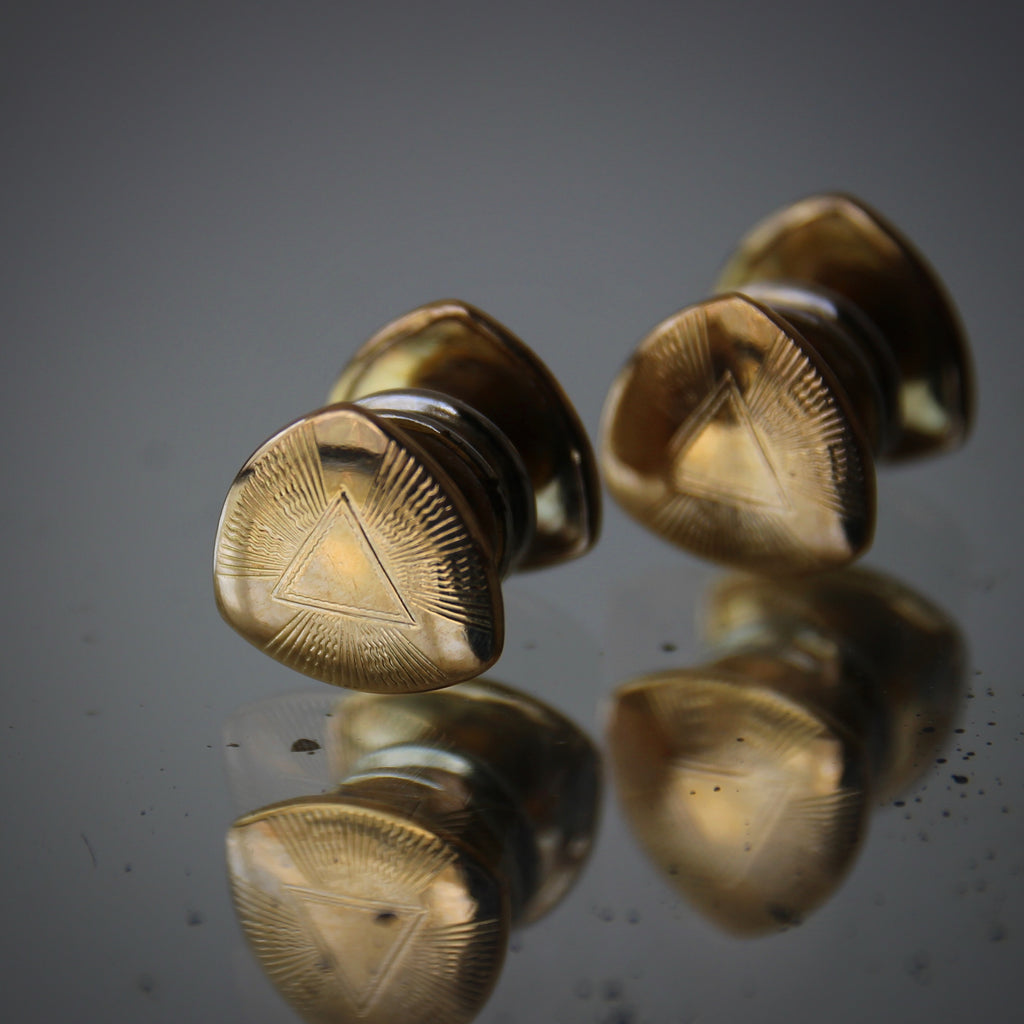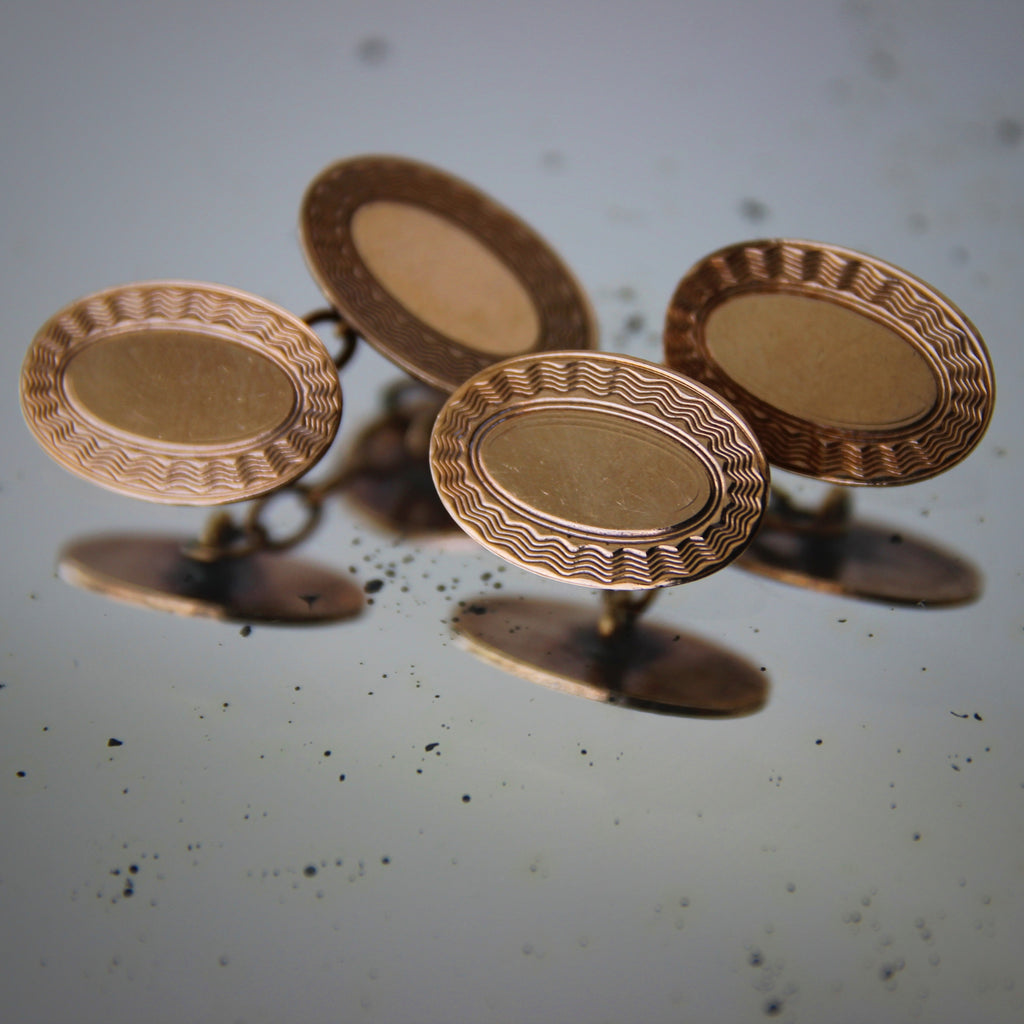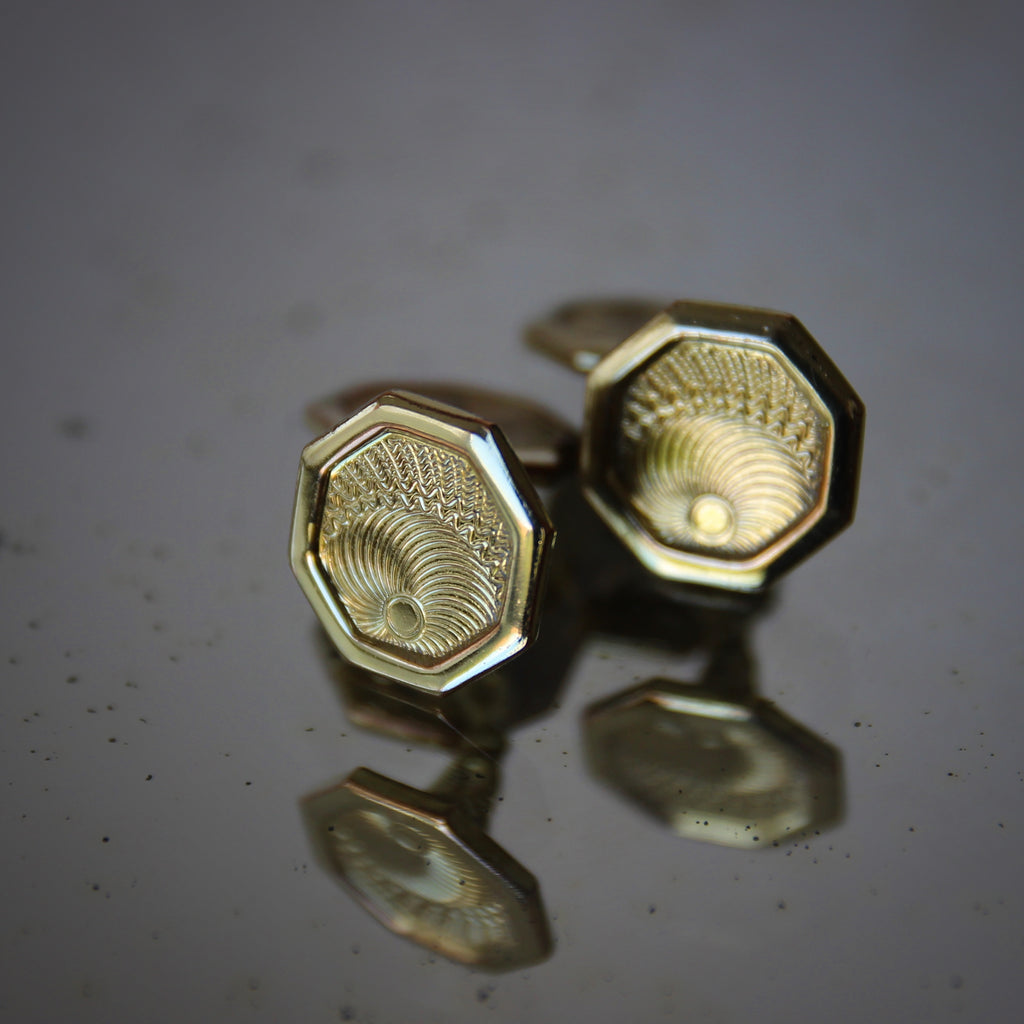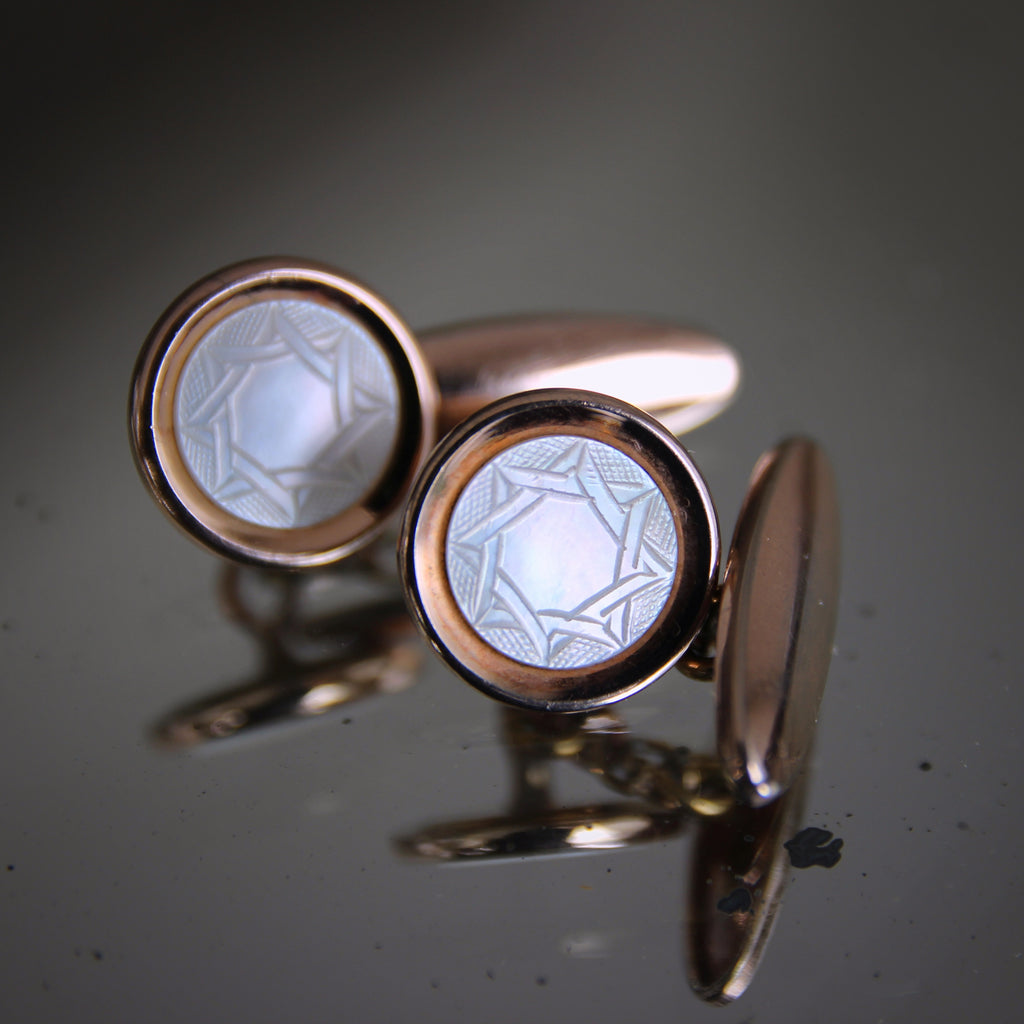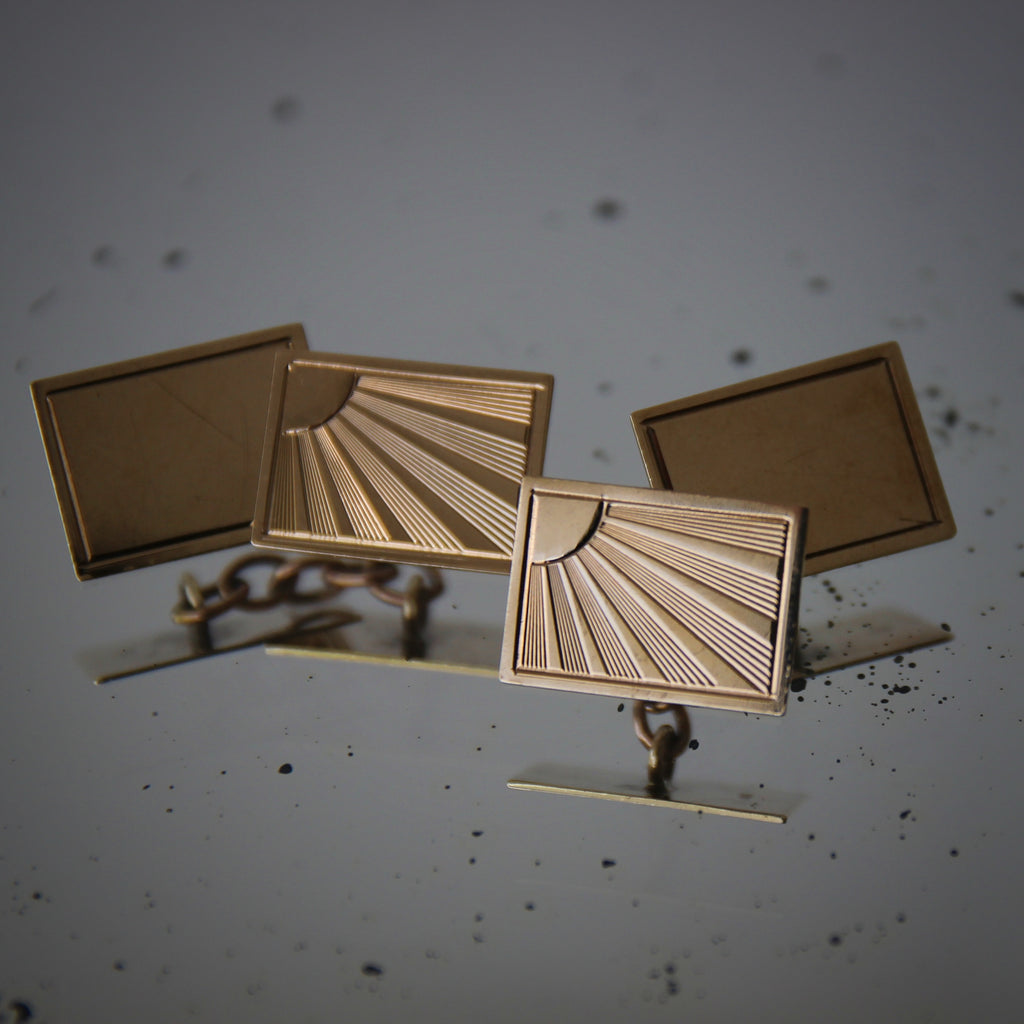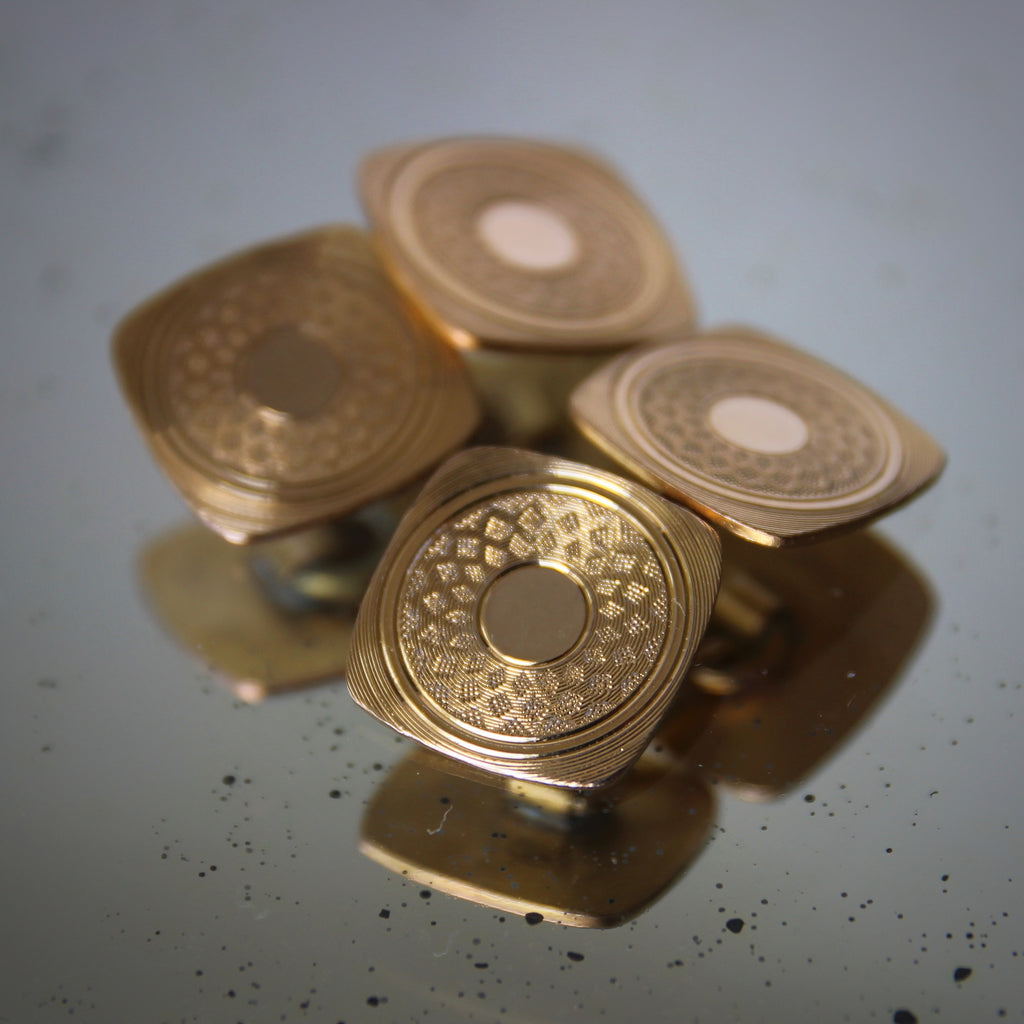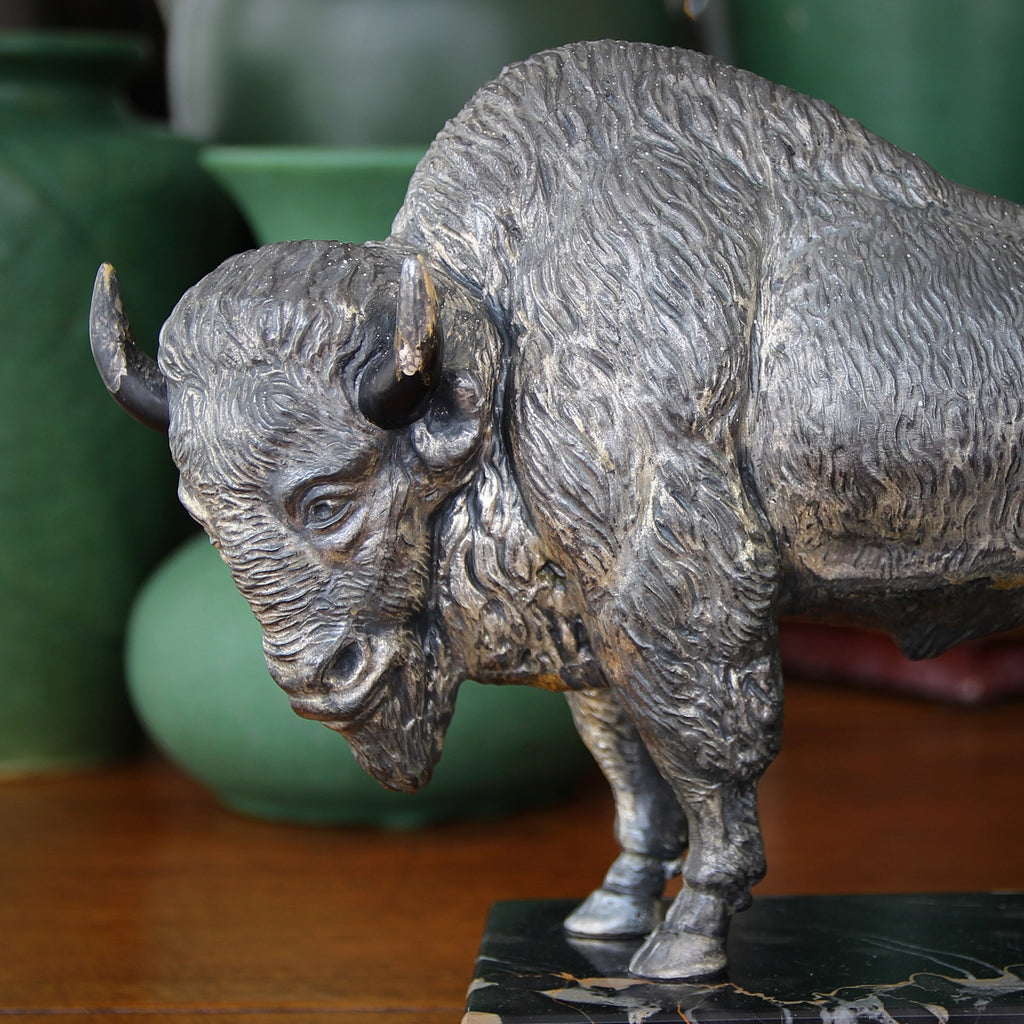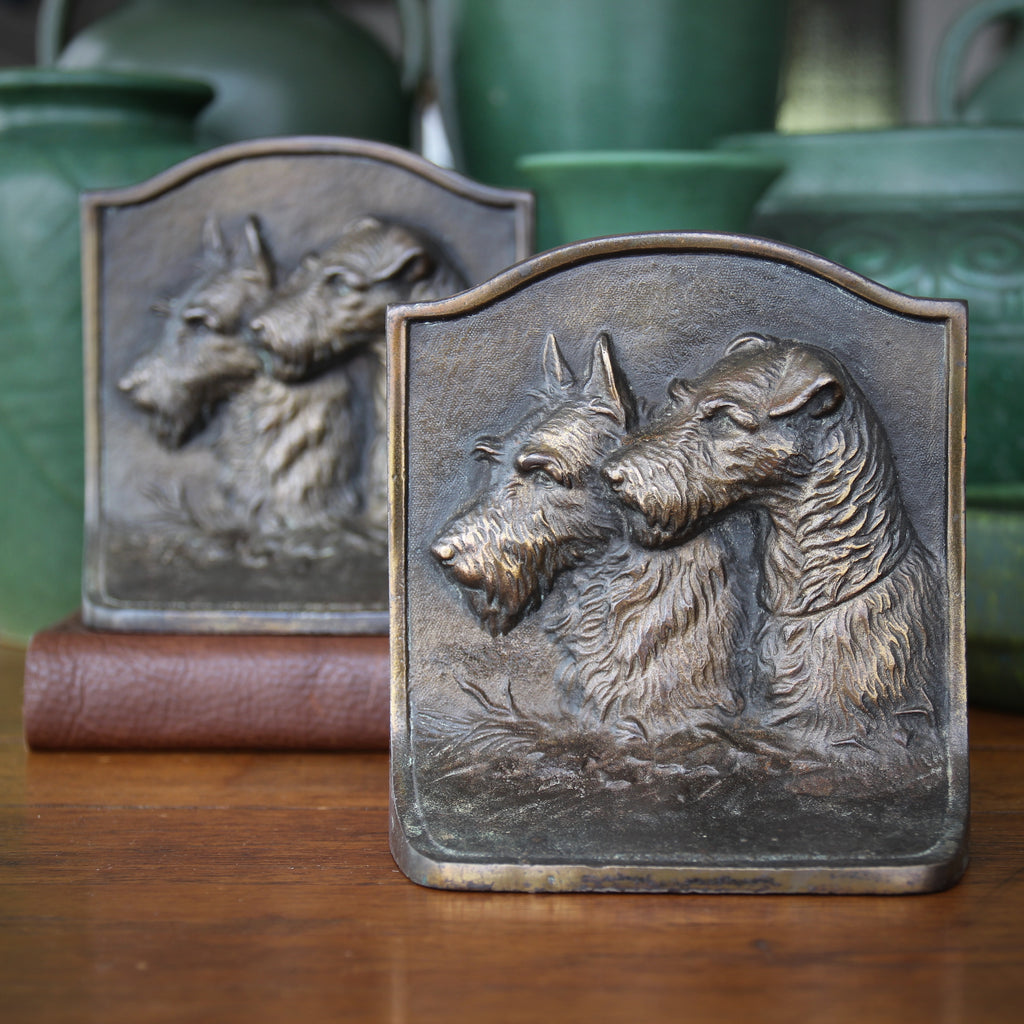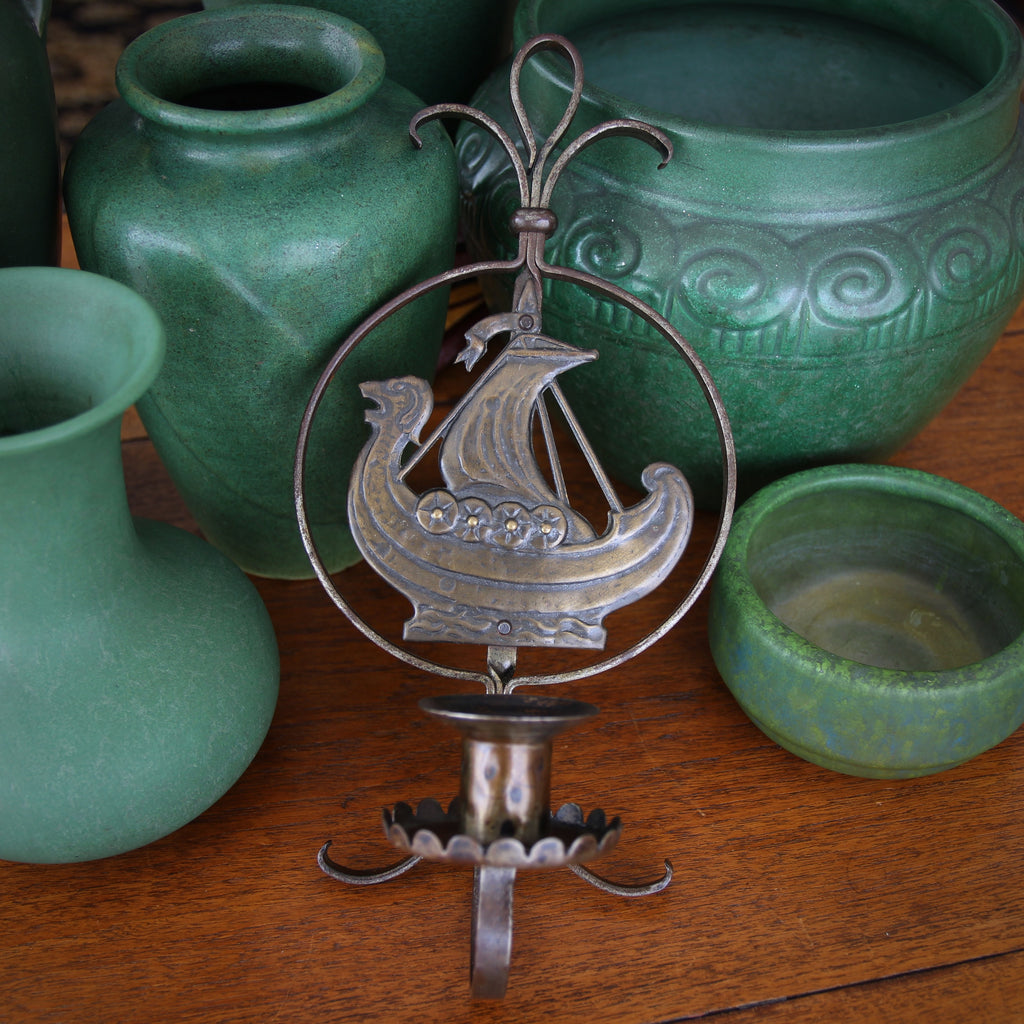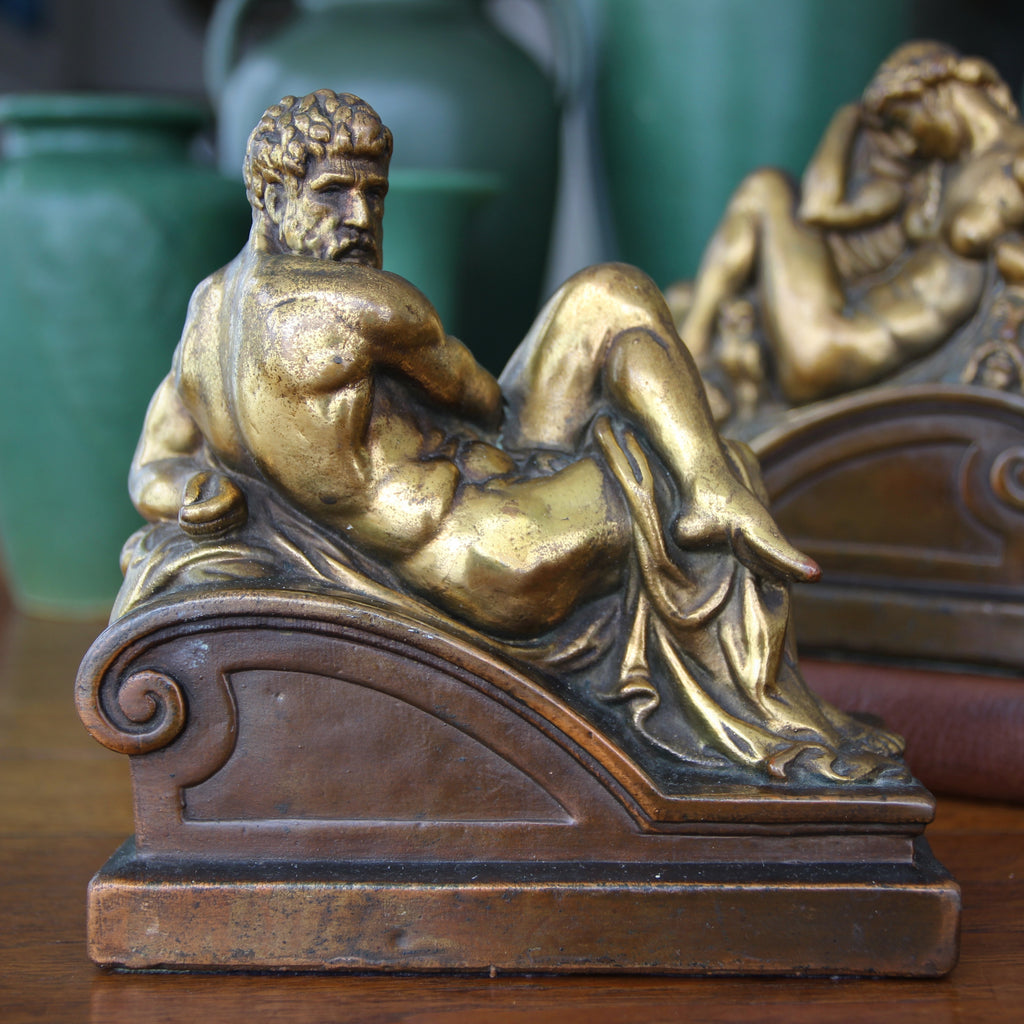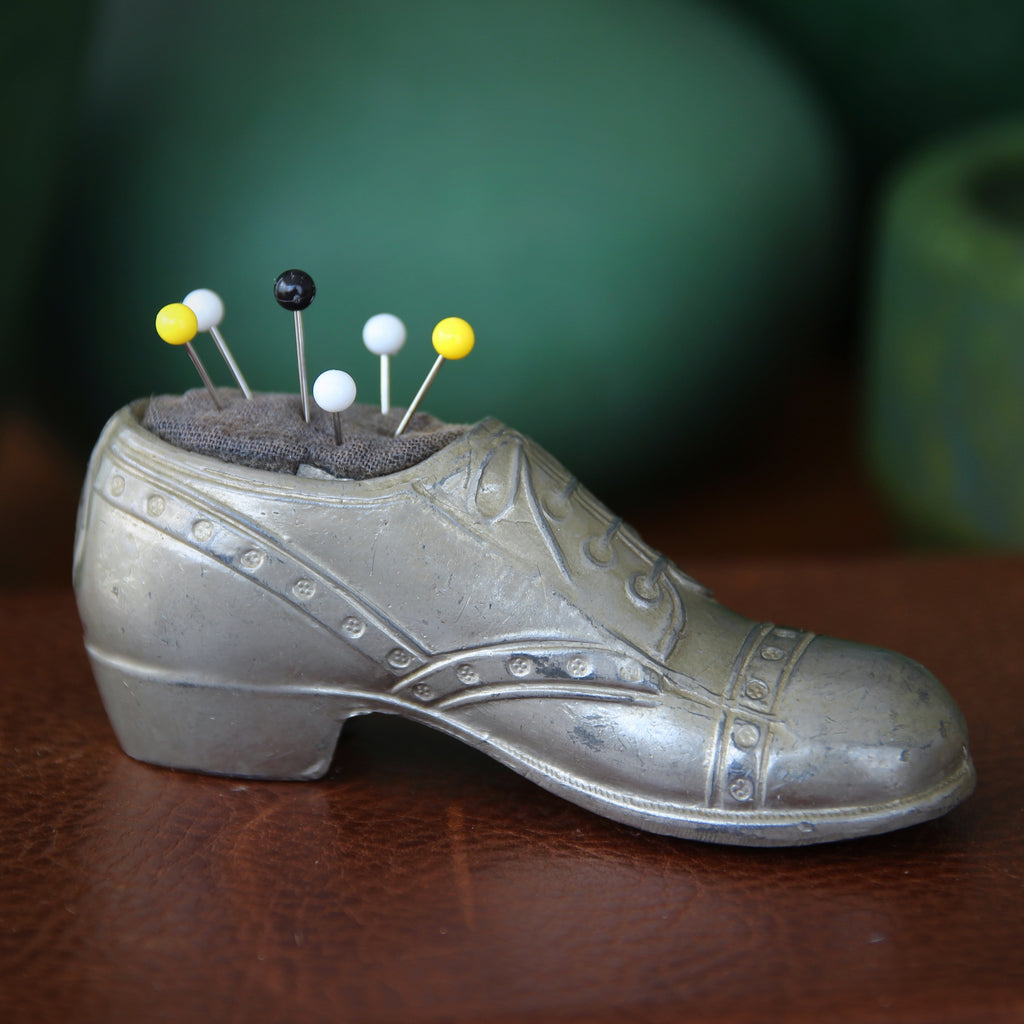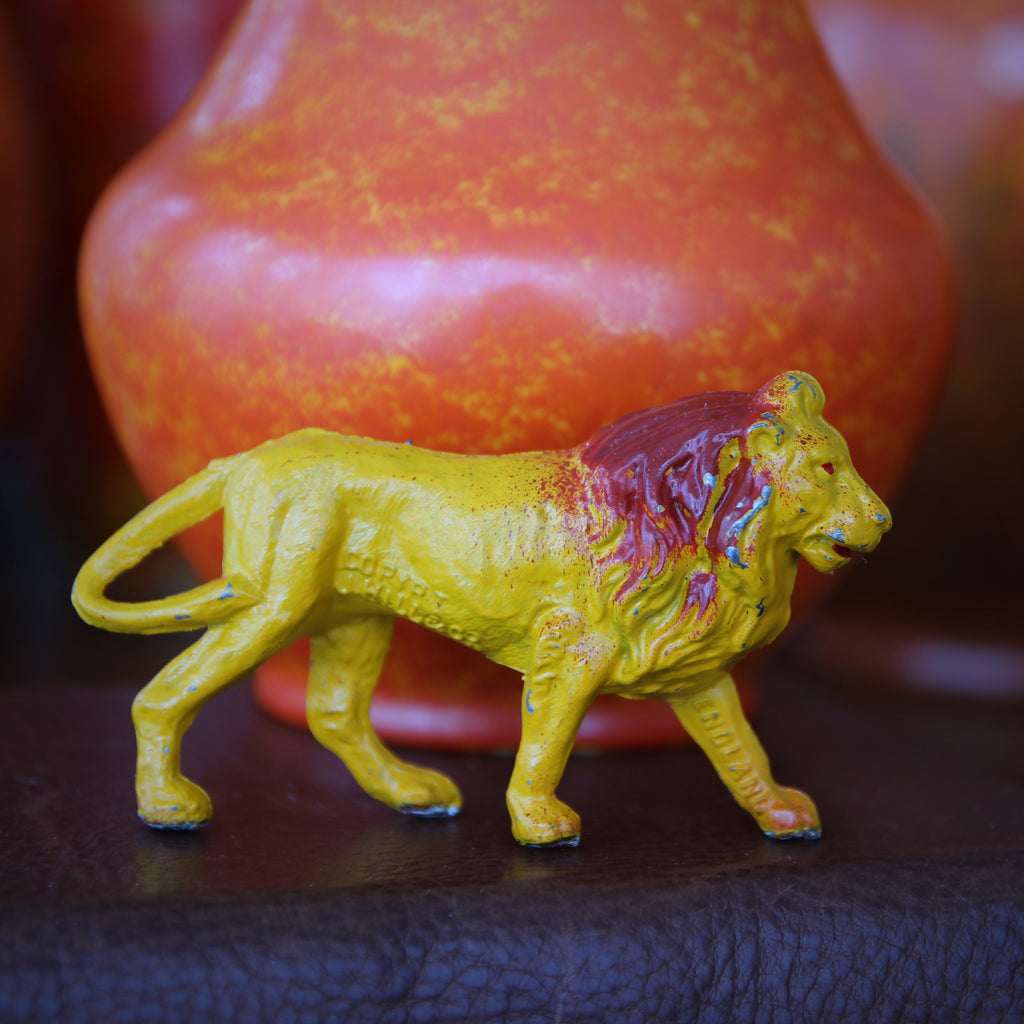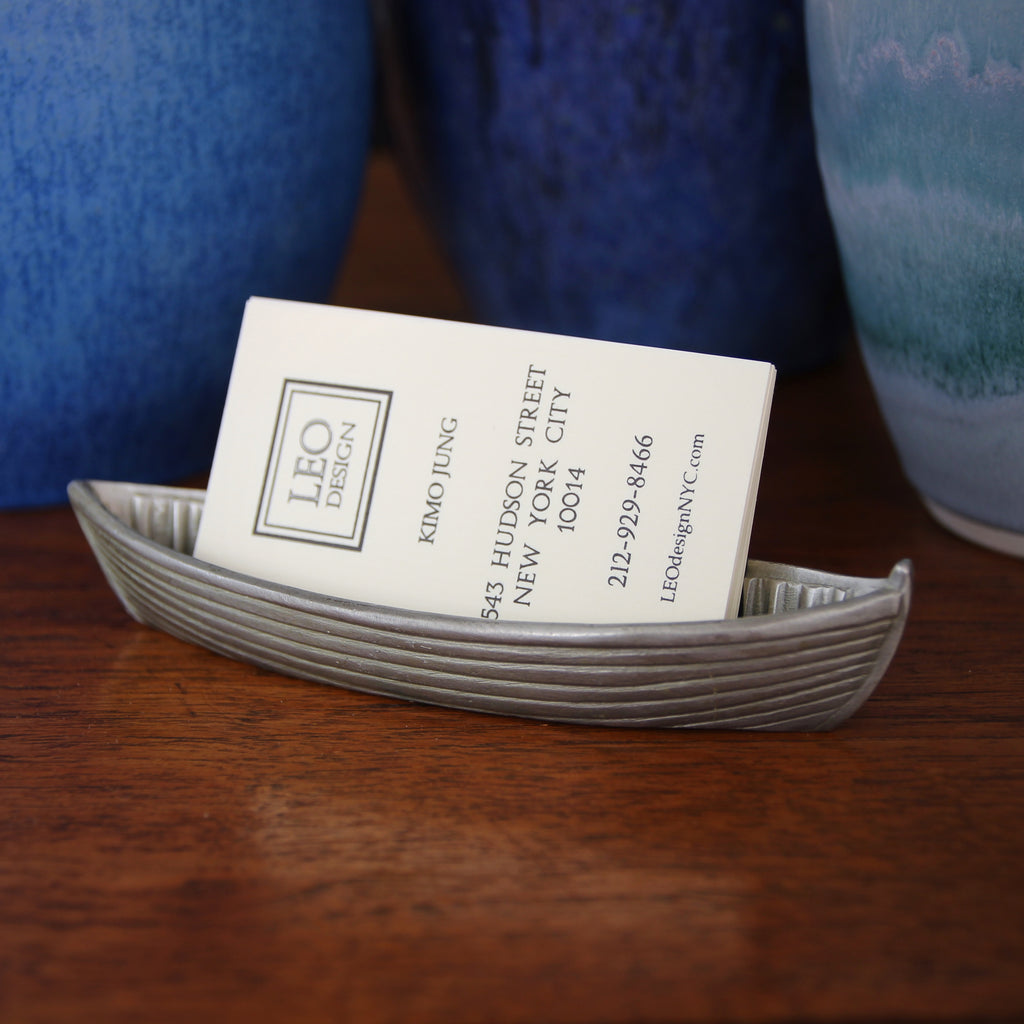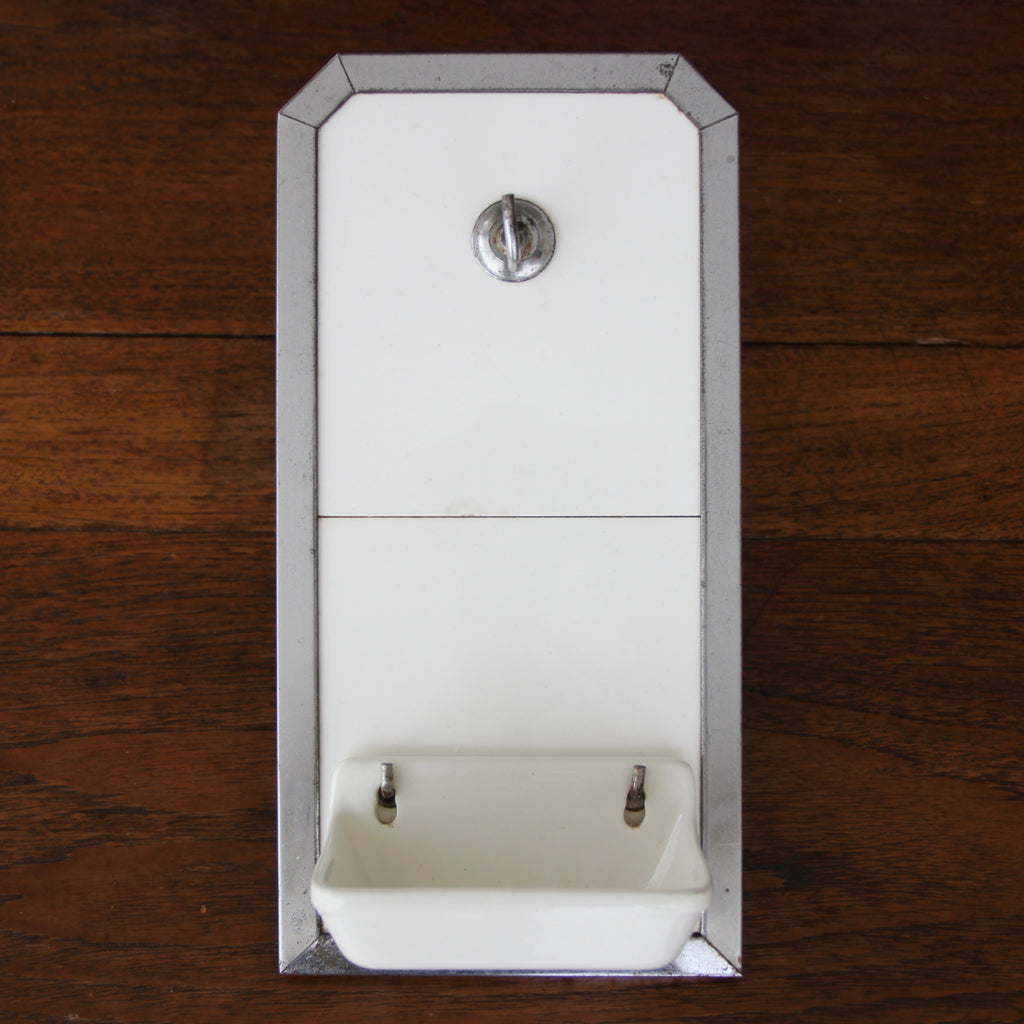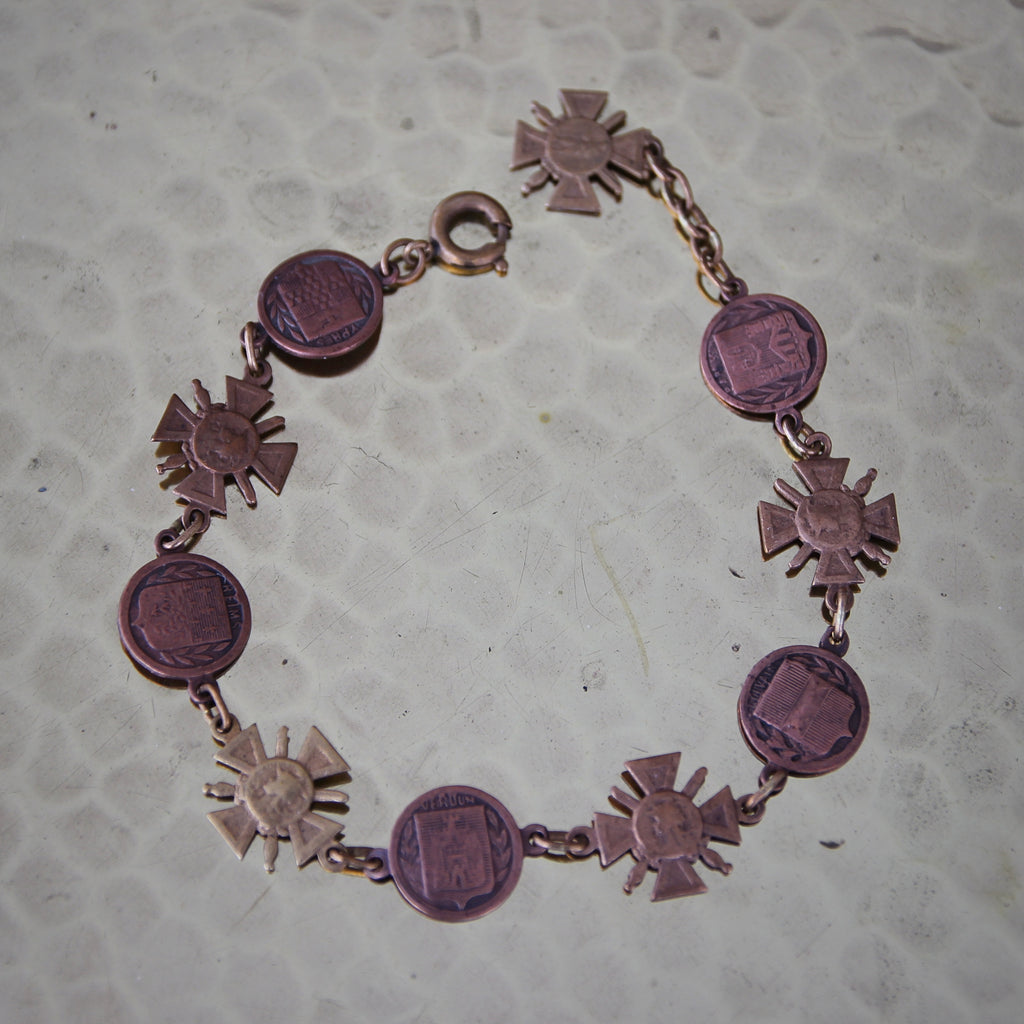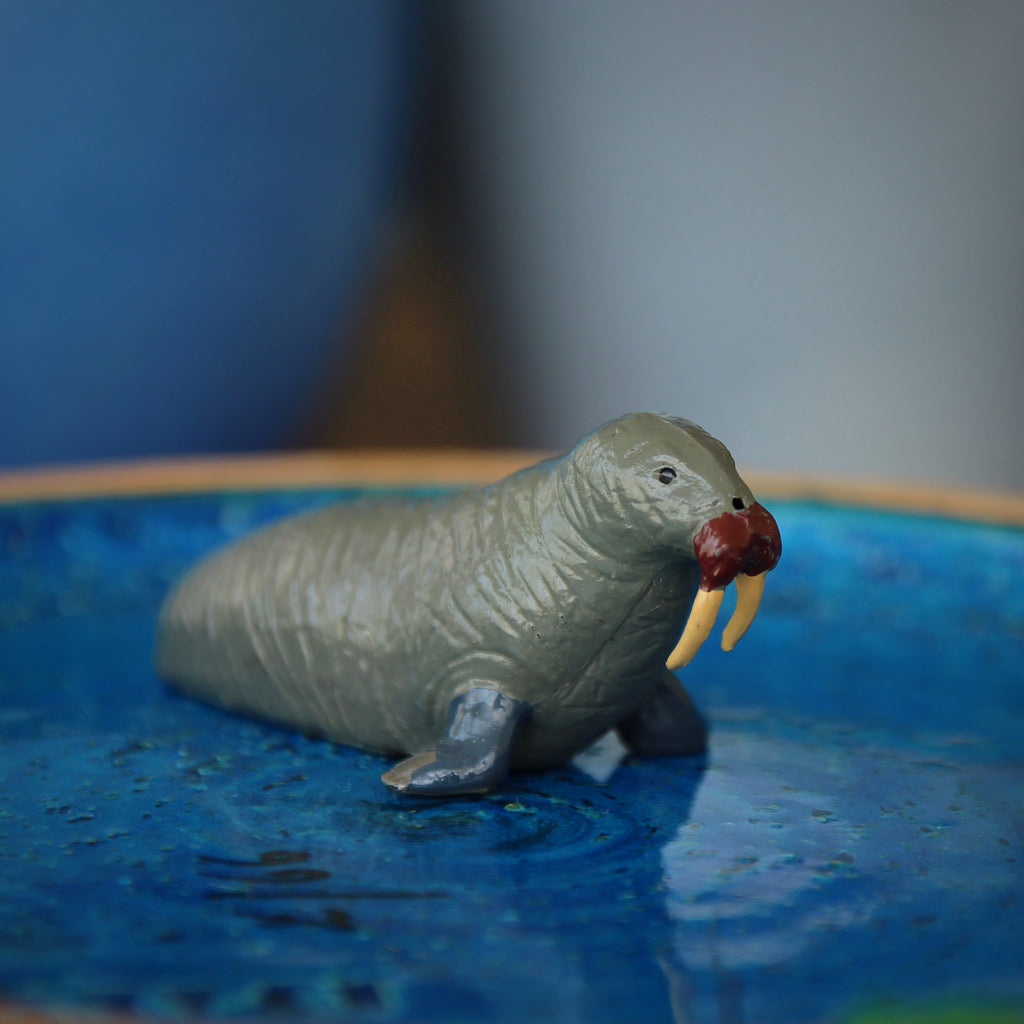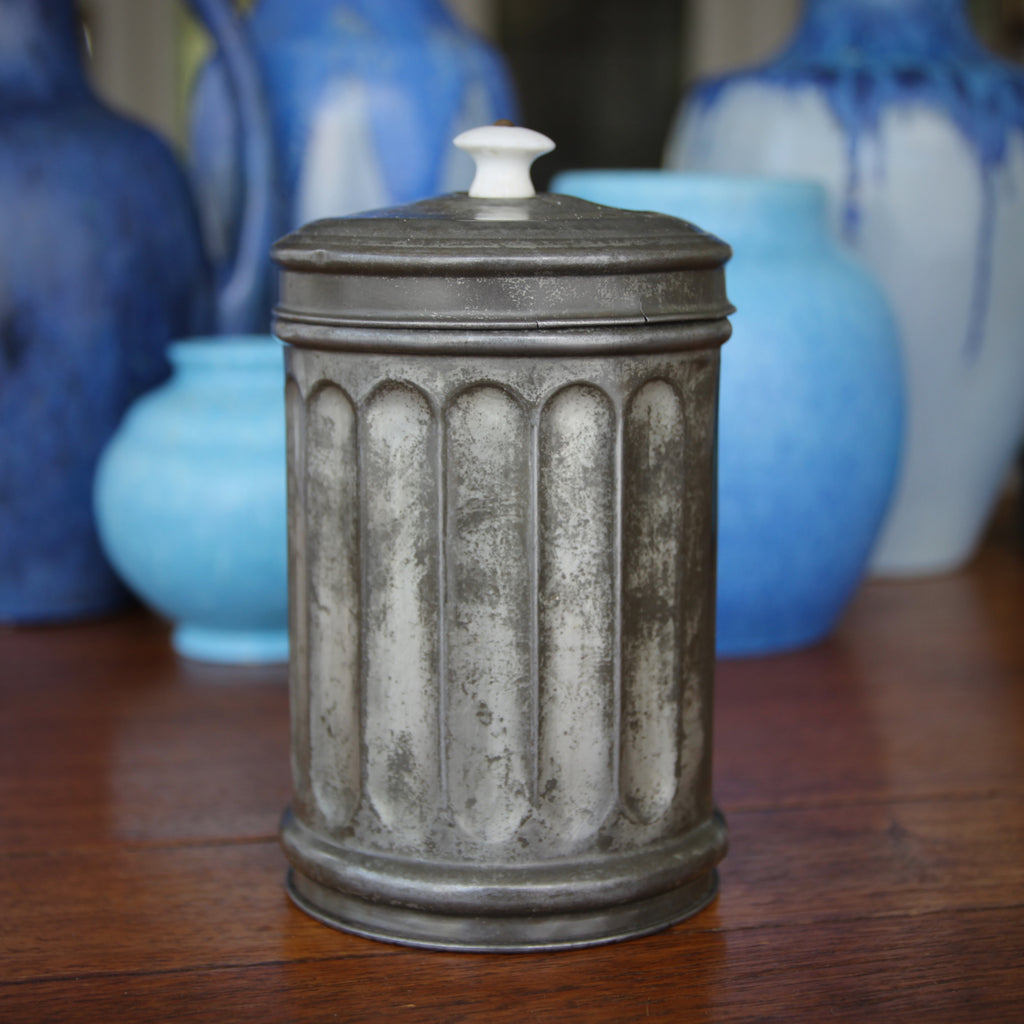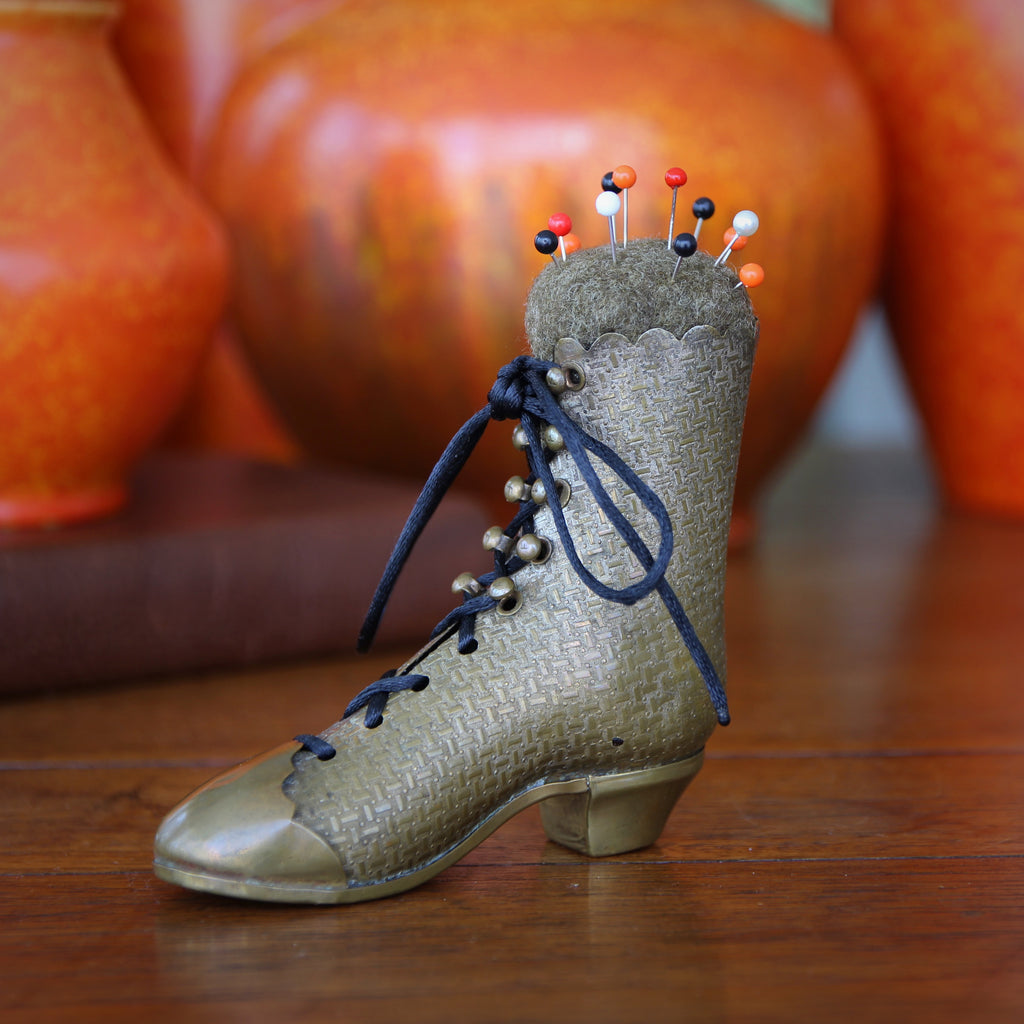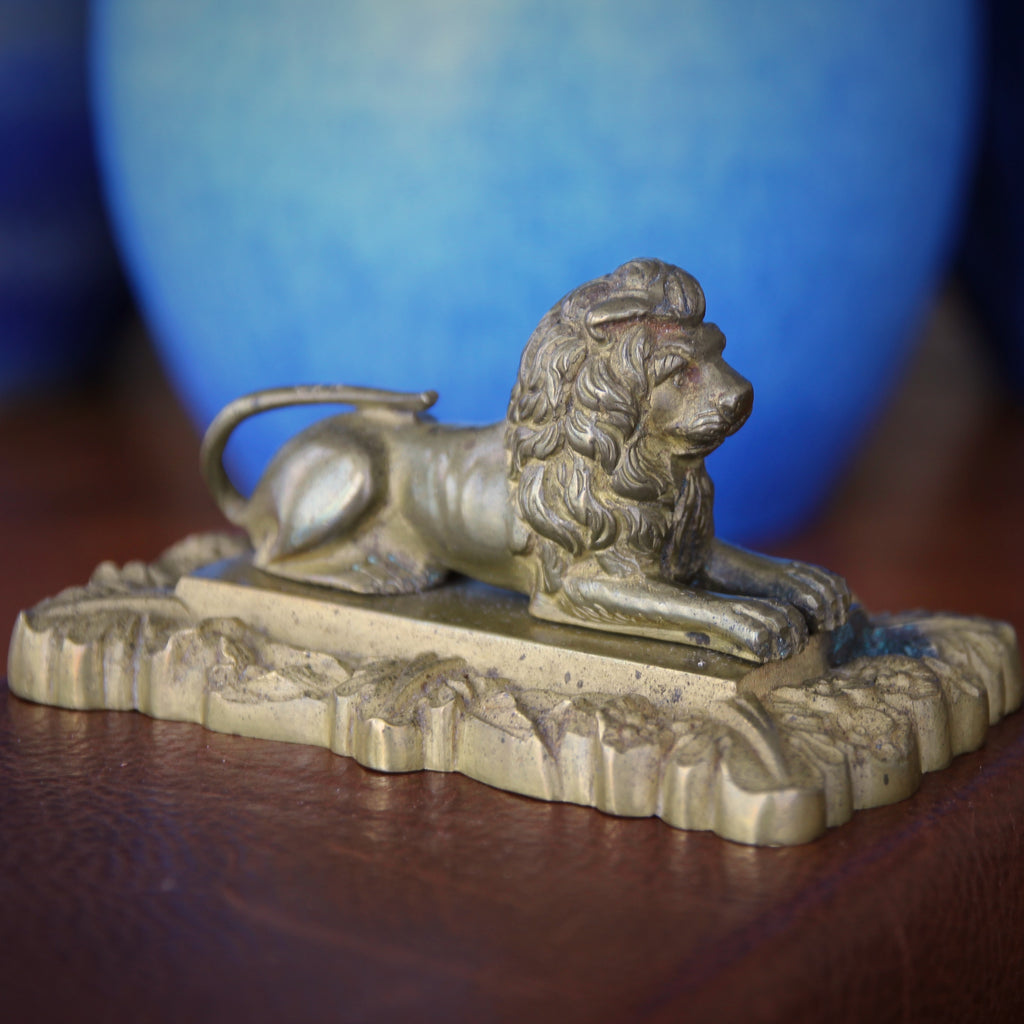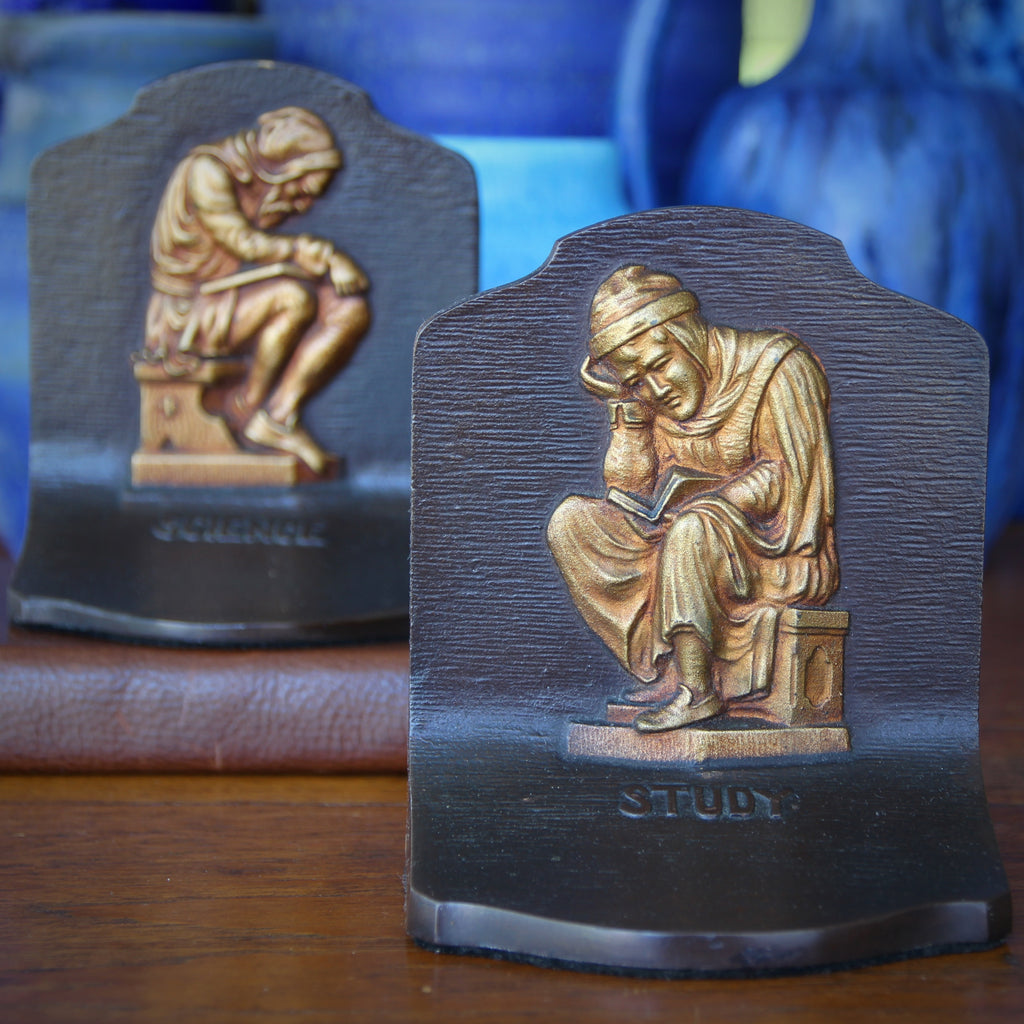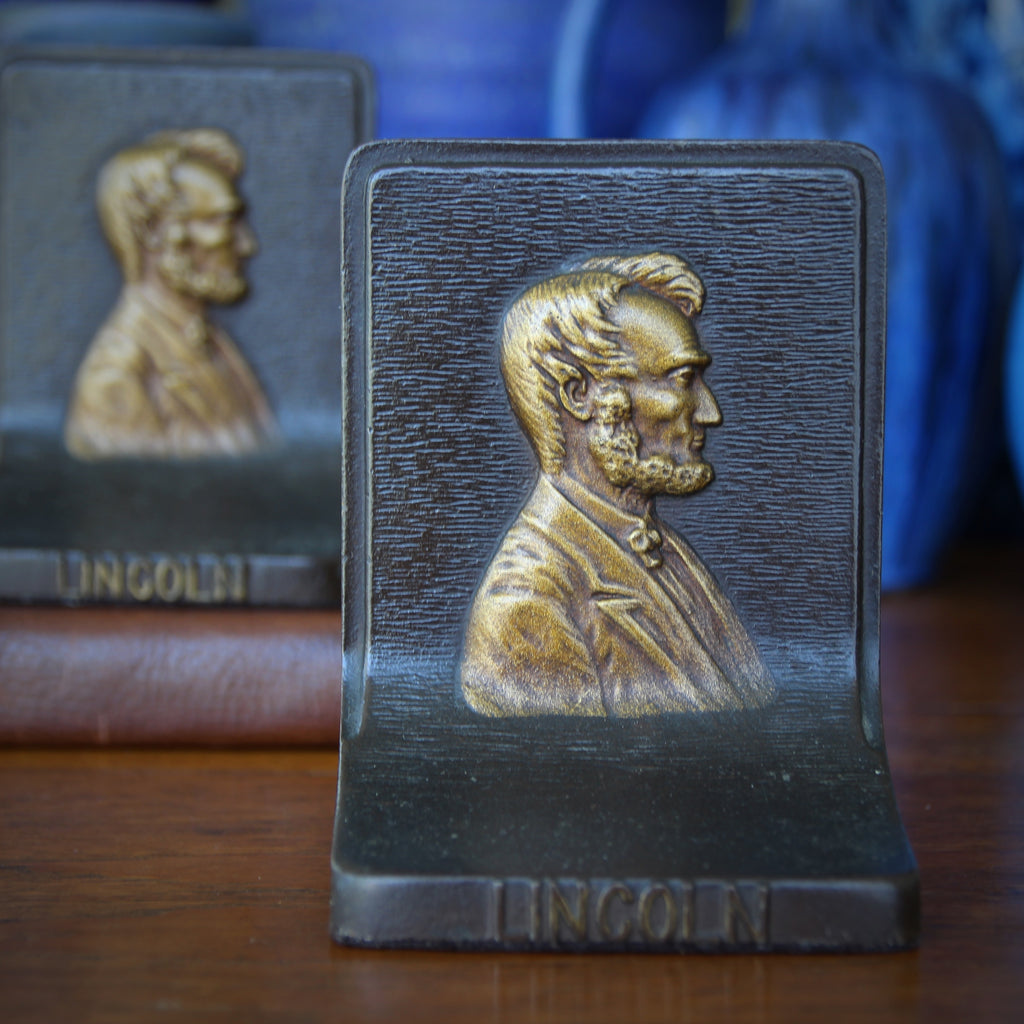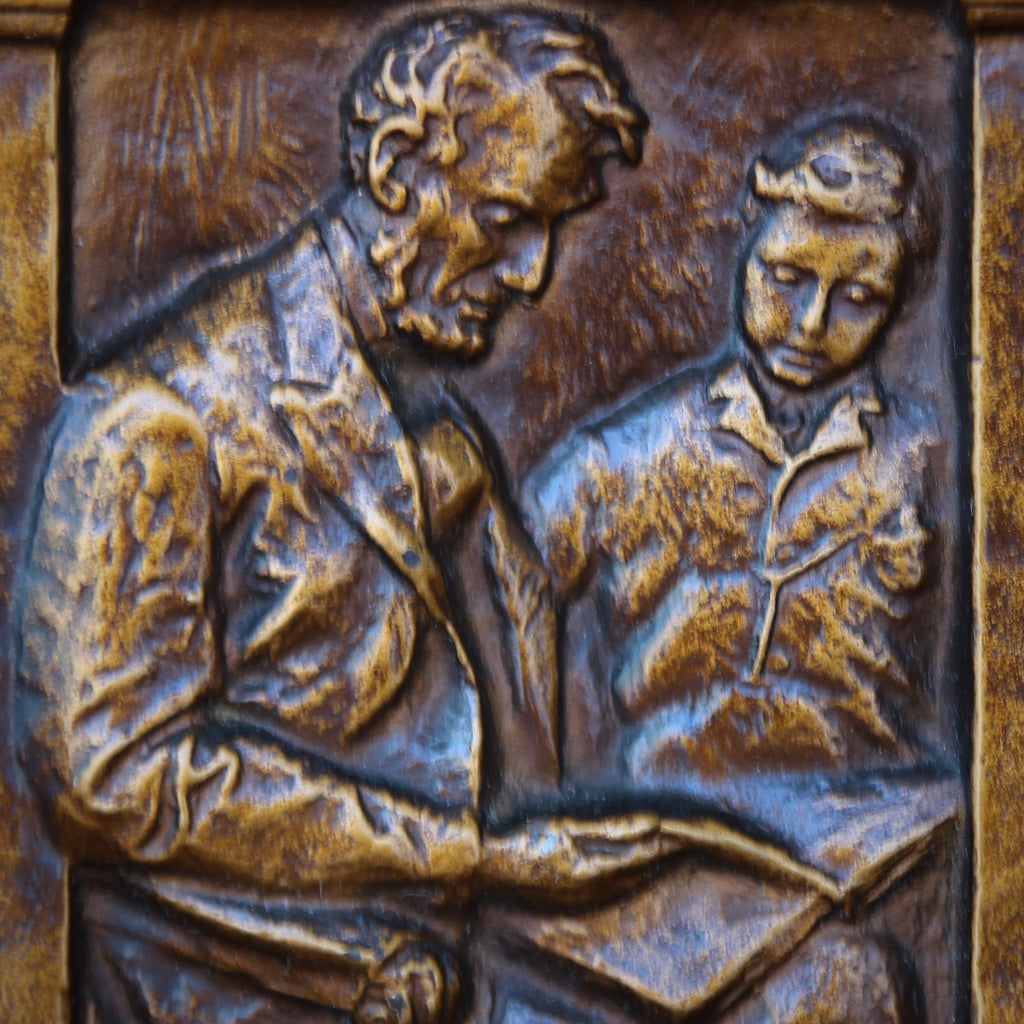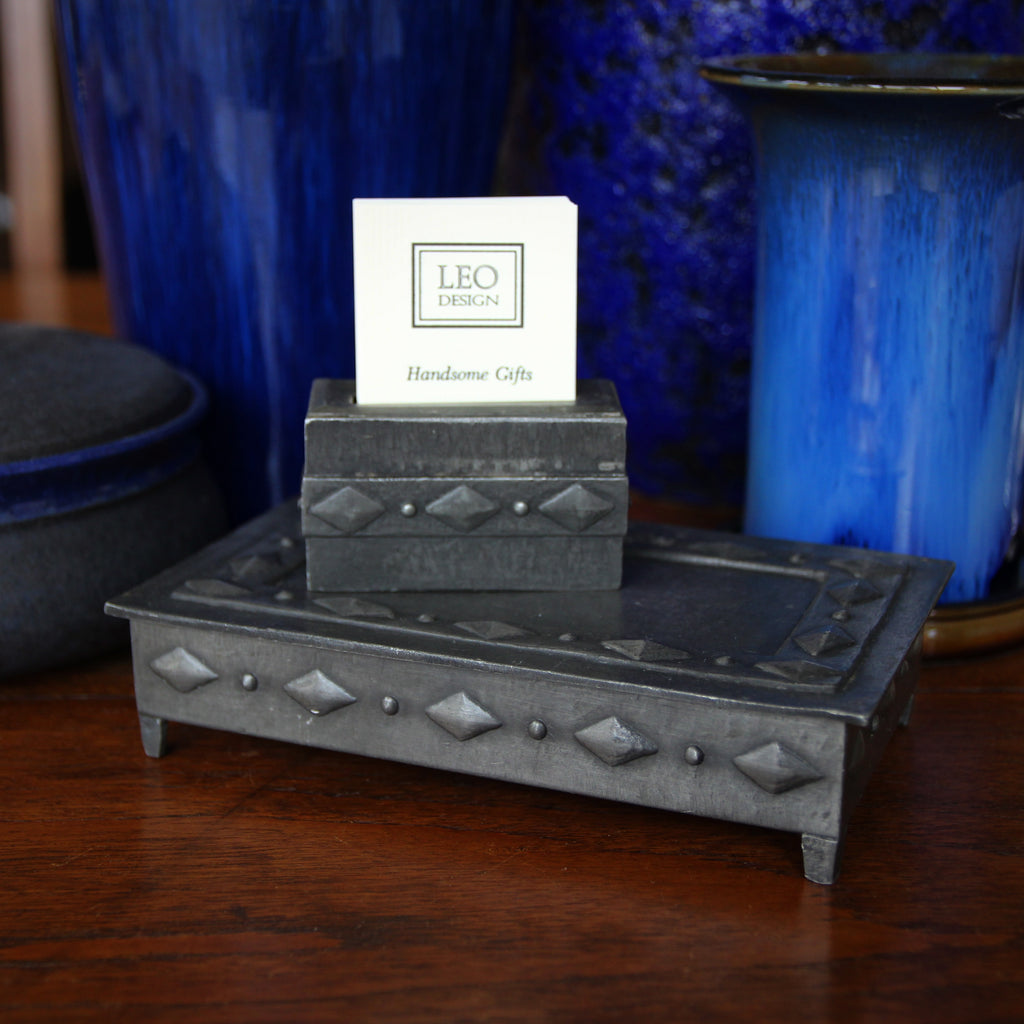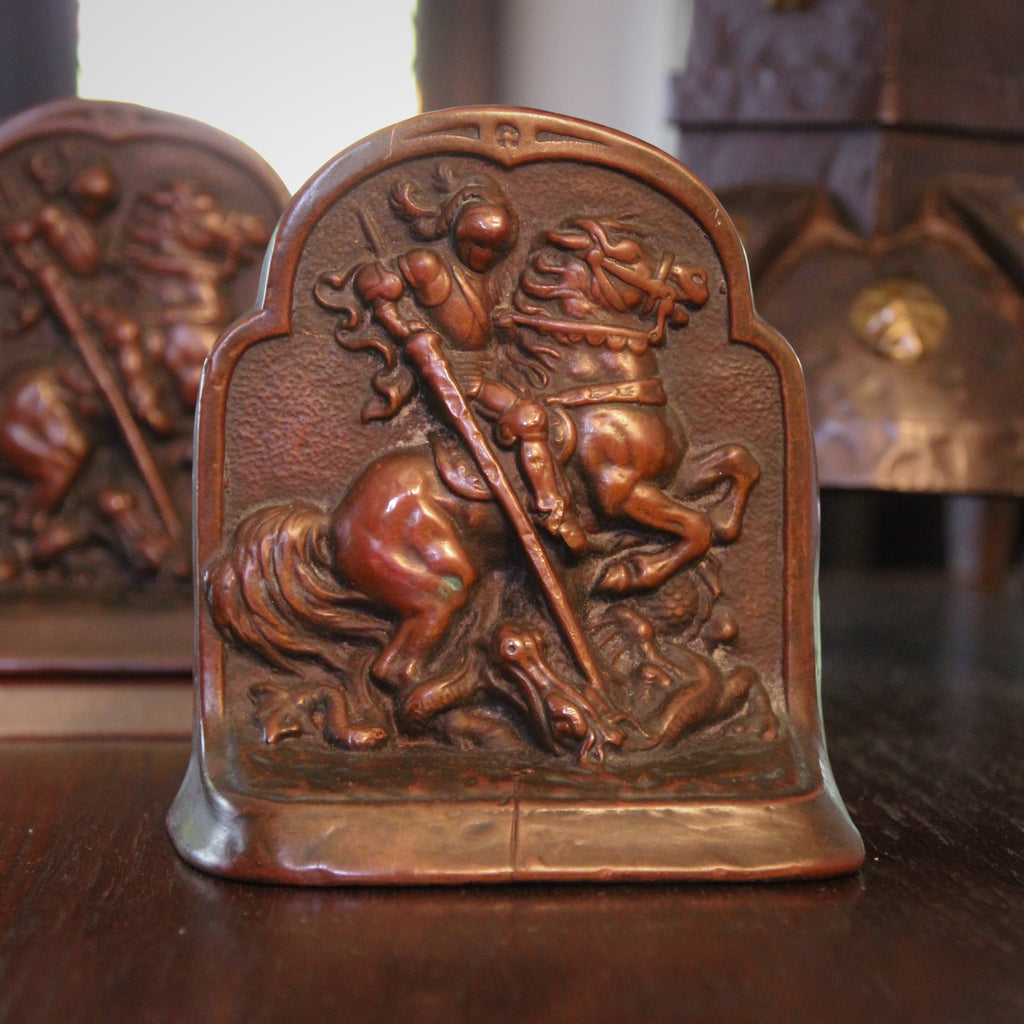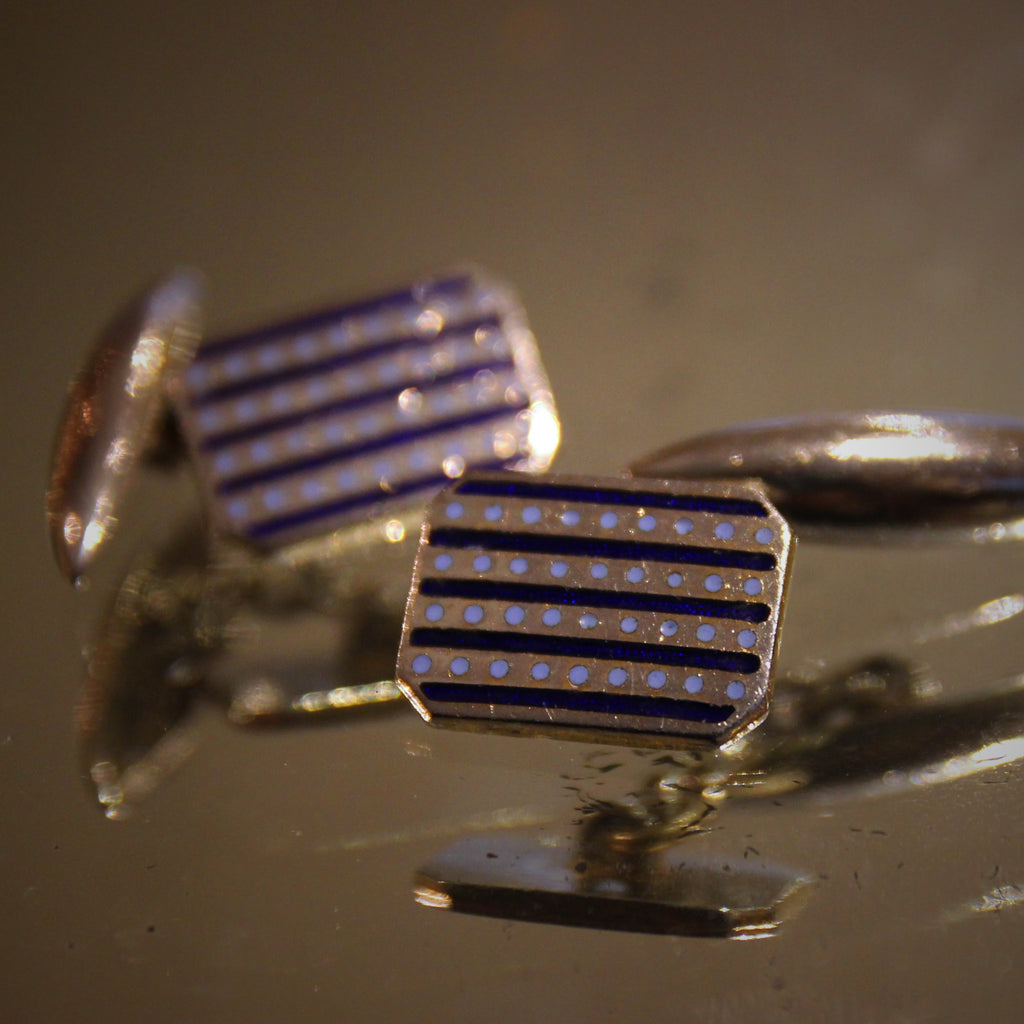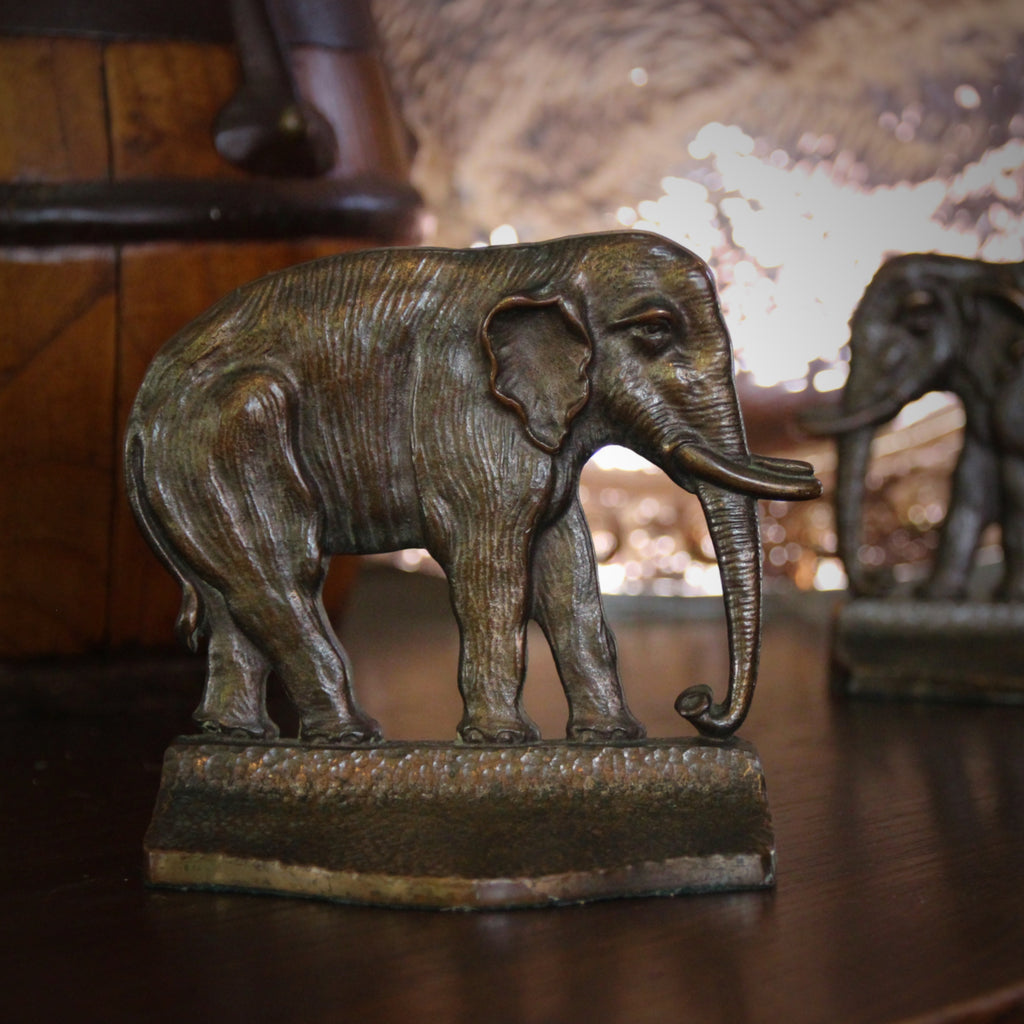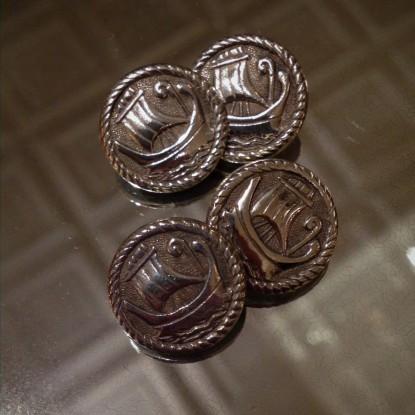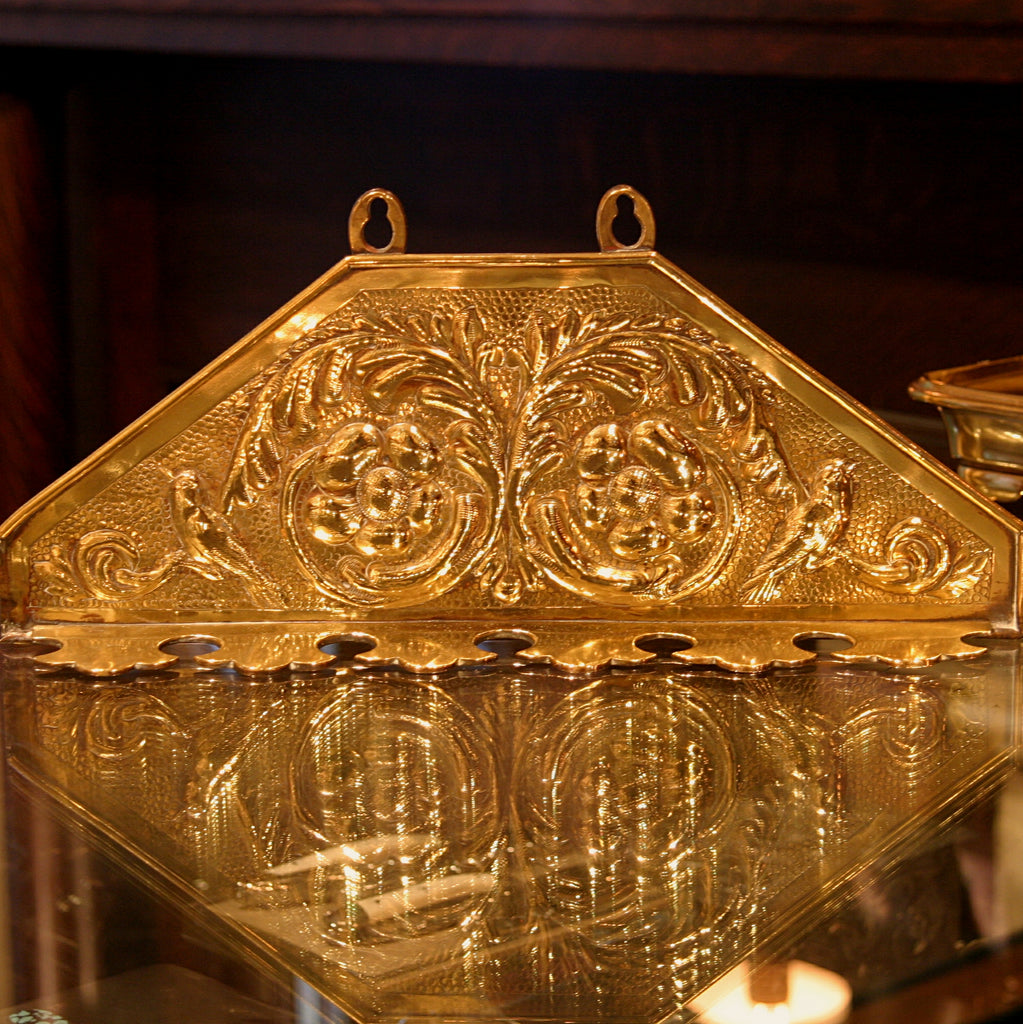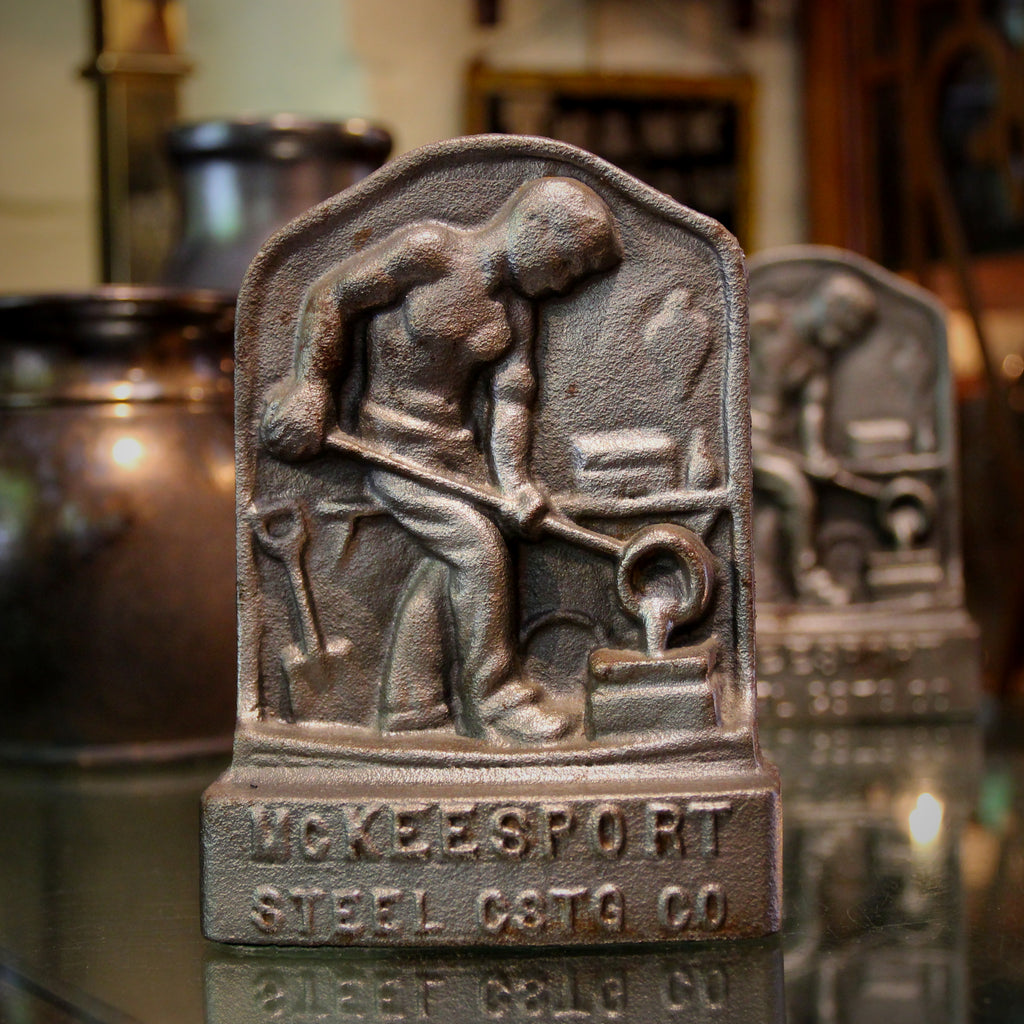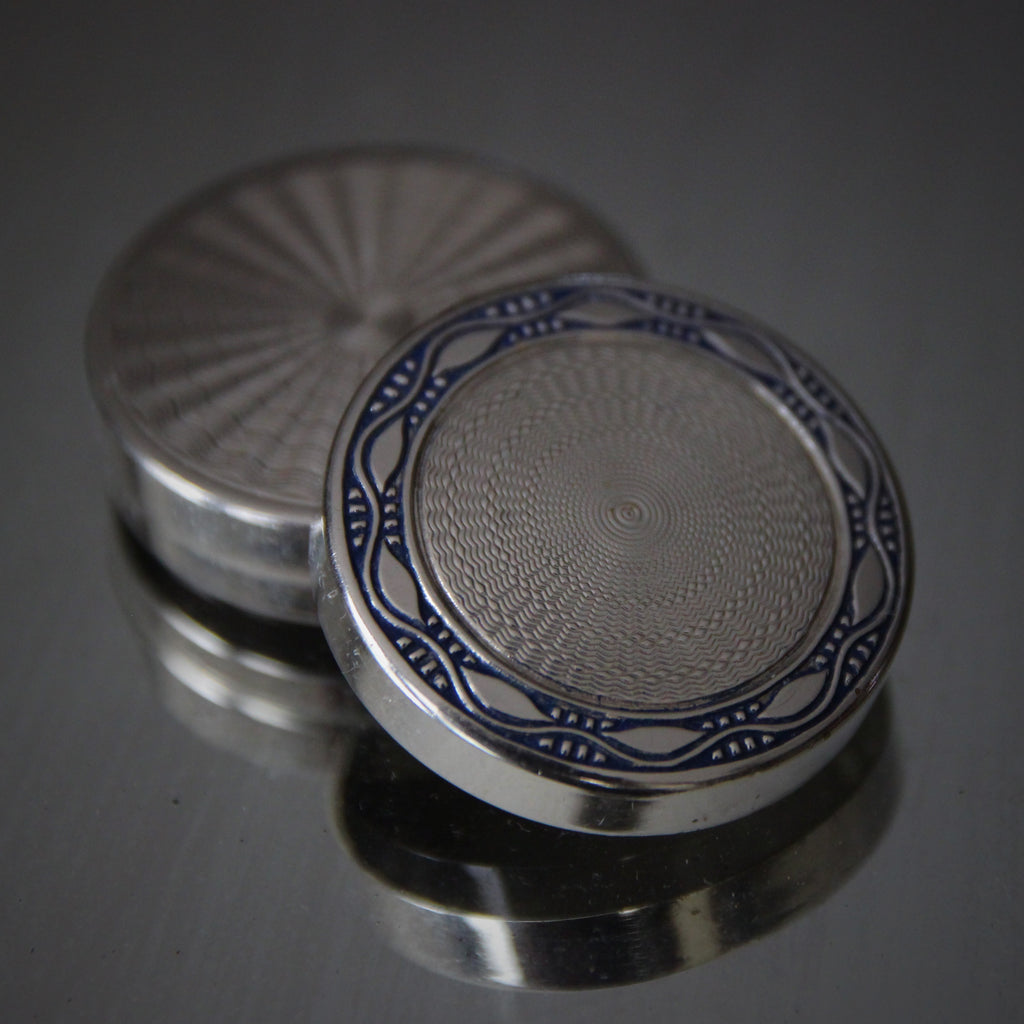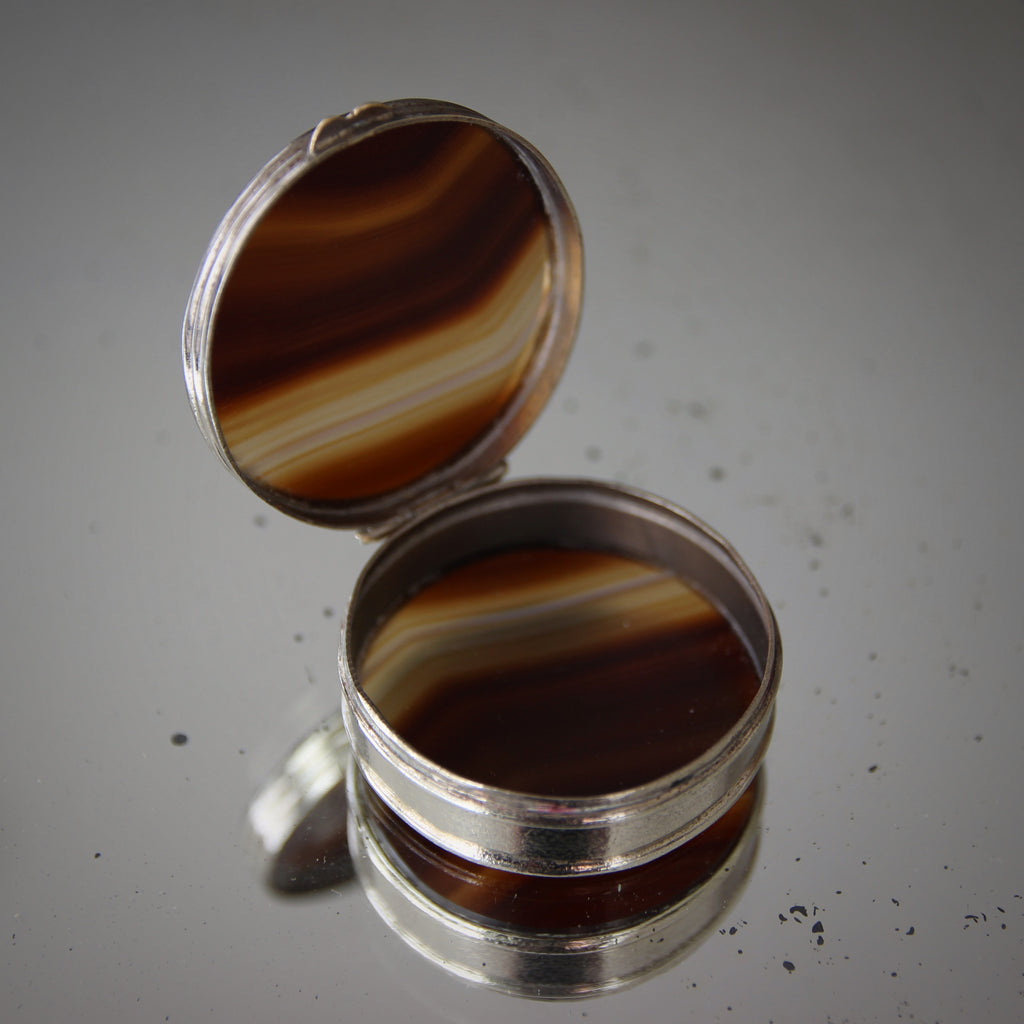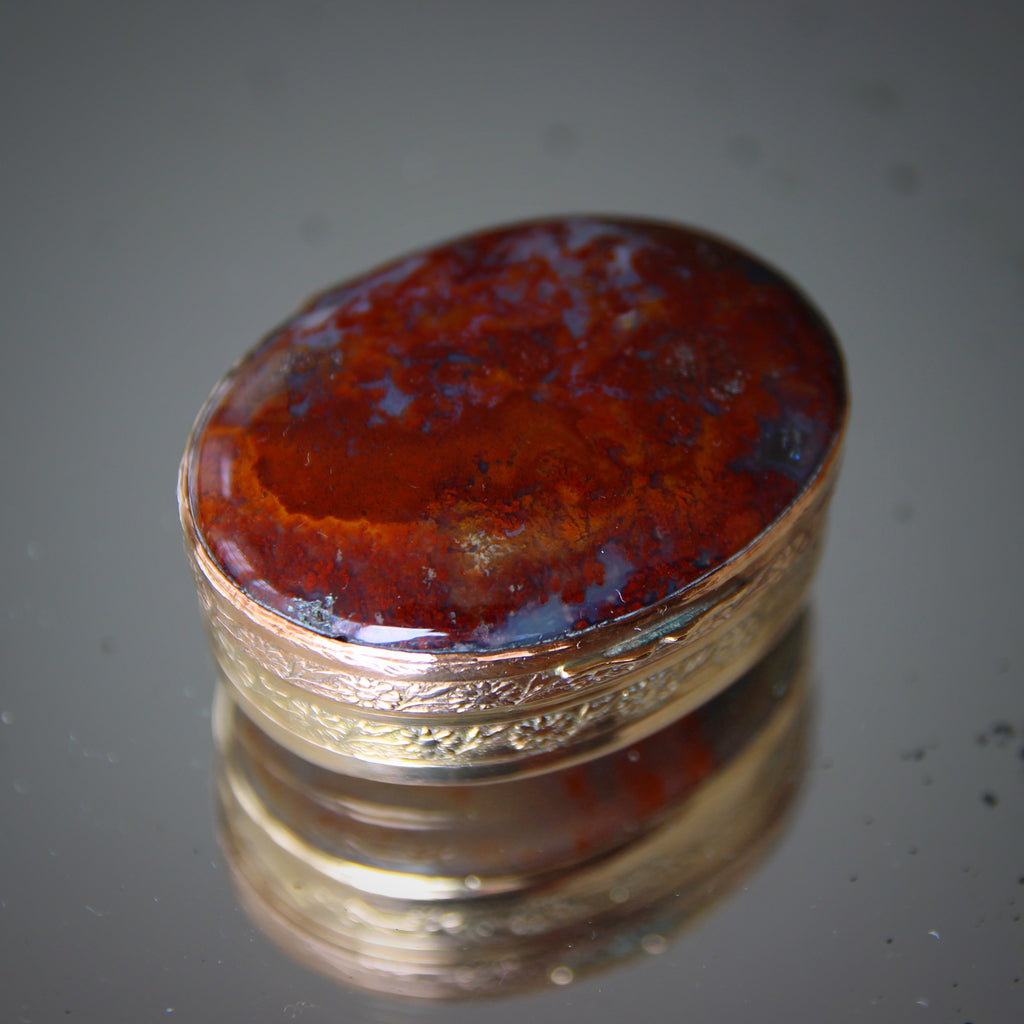JOURNAL — Metalwork RSS
In America, the word "casket" often is associated solely with coffins, those large boxes used to bury human bodies. "Casket" has become a "six letter word." However, if you spend more than ten minutes shopping for antiques in England, you'll hear the term "casket" used in its broader, original sense: a (sometimes ornamental) box used to hold jewels, jewelry or other precious objets. Most often, a casket is rectangular, small (or modestly-sized), with a hinged covering. It may or may not have legs. Caskets are intended to protect and present something of high value—which may explain why some Americans began to conflate the words "casket" and "coffin." This bronze casket was made in the Teens or Twenties for "La Tausca," the...
Art Unexpected
The very best art is that which conveys the greatest effect with the seemingly simplest effort. Michelangelo Buonarroti conveys the entire Biblical story in David's right hand alone: relaxed at his side, loosely cradling a killer stone, yet potentially, undeniably powerful—if ever pushed into action. John Singer Sargent can capture—in one long brushstroke—the sheen and contours and tension of a woman's elegant dress, draped over underskirts, stretched over crossed legs, lighted from a window (elsewhere in the room). And the incomparable voice of Karen Carpenter—without vocal gymnastics and with no affectation—can effortlessly pierce our hearts with melancholy and longing while singing Superstar. The greatest artists know how to communicate great or complex or heartrending understanding in the most economical manner. Great...
Forever Copper
Copper has always been one of my favorite materials. I love the soft, warm color. I adore the way it darkens richly with age—ever so s-l-o-w-l-y. And I cherish the way the soft metal accepts (and preserves) any evidence of the craftsman's handwork: hammering, threading, etching. There's a reason that this element is called "The Eternal Metal." It is stable, unchanging, and remains reliably useful. Copper has been popular in many aesthetic movements, including the Arts & Crafts school.
This brushed-copper 4" x 6" photo frame, made in Italy, has a wooden back and easel stand (which allows it to be displayed horizontally or vertically).
Fall Back
Set-back your clocks (one hour) tonight before bedtime. Daylight Savings Time ends in the wee hours of Sunday morning. Twice a year (that is, whenever we switch the clocks), the controversy is revived: should we even continue using Daylight Savings Time? The semi-annual arguments provide plenty of heat, though very little light (pardon the pun). One-third of Americans want to stick to Standard Time year 'round. One-third of Americans want to stick to Daylight Savings Time year 'round. And one-third of Americans either don't know or don't care. My conclusion: all three options have serious downsides. Personally, I can live with the changes of the clock, knowing that I will benefit from more light in Summer evenings and more...
Just a Little Fun
When Queen Victoria's beloved husband, Prince Albert, died in 1861, Victoria (and the entire British Empire) went into mourning—an expression which manifested itself in fashion, jewelry and the decorative arts. Victoria remained in mourning for the rest of her life—forty years of black clothing and heavy, sombre jewelry (nothing frivolous or too jolly). This four-decades-long period of sobriety had a tremendous impact on the aesthetics of the day. Personally, I have always liked the heavy and serious, but handsome decorations of the day, mourning jewelry included.
Coining Words
The legendary Bard of Stratford-on-Avon created some of English Literature's greatest characters, tortured relationships, and dramatic scenarios. He coined numerous words and many clever turns-of-phrase. And he also spelled his name in a variety of ways. Some scholars claim that "William Shakespeare" (which is the contemporary standard spelling) has been spelled up to 80 different ways over the centuries. Even in his lifetime, Shakespeare signed his name with different spellings—including "Shakespere" and "Shakspeare." In the Eighteenth Century, "Shakespear" was believed to be most authentic. In the Romantic Mid-Nineteenth Century, "Shakspere" or "Shakspeare" (as shown in the photo) was considered most accurate, based on his most common signatures. On Shakespeare's tomb, in Holy Trinity Church in Stratford-on-Avon, the Bard's name is...
More Light
Autumn is here. As the days grow shorter—and the nights longer—we lose more and more natural light. We spend more time indoors, especially in the evenings, and need (and crave!) more light. It's no surprise, then, that we see a seasonal spike in lamp purchasing in the Fall and Early Winter months. Although we have sold hundreds of antique lamps over the years, I have also carried this line of handmade contemporary brass lighting (from New England) since our first year in 1995. This Library Table Lamp is one of our recent additions to the selection. It has a handsome, traditional style and would look equally handsome on a desk, on end tables, or even on a mantelpiece. It holds...
All Elephants Are Lucky
I've sold dozens of elephant bookends over the years. Elephants have always been a classic and popular theme in "bookshelf accoutrements." I guess I also like the idea of promoting the welfare of elephants living today—both those in captivity and those in the wild. At some point—I guess it started with the Feng Shui trend of the Oughts—a minority of customers would refuse to buy any elephant unless its trunk was turned upwards. "It is unlucky, otherwise," they would say. Now, in truth, when dealing with items made 100 years ago, there was nothing I could do to change the direction of an elephant's trunk. I would best remain happy to buy a nice elephant, regardless of the point of its proboscis....
Coasting With Class
Yesterday we shared a set of four glass and sterling coasters—heavy, ponderous, traditional. Today we share a lighter, cleaner, and (I would say) more elegant offering. The pierced sterling silver galleries provide crisp punctuation to the glass bases—which have been etched with an ultra-simple star pattern.
These Post WWII coasters have a Modernist sensibility—though their light appearance gives them a classic and timeless appearance. Click on the photo above to learn more about them.
I Am Not Your Ashtray
Post War exuberance opened the door to an explosion of gracious entertaining in the late 1940s and 1950s. "Little Luxuries," like these pressed glass coasters with sterling silver rims, provided an elegant setting for a mixed drink in a highball or stemmed Manhattan glass. This set of four coasters are marked "Sterling" and with the name of the maker, "Frank M. Whiting - North Attleboro, Massachusetts."
On many an occasion I've seen these being sold as ashtrays (which they were not) and I've even seen (recently-produced) period films and television productions using these coasters to snuff-out a butt.
Untapped Potential
These handsome Scotty bookends were made just outside of Pittsbugh, in the little town of Verona, PA. Not much history can be found of the manufacturer, which is surprising, considering how well modeled, cast and finished these bookends are. The "coat" of each dog is deeply textured. The Argyle bases are a wonderful Scottish touch. The clean casting of the cast iron is superb. And the bronzy-copper finish, now aged, is rich and even. With this exceptional attention to detail, one might think that the company would have grown and become a bigger player during "The Golden Age of Bookends" (the 1920s and 1930s).
Le Penseur
In 1880, French Modernist sculptor, Auguste Rodin, was commissioned to produce a monumentally-sculpted main door for a planned Museum of Decorative Arts in Paris. The aesthetic theme and subject matter was left to Rodin's discretion, however, it was agreed that the door would be delivered five years later, in 1885. Rodin worked on the commission (on and off) for 37 years, until his death in 1917. Rodin, inspired by the great Italian Poet Dante Alighieri, selected the theme "The Gates of Hell," taken from The Inferno. He designed the model for a massive bronze door, embellished (on and around the door) with 180 cast figures (the smallest being about 6 inches tall and the largest a little over three feet). Rodin...
The Tea Which Built an Empire
Reid, Murdoch & Company was founded by two Scotsmen in Chicago in 1853. They built a food supply empire—and championed the survival of "Mom & Pop" grocery stores from coast-to-coast. During their roughly 100 years in business, which was a time when large grocery chains gobbled-up (or displaced) small food stores, Reid, Murdoch insisted upon only selling to small retailers (not chains). They had a wide range of products, sold under the Monarch label, which gave small stores well-priced, quality items. Because their goods were sold in thousands of small shops nationwide, these small retailers enjoyed an economies-of-scale (a buying power) which allowed them to compete with the larger, more powerful chains. Jams, pickles, coffees, teas, cocoas—sold across the country—paid...
Door Guard
In 1894, John E. Hubley opened a metal casting workshop in Lancaster, Pennsylvania. His product line was metal industrial parts for electric trains. Come 1909, finding that business was slack, Hubley converted his production to cast iron toys and home furnishings objets: animals (especially dogs), bookends (many of them dogs), and doorstops (more dogs). Hubley also cast vehicles—from horse-drawn carriages (earlier on) to scale model automobiles (later in the company's life). At its peak, Hubley was the largest metal toy manufacturer in the United States. The terrier doorstop, shown above, is composed of two separate sand-cast iron parts (the left side of the dog's body and the right side of the dog's body). Each dog began its life as two...
"Il Sommo Poeta"
Dante Alighieri was born in Florence in 1265. He is considered Italy's greatest poet and one of the most important writers in the Western Canon. His most important work, The Divine Comedy, was groundbreaking in its day—and remains an artistic touchstone to this day. Dante's depiction of Hell, Purgatory and Heaven (Inferno, Purgatorio, Paradiso) exercised wide influence on many writers and artists (painters, sculptors, musicians) who came after him—through which Dante affected the popular conceptions of the afterlife for centuries to come. He did not write in Latin, the language of the educated elites. Instead, he chose to write in the vulgate, the popular language of commoners (which allowed more people to read and understand his writings). The popularity of The Divine Comedy demonstrated...
The Barbizon School
The Barbizon School of French painting flourished in the Mid-Nineteenth Century (approximately 1830-1870), an important and innovative movement before Impressionism entered the scene (later in the century). The British painter, John Constable, was exhibited at the Salon de Paris in 1824. His landscapes, naturalism and manner of painting directly from nature was an antidote to the more formal "Academic" French painting that had been en vogue—and some of the younger French painters were inspired by his fresh, soft, Romantic Realism.
Deco Delights - XV
Simply elegant. This pair of American Art Deco "rolled gold" cufflinks are bold, handsome and understated. Rolled gold is a technique by which two layers of metal ( 14 karat gold on top and something less-expensive below) are bonded together under heat and pressure to create a strong, gold-topped "plied" metal. The rolled gold can be cut, shaped, formed and polished much like a sheet of solid gold could be.
These octagonal cufflinks, made by Krementz in Newark, New Jersey are fronted with gold and backed with gold-plate, too. Crisp lines add clean texture and interest to the fronts of these cufflinks—certain to make a good impression whether worn formally or casually.
Deco Delights - XIV
The Art Deco period coincided with "The Jazz Age"—inextricably linking the two movements in the modern person's mind. Jazz, with its energetic, stimulating, and (sometimes) discordant rhythms, captured the energy and conflict and promise of its day. Likewise, Art Deco design captured the streamlined and modern and efficient energy of the machine age.
These handsome English Art Deco cufflinks—with snazzy black and white enameled faces—capture the fractured energy of the Twenties. A good deal of animation is contained within each little hexagon of this dynamic pair of links.
Deco Delights - XIII
These English cufflinks—chromed and crossed with scarlet and soft grey enameling—simply scream "Art Deco!" The bright metal ground, punctuated with elegantly colored enameling, make for a handsome and lively pair of links. And the textured background adds yet another dimension of visual interest to the pair.
Deco Delights - XII
Snapping cufflinks were invented in the 1920's. This new invention allowed men to easily dress themselves—as it was during the Twenties that more and more men gave up their valets (by choice or financial circumstance). The concept behind the design is that the man could insert the cufflinks into the cuff before dressing, which allows him the ease of using two hands to manipulate the links. Once the links are inserted into their buttonholes, the man will then put-on the shirt, button-up the front, and simply snap each link closed.
The silvery faces of these English Art Deco cufflinks have a mixed-pattern which gives a somewhat "quilted" look to the links—or, perhaps, the look of an embroidered sampler.
Deco Delights - XI
Black, white and silver is such a nice color combination: clean, sophisticated, neutral. (And I suppose there are some who would argue that black, white and silver are not really colors!) The crisp juxtaposition of these colors increases the Art Deco elegance of these cufflinks—and makes them ideal for affordable evening wear.
Deco Delights - X
In my opinion, color-blocking can often go quite wrong. Even the best of them (Mondrian, Rothko, Yves Saint Laurent) don't really appeal to me. But I do love these English Art Deco cufflinks, made in the Thirties! Maybe it's the sophisticated color combination: no primary colors! Or the understated cool tones of grey and blues. Or, perhaps, it's the small size—just a little touch of color-blocking—which is not a visual assault on my vision. I find these cufflinks very handsome, indeed. Sorry Piet (and Mark and Yves)! This is color-blocking done well.
Deco Delights - IX
These handsome Art Deco cufflinks, made in Providence, Rhode Island, in the Twenties or Thirties, are crafted of mixed metals—two shades which are possibly of some gold content. This mixing of metals, in a sculptural way, always reminds me of New York's Rockefeller Center, where "sculpted architectural decoration" is sometimes painted with rich metallic colors. And, of course, Rockefeller Center was designed and built during the peak of the American Art Deco movement.
The manufacturer, Walter E. Hayward in Providence, was founded in 1851—approximately 75 years before these cufflinks were made.
Deco Delights - VIII
These English cufflinks capture "the lighter side" of the 1930s Art Deco movement. The diamond-form of the faces provide an elongated elegance while the thin embellishment—engraved and enameled striping—carries little visual weight. The pistachio and cream coloration is a nice Thirties touch, reminiscent of an ice cream cone in the Spring. Overall, these are an unusual and interesting pair of cufflinks—a "light touch" on the cuff.
Deco Delights - VII
Mother-of-Pearl has been a classic shirt button material for centuries—even before "sewn-on" buttons became popular. Here we have a Modernist Art Deco twist on the material: thick, chamfered slabs of Mother-of-Pearl topping "snapping" cufflinks from the Twenties. Snapping cufflinks were a new invention in the 1920's, which coincided with the dwindling employment of valets to dress wealthy or middle class men. With these new cufflinks, a man could easily dress himself. He would install both sides of each cufflink into the cuff before dressing—thus he was free to use two hands to negotiate the task. After putting-on the garment, he could simply snap-closed each cufflink. Ready-to-go! What this pair of cufflinks lacks in "graphic sex appeal," it makes up for...
Deco Delights - VI
These Art Deco cufflinks provide a little "wink" of fun on the cuff. The oval forms of these English cufflinks are decorated with royal blue and light grey enameling—arranged to covey an ever-so-slight swirl of motion around the perimeter. Clean lines, bold color and smooth motion are all hallmarks of the Art Deco movement.
Deco Delights - V
The chamfered and crenellated bezel around these English Art Deco cufflinks are reminiscent of a wristwatch. And the central "mortise & tenon" element adds an interesting design detail. Otherwise, the cufflinks display a simple, white Mother-of-Pearl face—classic, clean and timeless. They are a handsome, straightforward and masculine accent providing closure to a cuff.
Deco Delights - IV
The navy blue, white, grey and turquoise repp-striped enameling on this handsome pair of English Art Deco cufflinks give them an official, perhaps regimental sensibility. The soft corners of the cufflinks, however, provide a gentle modification to the sharpness—which creates an interesting juxtaposition of the passive and the aggressive. The clean combination of layered colors also creates a very proper look.
Deco Delights - III
There are very few totally new ideas—in life or in design. So, although change may sweep-in around us, sometimes we can get our bearings by looking backwards. (And, the more one knows history, the better one will be at recognizing contemporary change.)
This pair of English cufflinks, made in the Art Deco period, utilize a crisp "Moroccan Star" engraved upon their Mother-of-Pearl faces. While the star graphic was far from new (in the Thirties), its angular, precise and energetic form was perfectly-suited for use in Art Deco design. It provides an elegant accent—a modern take on an ancient symbol.
Deco Delights - II
This pair of English Art Deco cufflinks, made in the Thirties, conveys modern tension through their unusual, triangular form. The concave white inner triangle seems tightly contained—compressed with tension—within a convex, distended outer aqua triangle. One triangle is pushed-in while the other triangle is pushed-out. And the clean aqua and white enameling provides an unexpectedly sophisticated (and nuanced) coloration to this handsome pair of cufflinks.
Deco Delights - I
We are in the process of listing dozens of newly-acquired pairs of vintage cufflinks to our website's on-line shop. For the next several days, we'll be sharing some of the handsome Art Deco options, now available at LEO Design.
This pair of English Art Deco cufflinks perfectly captures the energy and style of the Art Deco movement. Chromed backgrounds convey the clean, industrial attitude of Art Deco. And the sleek bands of navy and royal blue enameling convey the forward motion and energy which Art Deco provided the world.
Anne Hathaway's Cottage
Anne Hathaway (1556-1623), wife of William Shakespeare, lived most of her life in and around Stratford-on-Avon, England. Her husband, the prolific playwright, spent much of his time working in London, leaving Anne in Stratford with their three children.
As a girl, Anne grew up in a spacious twelve room Tudor farmhouse, about a mile from Stratford-on-Avon. The house, now called "Anne Hathaway's Cottage," was built over 500 years ago and has been added-to over the centuries. It sat on a farm of 90 acres. The timber-framed house has a thatched roof and multiple fireplaces, the largest of which was used for cooking.
Handsome & Useful
When there's a man around the house, things always seem go better when he's both handsome and useful. Likewise, these bookends will not disappoint.
A muscular, fully-rigged ship plows toward the viewer, beautifully-sculpted with energy and intent—the ship seems to leap forward, off the bookends. The iron castings have been dressed in a brass finish and supplemented with a verdigris patina. They would make a handsome and useful addition to your library, office or bookcase.
Hoo's Nou?
Three of my favorite things converge in this handsome object: owls, pine and Art Nouveau! Add to that a fourth thing: organization! This American Art Nouveau letter rack has it all. At center stands a handsome "Wise Owl"—the ancient symbol of knowledge and intellect. He perches on a pine branch, festooned with sprays of pine needles and clusters of pinecones. And he's framed, at center stage, within an Art Nouveau "whiplash" proscenium arch. The cast iron letter rack is finished with an aged brass patina, through which copper highlights peak through. It was made in the 1910's or 1920's by Judd Manufacturing in Wallingford Connecticut.
Welcome, Libra
The Sun "entered" Libra last night at 7:21—making today the first full day of that gracious sunsign. Libra will continue through 22 October, at which point Scorpio takes over.
It is no coincidence that Libra begins on the day of the Equinox—the day on which the sunlight balances the darkness. Balance is at the heart of the Libra sunsign (which is symbolized by the Scales of Justice). Those scales come from Themis, the Ancient Greek personification of Divine Law (which was not to be confused with Human Law). She holds the balance of justice, as does her more modern incarnation, "Lady Justice" (seen in later Western cultures).
Back-To-School Blues - III
Let's end our exploration of "schoolboy" cufflinks with this interesting pair which displays a crest on one face and a diagonal slash of repp-striping on the other face. I am sure that the crest and stripes signify a particular unit, club, school or team—but who they are is still undetermined by me. Nevertheless, these handsome cufflinks from the Thirties provide in spades that quintessential "British Association" look. One can wear them with confidence, knowing that a certain American fashion designer has built an empire on "Faux British Aristocratic Pretension." At least this heraldry is real (for someone). Click on the photo above to learn more about them.
Back-To-School Blues - II
Repp stripes were (and are) highly-popular in England where they often represent a regiment, a school, a sports team or some other club or clan. Like tartan plaids in Scotland, members of the (originally all-male) groups would wear their colors with great pride.
Occasionally, I am able to identify the organization to which a particular repp stripe belongs. But, most of the time, I remain in-the-dark as to the pattern's origins. I also suppose that some repp stripe patterns are designed (or re-colored) by fashion designers, simply to look nice on a tie, a scarf or a pair of cufflinks—not because they are historically accurate renderings of a school's or team's colors.
Back-To-School Blues - I
By now, most students have trundled back to school. And, this year, some of them might be returning after more than a year away. Personally, I always loved the first day of school and was always excited to return. But, for others, September signaled the "Back-to-School Blues."
One of the mysterious inconsistencies of the English language—on different sides of the Atlantic—is the meaning of the term "public school." In England, where the term was coined, public schools are those fancy, expensive, private schools (open to students for a tuition fee). In America, "public schools" are those open to the wider public, paid-for by the public.
Last Crack at Summer - 3
Among the "memorable sights" of Summer is that of a nicely-tanned wrist, emerging from a light blue shirt cuff, punctuated by a white cufflink such as the one shown above. White and blue are summery enough. Add a little tanned skin and the look is complete.
These Art Deco cufflinks, made in the 1920's, are centered with a woven mesh of "mixed metals." Around that, a bright white iris beams. Though they would look good in any of the twelve months of the year, during the summer, they can work their finest magic—showing-off your hard-won summer tan.
Last Crack at Summer - 1
Having already experienced a few crisp nights and the shortening days, we realize that Summer won't last much longer. Here are a few ways to "take a last crack" at Summer, before it goes.
Taking a holiday along the seaside become fashionable in England in the late Eighteenth Century. By the early Nineteenth Century—as one will read in many of Jane Austin's novels—spending "the season" in a coastal resort town might be the highlight of a young person's life (whether dressed in "regimentals" or cotton Empire dresses). Spending time along the sea (and, perhaps, taking a dip) was considered healthful and refreshing—not to mention, a chance to let one's hair down.
Edwardian Accents - IV
Let's end our tour of Edwardian cufflinks with this interesting trio of sterling silver shirt studs—connected with a silver chain. Before World War I, sewn-on buttons had not yet become popular. Prince or pauper, a man needed shirt studs and cufflinks to fasten the plackets on his shirt. In even earlier times, men would tie or lace their shirts to close them (and many shirts were designed to be pulled-over the head). This set of fancy shirt studs bear a turquoise enameled fleur-di-lis on each sterling silver stud. One might find this interesting, given historical British antipathy toward the French (and their famous icon). But there has been a long history of fleurs-di-lis on English heraldry, especially on medieval...
Edwardian Accents - III
The English cufflinks shown here are made of "Blue John," a rare semi-precious gemstone found in just one region of England—in the Blue John Cavern, under Treak Cliff in Castleton, Derbyshire, England. Blue John is a form of banded "fluorspar" with alternating purple/blue and yellow/white layers. It is believed that the name comes from the French term "Bleu-Jaune" (that is, "Blue-Yellow," a reference to the banded coloration). Even today, scientists have not figured-out what causes the unique and beautiful coloration. It is uncertain when the first veins of Blue John were discovered in Derbyshire, but the first record of mining the rare stone comes from a letter in 1766 (making reference to the leasing of the mines). Initial quarrying provided enough Blue John to...
Edwardian Accents - II
La Belle Époque spread to North America where sometimes it was called "The Gilded Age." In America, this was a period of tremendous growth, industry and invention. But, like elsewhere, the financial fruits of this boom were concentrated near the top—amongst the "Robber Barons." In my old home of New York City, the beneficiaries of the Industrial Revolution had names like Astor, Morgan and Vanderbilt. They controlled transport, banking and various lucrative trades. In my new home of Pittsburgh (a real heavy-hitter during The Gilded Age) names like Carnegie, Frick, Mellon or Schwab might ring a bell, even today. It has been argued that Pittsburgh "built America" during the late 19th and early 20th Centuries. In fact, one neighborhood in...
Edwardian Accents - I
The Edwardian Age was a time of handsome style, obvious socio-political awakenings, and the last few years of innocence before The Great War and the turbulent decades to follow. This week, we'd like to share a few offerings from the Edwardian cufflink collection at LEO Design. The British Empire expanded greatly during the Victorian Age. The World—and its peoples—were viewed as resources to utilize (if not exploit). And England, like other powerful countries at their strongest, was not shy about stepping-up to seize-the-moment. During the late Victorian and Edwardian periods, England controlled so many far-flung countries that it was said that "The sun never sets on the British Empire." I do not single-out England as a lone villain in this endeavor. Other...
Nouveau Novelties - IV
Let's end our collection of Art Nouveau cufflinks with this understated—but nevertheless handsome—pair of Edwardian English Art Nouveau cufflinks. A scrolling botanical bas relief covers half the surface area of these golden, elongate-hexagonal cufflinks.
"Edwardian" usually refers to the period of Edward VII's reign: from 1901 (when his mother, Queen Victoria, died) to 1910 (when he died). Edward, nearly 60 when he was crowned, was a fashionable and socially-prominent monarch who lived in a "modern" age—that is, a period when information, news and photo images were able to be widely and quickly distributed. Thus, his sartorial choices and leisure behaviors were quickly disseminated around the world—where they could make an immediate impact and be promptly emulated.
Nouveau Novelties - III
Enameled cufflinks are probably my favorites. And, while most of our collection of enameled cufflinks are from the Art Deco period, I occasionally acquire an earlier pair (from the Art Nouveau period) or a later pair (from the Modernist period). Enameling is the process of laying glass powder upon metal and then heating it to the point where the glass powder melts into molten glass. Upon cooling, the "enameling" is simply a layer of glass (often colored) lying upon a base of metal (sometimes engraved in a process called guilloché). Enameling provides a rich, luxurious surface and allows for a creative explosion of colorful graphic design. Fine, machine-turned engraving (beneath the enamel) provides a whole new dimension of pattern...
Nouveau Novelties - II
At the time that these cufflinks were made—around the Turn-of-the-Century—pearls were the rarest, most mysterious, and most expensive of "gemstones." At this point, cultured pearls had not been developed. And, while these cufflinks are not made of real pearls, they are made of Mother-of-Pearl (and, with their soft luminescence and iridescence, are highly reminiscent of the coveted precious globules).
From Biblical times, pearls have been lauded as "more precious" than other objects. Pearls were referenced in numerous parables, lessons and other maxims. And, let's not forget, "The Pearly Gates" did not get their nickname for no reason.
Nouveau Novelties - I
For a few days, we would like to share some of our Early Twentieth Century Art Nouveau cufflinks—from England and from America.
This pair, probably American, have a decidedly Eastern European Secessionist design—in the form of hexagonal, "riveted" shields. What they lack in color, they more than compensate for in design-punch and style. Imagine them—handsome and proud—on your shirt cuffs.
Welcome, September!
The sapphire—amongst the treasured "Cardinal Gemstones"—has been highly-valued for millennia and is the birthstone bestowed upon those born in September. Indeed, there is something immaculate, heavenly and, well, divine about the sapphire—a pristine presence somehow elevated above earthly matters and concerns. Their crisp purity reminds us that perfection is, indeed, possible. Sapphires are made of corundum, made blue by the presence of iron and titanium. Other colors of sapphires can be found, too, depending upon the impurities found within it: yellow, purple, orange, grey or black. Some stones have two colors (side by side) and corundum without any impurities is clear. Red corundum (colored with chromium) is called a ruby and they are sometimes mined near sapphires Sapphires are found...
Mod Links - IX
Let's end our procession of Modernist cufflinks with these understated—but interesting—sterling silver accessories. They were made shortly after World War Two by Simmons, a jeweler in Attleboro, Massachusetts. Simmons was founded in 1873—in the middle of the Victorian Era—and, thus, was well-aware of that earlier design period. Although the size, shape and functional mounting of the cufflinks is clearly Modernist, the scrolling botanical engraving is a tip-of-the-hat to Simmons's Victorian roots. But the engraving is not a "direct lift" of Nineteenth Century foliate engraving. Instead it is adapted, loosened-up and enlarged, making it a clearly-Modernist embellishment.
Mod Links - VIII
The Modernist Movement—like many design movements before it—was known to "lift" aesthetic inspiration from history and the work of earlier designers. Modernist designers and craftsmen (like all artists) looked-back for historical, literary and cultural elements which could be "revived" (or adapted) for their contemporary works. I've sold Mid-Century pottery inspired by archeological discoveries—including vases decorated to emulate early paintings from the caves of Lascaux, France. Many Modernist ceramics forms are inspired by the utilitarian objets (jugs, urns, bowls) uncovered at sites in Egypt, Greece, or Mesopotamia (which explains the abundance of jug handles on so many Modernist vases). Ancient shields, architecture and other graphic elements were adapted and freely-utilized in Modernist decor. It's all part of the same "Cycle of Design" from the beginning...
Mod Links - VII
These Czech Modernist cufflinks have seen quite a bit of dramatic history! They were made in the 1920's, during the period known as The First Czechoslovak Republic. After World War One, and the collapse of the Austro-Hungarian Empire (1918), several former portions of the Empire were cobbled together to create a new country—and the name "Czechoslovakia" was born. After 1933, Czechoslovakia was the only remaining functioning democracy in Central Europe. But it was not to last. In 1938, Germany took Sudetenland, the "German Region" of Czechoslovakia. Other regions were ceded to Hungary and Poland. Thus began The Second Czechoslovak Republic which was only to last six months. In 1939, the Nazis took the rest of the young country; from 1939 to 1945, Czechoslovakia ceased...
Mod Links - VI
"In the old days," silversmiths like Paul Revere worked hard to avoid any sign of hammer marks in their wares. They would use increasingly fine "peens" from their collection of hammers to create a perfectly-smooth, mirrored finish to their silver works. The best items were devoid of any hammer marks or imperfections. At the turn-of-the-Twentieth-Century, Arts & Crafts artisans embraced a different point of view. Prominent hammer marks were now encouraged as part of the decoration—providing evidence of the human handwork that went into creating such a piece. The contemporary cufflinks, shown above, are fashioned of hand-hammered sterling silver. The only embellishment to be found on their large, Modernist faces is the skillful hand-hammering which catches the light—and reminds us that they...
Mod Links - V
"Celtic Knots" refer to the interlacing, never-ending "braid-work" in the art and craft of the Irish, Scottish, Cornish and Welsh. Although earlier examples of such "plaited" design themes are found in other places—early Roman mosaic work, Byzantine stonework, Scandinavian woodcarving, and other European folk craft—the Celts embraced the style and vigorously adapted it to their own culture. After Christianity was introduced to the Celts (in the Fourth Century AD), Celtic-style plaiting (and other design) was incorporated into every sort of religious works: architecture, stonework, woodcarving, even illuminated manuscripts. In the mid Twentieth Century, when these cufflinks were made, there was a powerful movement in Celtic lands to revive and promote the ancient, native folk culture—especially as a means of differentiating themselves from the dominant English...
Mod Links - IV
Two chunky slabs of "coffee & cream" marble make for a substantial pair of Modernist (nearly Brutalist) cufflinks from the 1950's or 1960's. The goldtone bevelled settings, which handsomely frame the ingots, were patented in 1949. These cufflinks perfectly illustrate the evolution of cufflink design after World War Two—when Art Deco began to take a back seat to the weighty minimalism of Mid-Century Modern. Men's tailoring—including ties, cufflinks and jacket lapels—became wider, thicker and heavier.
Mod Links - III
As we discussed two days ago, "Modernism" began in the late Nineteenth Century and included Art Nouveau, Arts & Crafts, and the Art Deco movements. Modernism came to full fruition with the Mid-Century Modern period after World War II, the 1950's through the 1970's. The handsome cufflinks, shown above, are Modernist—but with the streamlined, sculptural Art Deco influences which suggested the "Jet Age Industrialism" to come. They were made in Rochester, New York by Hickok.
Mod Links - II
Aage Weimar (1902-1986) was a Danish Modernist jeweler known for his bold (and sometimes Brutalist) designs. These striking, sculptural cufflinks were made in the 1940's or 1950's of 830 silver. Northern European Modernist cufflinks—those from Scandinavia, Finland or Soviet Russia—tend to exhibit strong, sculptural forms, often in simple silver or gold vermeil (that is, silver coated with a layer of gold). These Danish cufflinks, though uncomplicated, still serve-up a bold aesthetic punch.
Mod Links - I
This week we'll be sharing a selection of Modernist cufflinks, recently added to our on-line collection. Please click here to see our full range of cufflinks—from Victorian to Modernist. One often thinks of "Modernist" as concurrent with "Mid-Century." But Modernism actually began during the end of the Nineteenth and beginning of the Twentieth Centuries. Dr. Christopher Dresser was pushing Space-Age boundaries in England during the 1880's. L'Art Nouveau—"The New Style"—was well underway by the Turn-of-the-Century. And the Bauhaus School (as well as Art Deco) flourished between the World Wars (1919-1939). These cufflinks, made in the Twenties, are clearly "Cubist" in form. Cubism began in the first decade of the Twentieth Century, two decades before these cufflinks were made. A faceted rock crystal punctuates...
Let the Sun Shine! - XI
We're celebrating the summer by sharing a collection of "sunny" cufflinks—little reminders on-the-cuff of the brightness and warmth which may leave with the season, but will always come back again.
Let's end our parade of sunshine-inspired cufflinks with this interesting and unusual pair from the late Art Deco period. Triangles of 9 karat gold are engraved with concentric circles (at center), from which radiating "sunbeams" emanate outward.
They were hallmarked in Chester, England in 1958—a bit late for the Art Deco period—though there were still a few designers working in that inter-war style (carmakers, furniture crafters and cinema designers, for example).
Let the Sun Shine! - X
We're celebrating the summer by sharing a collection of "sunny" cufflinks—little reminders on-the-cuff of the brightness and warmth which may leave with the season, but will always come back again.
These cufflinks are a favorite of mine! The warm amber enameling. The crisp white bezels (perfect against a summer-tanned wrist). And the intricate guilloche work, pulsing beneath the glass. Add to that their resemblance to the sun and—well, maybe I should keep these myself! They were made in the Art Deco Thirties and represent the height of the period's glamour, style and sophistication.
Let the Sun Shine! - IX
We're celebrating the summer by sharing a collection of "sunny" cufflinks—little reminders on-the-cuff of the brightness and warmth which may leave with the season, but will always come back again. I have described these cufflinks as "Edwardian"—and have dated them to around 1905—but I may have been too conservative in my attempt, not wanting to overstate their age. They might, indeed, be a bit older than this. The company that made them, "Foster & Bailey," was founded in 1873 in Providence, Rhode Island. Jeweler Theodore Foster (first in partnership with Mr. White and then with Mr. Bailey) grew the business from a one floor operation in 1880 to a full building of 275 craftsmen in 1898 (when Foster bought-out Bailey). They...
Let the Sun Shine! - VIII
We're celebrating the summer by sharing a collection of "sunny" cufflinks—little reminders on-the-cuff of the brightness and warmth which may leave with the season, but will always come back again.
These English Art Deco cufflinks from the Thirties are a real spot of sunshine. The fronts are 9 karat gold, engraved with radiating sunbeams. Let them bring a dose of summer sunshine to your outfit, any time of year.
We have recently added a cache of new cufflinks to our website—and have many more pairs to add in the weeks to come.
Let the Sun Shine! - VII
We're celebrating the summer by sharing a collection of "sunny" cufflinks—little reminders on-the-cuff of the brightness and warmth which may leave with the season, but will always come back again.
Pinwheels of light shine-forth from the faceted faces of these black mother-of-pearl cufflinks—reminiscent of a darkened sun-in-eclipse. Actually, the cufflinks are part of a larger "dress set": a matching suite of cufflinks and shirt studs for black tie. They have a handsome, understated Art Deco style—and are set into gold-plated mountings. They were made by Krementz in Newark, New Jersey in the Thirties and come in their original presentation box.
Let the Sun Shine! - VI
We're celebrating the summer by sharing a collection of "sunny" cufflinks—little reminders on-the-cuff of the brightness and warmth which may leave with the season, but will always come back again. These "snapping" cufflinks were patented in 1920—perfect timing for such a new invention—which was just about the time that most men had lost their valets (if they had ever had one to begin with). These cufflinks snap-apart into two halves; each half is inserted into the shirt cuff before dressing. The shirt is only then put-on, and the sleeves (that is, the cufflinks) are "snapped" closed with little fumbling. This design allows the man to use both hands to insert the cufflinks and avoids the awkward contortions sometimes required while inserting "old fashioned" cufflinks...
Let the Sun Shine! - V
We're celebrating the summer by sharing a collection of "sunny" cufflinks—little reminders on-the-cuff of the brightness and warmth which may leave with the season, but will always come back again. When describing cufflinks, the term "gold-fronted" is more commonly heard in England than it is in the States. Usually, it means a layer of gold is plied to a layer of sliver (or another less expensive metal), resulting, in this case, with a pair of cufflinks whose faces are made of the more precious metal. This pair of English Art Deco cufflinks are just such an example. Gold-fronted ovals are stamped and then decorated with "machine-turned" engraving—which creates the handsome optical band encircling the ovals. The resulting effect is of...
Let the Sun Shine! - IV
We're celebrating the summer by sharing a collection of "sunny" cufflinks—little reminders on-the-cuff of the brightness and warmth which may leave with the season, but will always come back again. Swirling rays of light—from the needles of a machine-turned etching machine—rise within the framed octagons of these Art Deco cufflinks from the Thirties. Though not marked with a specific gold content, many cufflinks of this quality had at least a small amount of gold in the alloy—or was finished with a layer of gold (or an alloy containing some gold). This is what has kept the cufflinks so bright after so many decades. This pair was made in Providence, Rhode Island, once the center of commercial jewelry production in the...
Let the Sun Shine! - III
We're celebrating the summer by sharing a collection of "sunny" cufflinks—little reminders on-the-cuff of the brightness and warmth which may leave with the season, but will always come back again.
These English Art Deco cufflinks glow from their mother-of-pearl faces. Etched upon them is graphic, intertwined "Moroccan Star"—a little taste of Orientalism, perhaps (if not the Gothic Revival). And, lest we forget, our Sun is, indeed, a star itself—one of millions of flaming bodies, hovering in the heavens above.
Let the Sun Shine! - II
We're celebrating the summer by sharing a collection of "sunny" cufflinks—little reminders on-the-cuff of the brightness and warmth which may leave with the season, but will always come back again.
These 9 karat gold Modernist cufflinks—hallmarked London, 1960—channel the energy of Carnaby Street's swank & swish: suede jackets, go-go boots, and the boundless optimism of the Age of Aquarius. A radiant sun beams down upon us all (or is that an upwards emanation?). And the "back" faces remain blank, making them perfect for monogramming, should that be desired.
Let the Sun Shine! - I
While we're soaking-up the summer warmth right now, let's not forget that the sun soon will be spending more time down South. The Autumn crisp will be here soon—followed by the Winter's chill.
We've recently loaded a new cache of cufflinks to our website (with many more pairs to come). Over the next several days, we'll be sharing pairs which are somehow reminiscent to the Summer Sun. Perhaps a pair of their shining faces will help you take the sun with you throughout the coming seasons, a small reminder that the Sun has gone—but it will come back.
Welcome, August
Let us welcome August and its birthstone, Sardonyx. Sardonyx is an agate variety of chalcedony, in which irregular bands of "Sard" are layered with irregular bands of "Onyx." In the natural state, sardonyx ranges in color from reddish to brownish with white, tan or cream layers shot-through. The gemstone can also be artificially dyed to create blues, greens or oranges. New Age believers tell us that sardonyx encourages integrity and good behavior, a lucky coincidence since the stone will also attract people to whomever holds or wears it. Sardonyx is believed to boost happiness, optimism and confidence. The Ancient Egyptians believed that sardonyx provided a protective benefit, hence they sometimes installed the stone in each corner of their homes. Roman warriors would...
"You Call It Buff'lo. I Call It Bison."
For an animal which has been long-glorified as an iconic American symbol, the bison has endured some pretty shabby treatment. At the founding of the country, as many as 100 million of the shaggy beasts roamed the wilderness. By the 1980's, only 1000 bison remained. And, yet, the bison has always been a potent symbol of American "rugged individuality." Luckily, the modern population is creeping upwards. First: the name. The American creature is a bison, not a buffalo. Buffalos are from Asia and Africa; Bison are from Europe and the Americas. Buffalo horns are longer and grow like a "handlebar mustache" (starting as a fat, flat "helmet" and curving as they grow outwards). Bison horns are shorter, sharper and grow more upwards...
God Loves a Terrier!
Anyone who has seen "Best in Show" will never forget Catherine O'Hara and Eugene Levy singing, at their backyard cookout, "God Loves a Terrier (Yes He Does!)" The movie also makes it clear that "Dog Show People" can get pretty picky about the specific and different varieties of dogs in the world—especially all those terrier breeds!. The American Kennel Club identifies 30 terrier breeds while the for-profit United Kennel Club identifies 44 different types. With such specificity at play, I find it unusual that the sculptor who modeled these cast iron bookends (in the 1920's) would choose to feature two different, albeit very handsome, terriers-in-profile. Surely a breeder or a terrier owner wants to see his or her specific breed featured in bas relief. Showing two varieties, while...
Just Passing Through...
In Germany, the Art Nouveau movement was called Jugendstil—roughly translated, "The Young Style." Like its sister movements in other parts of the world, Jugendstil was a departure from the prevailing design-style of the day. It sought a return to simple materials and honest hand-workmanship. Additionally, there was an inclination to incorporate organic and naturalistic elements into the design—animals, plants, raw natural materials and spontaneous glazes. The various worldwide Art Nouveau movements frequently incorporated into their work the Ancient or Medieval design themes of their homelands. In England, designers revived Medieval chivalric tales and characters. In America, designers employed Native American decorative elements. And, in the case of the German wrought iron candle sconce, shown above, the designer features a brass seagoing vessel...
Fit for a King
World History is replete with great artists. And I love many of them! Yet, if nudged (even lightly), it's easy for me to name the greatest of all time: Michelangelo Buonarroti (1475 -1564). He was a great architect: note the dome of San Pietro in Rome. He was a great painter: note the ceiling of the Sistine Chapel, also in Rome. And he could really lay-out a square: note the fabulous Piazza del Campidoglio, yes, in Rome. That's a lot of Rome for a Florentine! But it makes sense, for Rome was pretty much the center of the world in Michelangelo's time. He was brought to where the rich and powerful resided. But don't feel too badly for Florence; he...
Pins & Needles
If you must have "Pins & Needles," this is the way to go. A cast pewter "Oxford Shoe"—made in the Twenties in Japan—is fitted with an interior pincushion. It provides a handsome and handy way to keep your sewing supplies organized and ready-at-hand.
At Long Last!
Today—at long last—the world re-enters the zodiac sun sign of LEO, after a long eleven month wait. And what an eleven months it has been! Additionally, tonight, we will also experience a full moon, known as a "Buck Moon" since this is the time of year when male deer are found in fullest antler.
In truth, I'm not a very superstitious person, and I only enjoy astrology to the extent that the different signs really do seem to describe the personalities (and idiosyncrasies) of the twelve group members. Perhaps the best reason I have for acknowledging the zodiac is that fate has granted me such a good (and flattering) birth sign: LEO!
Seeking Still Waters
What could be nicer on a glorious summer day—perhaps in the early evening, before the sun has disappeared—than to row across a placid lake, surrounded by trees and mountains and birdsong? This little pewter rowboat is finely modeled and very well cast. It is perfect for holding clips, candies or cufflinks—or, best of all, business cards. It could be the perfect little gift for a boat-loving friend (who still has to go to the office).
A Clean Start
Between the World Wars, modern design existed in an aesthetic "sweet spot"—a handsome (and useful) blending of Art Deco crispness and Industrial streamlined practicality. The growing use of mass production methods allowed for good design to be manufactured quickly, consistently and inexpensively.
This tiled and chromed "wash station" might have hung next to a shop sink or in a public bathroom. The whole unit hangs on the wall. A hook at top is for holding a washing cloth or nail brush. A bar of soap would rest in the removable ironstone dish, below. The tile back is surrounded by handsome chromed edging. Click on the photo above to learn more about it.
It's Winter in Australia
We've just reached the mid-point of Winter in Australia. Forecasts call for a low of 50º F in Melbourne today—a temperature many would relish during the depths of Winter's chill.
This hand-painted tin kangaroo was made in the 1920's or 1930's as a collectable toy for a small child. Like many Australians, he was made in England before leaving for sunnier shores. Maybe he was part of a larger collection, for example, a collection of "zoo animals" or "circus creatures." But he's single (at the moment) and waiting to find a new home. Please click on the photo above to learn more about him.
Serious Charm
Tangible items accrue even more relevance during times of drama, uncertainty or an encounter with life-and-death anxiety. A simple token can become an emotional lifeline when one's beloved is in peril—and may never return alive. Such was the case for hundreds of millions of people—spouses, children, parents and friends—who sent a loved one (usually a young man) off to fight in World War One. 70 million soldiers fought. 10 million soldiers died (alongside another 10 million civilians killed). 20 million people sustained serious physical injury. And we are still coming to terms with the extent of the emotional trauma the war inflicted. This French "Sweetheart Bracelet" might have been given by a young soldier to his girlfriend or wife. It is a collection...
Vive la France
Today is Bastille Day—called Fête nationale in French—the annual celebration commemorating the Storming of the Bastille in 1789. The Bastille was a fortress in Paris in which political enemies were sometimes held—often unjustly and simply at the whim of the King. The Storming of the Bastille, during which some of the King's political prisoners were liberated, is a major landmark in the French Revolution, a struggle which ended the country's monarchy. 14 July is still celebrated today as one of France's most important "historic" holidays, perhaps comparable to 4 July in the States. There are parties, parades, a great deal of pageantry and showy displays of military power. And lots of Red, White and Blue. Another treasured symbol of those who fought for Liberté, egalité...
Long Before the Beatles
Long before the Beatles confounded music-mystery cryptologists with their 1967 psychedelic psalm, this little toy walrus delighted a child between the world wars. He was made in England of cast tin and was nicely hand-painted. Perhaps he was part of a larger group—a collection of wild creatures, zoo animals, or the passengers on Noah's Ark—a menagerie now since scattered around the world.
Oh, For The Good Old Days . . .
Product packing can be many things: it can be attractive or ugly; it can be protective or ineffective; it can be thrown-away immediately or re-used for years to come (or decades or a century). This "package," an Edwardian English biscuit tin, originally would have contained cookies (maybe as a gift), over a century ago. Topped with a white ceramic knob, it was made to last—with great style and utility. Perhaps a paper label once surrounded the walls of the canister. But good design and good taste have left us with a handsome vessel which can still be used 12 decades later. Oh, that today's packaging designers would produce work that is so nice, so useful and so worthy of saving. Click...
Lost Arts
Before mobile phones and Netflix, people spent their evenings pursuing the arts, literature or hobbies. Edwardian English women (and those that preceded them) often sewed in the evening—whether practicing needlepoint, producing embroidery, or tending to the more mundane tasks of mending clothing. A stitcher's pins and needles needed a safe place to be stored—a place which would keep the points safely out of harm's way while making it easy to retrieve one when needed. Decorative "pin cushions" became popular. Sometimes novel pin cushions would be purchased as souvenirs or given as gifts. The Edwardian English brass boot, shown above, comes complete with laces and a felt pin cushion. It might have sat in a day room or been kept in...
A Refreshing Cool
While the extreme heat blazes in the Pacific Northwest, here in the East we've been granted a reprieve from our recent high temps. Last night the temperature dipped to 57º—a remarkable blessing when it's been so hot lately. In fact, I had to get up in the middle of the night to (partially) close the bedroom window. America prays that the devastating hot weather lifts and that people in the West pass-through this awful chapter of weather history. Some high-level emissions remediation would also be a big help. Hot as it is down here, these playful penguins are keeping cool (in style). The pair is made of hand-painted cast tin—made in England in the 1920's or 1930's—and would have been a...
Perfect with a Tan
If you must dress-up during the summer, why not take advantage of the season? Imagine this handsome pair of English Art Deco cufflinks, fastening a crisp, light-blue shirt, against a perfectly summer-tanned wrist. The mother-of-pearl irises will certainly "pop" while the blue tone of the surrounding color will be pulled forward. And the golden settings will certainly add its own measure of summer warmth.
Not Lion
July begins tomorrow—no lion—which marks the start of the second half of the year! It is also the month which introduces the wonderful sun sign, LEO! This bronze lion sculpture is probably English, made in the late Victorian era. In heraldry, he'd be referred to as a Lion Couchant, that is, bearing the "attitude" of lying on his belly, paws forward, looking forward. Lions have been well-utilized in royal heraldry from the Medieval age, and each "pose" (or attitude) has a different name and conveys a different meaning. Family (or individual) crests, military banners, and even decorative carving have captured lions in a wide variety of poses like the Lion Rampant (standing on his hind legs, front paws raised in attack), the...
Summer School
If you thought this would be a kick-back summer, perhaps you'd better think again. "Science and Study" are the name of the game—at least according to the weary monks on these handsome bookends from the 1920's. They were made by Bradley & Hubbard (Meriden, Connecticut) of cast iron and patinated with two bronze finishes: a traditional dark brown and a golden patina on the bas relief. They are quite heavy—ideal for holding up those oversized illuminated manuscripts. Or your physics, calculus and biology tomes.
A "New" President
Over the years, I've collected and sold many pairs of bookends. America's 16th President—Abraham Lincoln—has always been a popular subject. By now, I thought I was familiar with the various "Lincoln Designs" which had been made, mostly in the 1920's. And then I found this pair, which I had never seen (nor owned) in the past. They were made by Bradley & Hubbard and have the characteristic heft for which the manufacturer is known. But, in this pair of bookends, the President's image, which includes his upper torso, is fully in-profile (not a three-quarter resemblance) and the sculpted portion is a bit smaller than most other renderings—creating a handsomely tasteful depiction. To my eye, it looks a little more "old fashioned" than...
Father's Day
These extraordinary bookends, made almost 100 years ago, celebrate a quiet moment of a father spending time with his son. The father is President Abraham Lincoln and he is reading to his youngest son, Tad, who would have been about 10 or 11 years old at the time. The bookends were sculpted by artist Olga Popoff Muller as a special commission for the New York Decorative Arts League in 1922. She based the composition on a well-known photo by pioneering photographic portraitist Matthew Brady (taken in 1864). I have not been able to find much information about the sculptress, Olga Popoff Muller—a surprise considering the quality of her work as shown in these bookends. She was born in New York City...
Countdown to Father's Day - X
There is a long history of handsome desk sets gracing well-appointed desks. My favorite period is from 1850 to 1950, after which Art Deco ended and imported plastic made its debut. At the top end, companies like Tiffany Studios in New York made handsome bronze desk sets—with numerous different types of pieces in several different styles and metal finish options. In the first quarter of the Twentieth Century, while Jugendstil was au courant in Germany, pieces like these (shown above) were made for use on tasteful desks. A pewter box and card holder are "studded" with three dimensional diamonds, giving the set a touch of medieval gothic style.
Countdown to Father's Day - IX
There is a lot of action packed within the bas relief sculpting of these bookends from the 1920's. Saint George, astride his rearing horse, is delivering the coup de grâce to the Devil (here represented as a dragon who had been threatening a maiden).
These bronze-clad bookends tick the boxes for many "types" of fathers, including those who like: heroics, action themes, horses, Saint George, dragons, good sculpture, medieval mythology, armor, lances or (even) books.
Countdown to Father's Day - VIII
I've sold hundreds of pairs of cufflinks over the years—covering many periods, aesthetics, materials and colors. But, if I had to identify "a best seller," it would be "Blue Art Deco." Art Deco graphics are widely-popular, perhaps because the graphics can be as bold as they wish, and yet, when restrained within a postage stamp-sized area, they are never overbearing. And blue is popular because it's so easy to wear. Who doesn't like blue?
This pair of English Art Deco cufflinks have bold, parallel stripes of navy enameling, separated by lines of sky blue enameled dots. Gently regimental—without being militaristic—they would look great on a white, blue or pink dress shirt.
Countdown to Father's Day - VI
Few animals are as impressive as a massive bull elephant—worked-up, stomping and ready to protect his family. These majestic creatures will often live to the ripe-old-age of 65 or 70 when left unmolested in the wild, not that much different from humans. And, yet, the animal is so improbably designed—with its heavy, lumpy body, thick, lumbering legs, ivory tusks, and ridiculously extended proboscis. I'd love, someday, to see a group of elephants in the wild. I'm sure it would be an experience I would never forget.
Countdown to Father's Day - V
Off the Western coast of Scotland, lies the mystical island of Iona. It has been inhabited by humans since the Iron Age (approximately 1,000 years BC) but became most famous when Saint Columba (from Ireland) founded a monastery here in 563 AD. This was the beginning of Scottish Christianity. The monastery, which still stands today, is not large, but it exhibits wonderful details of early Medieval architecture. Today, the island remains a popular destination for spiritual pilgrims and tourists seeking a contemplative place to meditate and relax. A sophisticated culture of quality handcraft exists on the island, providing visitors to help support the abbey and the local economy. These silver cufflinks, made in the period after World War Two, exhibit the...
Countdown to Father's Day - IV
For decades, the pipe was the classic "dad accessory." Even those who generally do not like smoking (like me), sometimes have to admit that the smell of burning pipe tobacco could sometimes be (at least) a little pleasant. This handsome Arts & Crafts brass pipe rack, made in England around 1900, holds five pipes. It is decorated with hand-hammered repoussé birds and scrolling botanicals and has two rings with which one can hang it on a wall. Even beyond its function as a pipe rack, it is beautiful as a piece of metal sculpture.
Countdown to Father's Day - I
As we approach Father's Day, we'd like to share a few select items—perfect for that "Dad with Great Taste." See them—and many other great gift options—in the on-line store at LEO Design. This very heavy pair of cast steel bookends were probably created to be given away by the foundry's salesmen—left behind on the desks of the purchasing agents who patronized the company, or perhaps sent as a holiday gift. Handsome, yes. Useful, sure. But also a constant reminder that McKeesport Steel Casting Company was at-the-ready—always prepared to write-up that next important order. They were made in the 1920's or 1930's in McKeesport, one of the many steel towns of Greater Pittsburgh, "The Steel City." Because these were made for "promotional use...
Precious Little Boxes - 4
Let's end our little parade of "Precious Little Boxes" with this offering, currently available in the on-line shop of LEO Design. It was made in the 1930's in France for an American cosmetic company. It was a fancy little box made to hold a cake of make-up powder—one that could be carried in a handbag for an on-the-go touchup. The aluminum compact has been machine-engraved with a handsome, radiant pattern then finished with a bit of enameling around the circumference of the cover. The cake of powder is now gone, of course, but the box itself could live on as a place to hold pills, baby teeth or a cherished ring. Click on the photo above to learn more about...
Precious Little Boxes - 3
The round shape of this Edwardian Scottish agate pillbox gives it a Georgian sensibility. (It is also quite Modernist, too.) Rondels of banded agate—in coffee browns, tans and whites—are bevelled and set within the silver-plated structure of the box. The spontaneous (and uncontrolled) striations in the stone juxtapose beautifully with the simple, almost clinical sensibility of the metalwork. Use a box like this to hold pills, conceal jewelry (like cufflinks or an engagement ring), or to present the house key to a new homeowner.
Precious Little Boxes - 2
"Moss Agate" is a semi-precious gemstone, a variety of chalcedony, in which minerals have crystallized in shapes suggestive of moss. Actually, there is no vegetative matter—let alone moss—within the stone. The stone itself can be milky, cloudy or clear, allowing the "moss" to create visible, beautiful formations, sometime in the form of a tree line or an arrangement reminiscent of a landscape.
This Edwardian Scottish pillbox, circa 1905, is made of two pieces of rusty red moss agate. Iron deposits within the stone create a reddish appearance. With a close look, one can see that the stone is partially clear—allowing a nice view of the fluffy "moss" within. The box is finished with floral-engraved, gold-plated walls.




